



Bitcoin is the leading cryptographic digital currency. Created in 2009 by the now possibly unmasked hacker Satoshi Nakamoto, it polarizes opinion. Some people promote it as the technical embodiment of a libertarian attack on the iniquity of “fiat currency” and the power of the state and big banks, an embodiment of a pure market of value untainted by regulation where everything really is worth only what people will pay for it. Others criticise Bitcoin, often savagely, for the same reasons and for what they perceive as its technical and social failings. But Bitcoin is interesting in ways that go beyond the concerns of its most vocal proponents and detractors.
Rather than paper money backed by gold or electronic money held on a bank’s central mainframe, Bitcoin exists as records of transactions in a public record called the blockchain, which is added to and authenticated by computers on the Internet running the Bitcoin software. Transactions in Bitcoin use cryptographic signatures rather than names or emails as the identities of the sender and receiver. Computers on the network that process and validate groups (or “blocks”) of transactions are asserting the existence of particular pieces of data at the time they are validated, a process rewarded by the production of new Bitcoins. To discourage malicious or false validations, each mining computer must perform a computationally and therefore resource expensive task known as a “proof of work”, which can be checked and confirmed by other computers on the network.
All of this means that Bitcoin is a massively distributed system for asserting identity, existence, and truth, for values of those concepts that are outsourced to a community of mathematical proxies. The blockchain is essentially a time-stamped record of information that anyone can add to in order to prove that a particular piece of data existed at a particular time. This has applications beyond finance, with examples of new systems for blogging, contracts, corporations and Internet Domain Name services all being based on the block chain system. In many ways it is the blockchain and these applications of it that is the most exciting part of Bitcoin.
Money, cryptography (the making and breaking of codes) and alternative currencies all have long and often intertwined histories. Renaissance banks used secret codes to secure messages sent between city-states. Alternative savings or currency systems such as Green Shield Stamps, LETS or Air Miles were all popular at different times in the Twentieth Century. The first cryptographic digital currency was Digicash, from 1990. And Bitcoin isn’t the first multimillion dollar electronic currency. Linden Dollars, the virtual currency used in the Second Life online virtual reality environment, were used in USD567,000,000 of economic activity in 2009. Bitcoin solved the problems that prevented previous digital currencies from becoming decentralised, and although newer digital currencies have improved on its design it is Bitcoin that has captured people’s imagination.
Bitcoin has encouraged a debate about what money is, what money is for, and how money should work, indeed its production, use, and successors have embodied that debate. It’s created a sense of possibility and a range of production comparable to the early World Wide Web. And it’s launched parodies such as the Buttcoin site and the meme-based cryptocurrency DogeCoin, and the epithet “Dunning-Krugerands”. Bitcoin’s mining system rewards existing capital, and its transaction costs reward intermediaries in much the same way as existing banks and credit cards. But these are implementation details, and newer cryptocurrencies and national cryptocurrencies address them. Post financial crisis, cryptocurrency with all its possibilities and contradictions is a lightning rod for the social imagination. And this includes art.
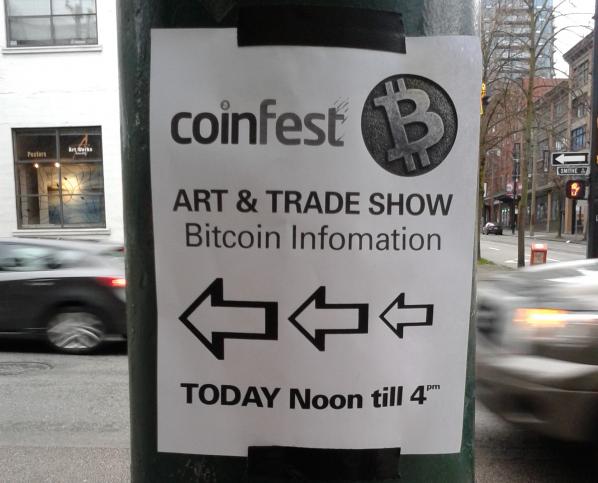
Coinfest 2014 in Vancouver featured examples of artists using Bitcoin. Buskers performing at the event could be tipped in Bitcoins, graffitti and mixed-media art being exhibited could be bought with Bitcoins. And in the computer lab at the venue each desktop PC displayed a piece of net art with a Bitcoin theme. This was the show “Computers and Capital”, curated by Erik H Rzepka and Wesley Yuen, also viewable online at http://x-o-x-o-x.com/press/computersandcapital/. It includes art depicting bitcoins, art visualizing wealth in terms of bitcoins, and work that evokes the operation of Bitcoin-like cryptocurrency.
thereisaprobleminaustralia’s “Bitcoin Garden” is an html5 alife pond populated by shoals of rippled and faded Bitcoin logos. It’s reminiscent of 90s Director alife, and might benefit from more of that algorithmicity. But as a post-internet tumblr assemblage it’s irresistibly calming and ironic. Bitcoin’s promise of a financial artificial paradise rendered organic, or hydraulic models of the economy leaking into the network.
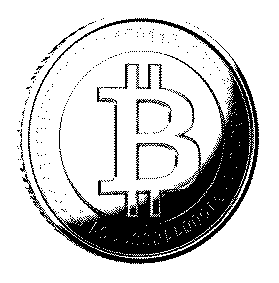
Jon Cates’s “817C01N” is a stark monochrome Floyd–Steinberg dither (an algorithm used on early Macintosh computers to convert colour or greyscale images to binary) animation of a broken iPhone spinning in front of a glitching animation “bitcrushed” from Manuel Fernandez’s “Broken Phone Gradients”. Networked art for a networked currency, it’s a clean, minimalist look afforded by a historical best-of-breed algorithm, an aesthetically and conceptually satisfying digital classicism. And it’s for sale in exchange for Bitcoins.
Ellectra Radikal’s “E.Rad Coin” is a Vasarely-meets-Twister undulating grid of distorted and colour gradient coin shapes. It’s the aesthetic equivalent of Bitcoin’s ethics: the market economic view of society as Conway’s Life with pennies given a post-digital twist.
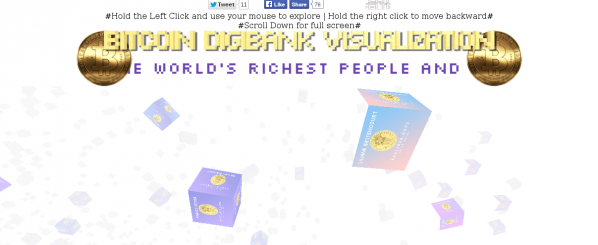
FELT’s “Bitcoin Digibank Visualization” is a financial hyperspace of cubes showing the value of the world’s rich quantified in Bitcoins floating in an endless whiteness. This shows both Bitcoin’s status as a separate economic plane and the ability of existing capital to colonize any resource-based attempt to escape its reach.
Giselle Zatonyl’s “Pop Coinfalls” is a video loop of analogue noise and digital compression glitched falling and stacking coins with a PowerPoint-hell upward graph line animated over them. Blink and you’ll miss it but there are faces on or reflected in the gold of the (Bit)coins as they pile up ever higher. The economy is like that.
Matt Tecson’s “lel buttcoin” is a tumblr blog zoom (an impressive subversion of the vertical scroll bar) of found imagery mostly on the theme of “buttcoins”, a common pejorative for Bitcoins. Coiyes, Bartcoins, and Radeon graphics cards intrude, presumably as they matched the search used to find buttcoin images.
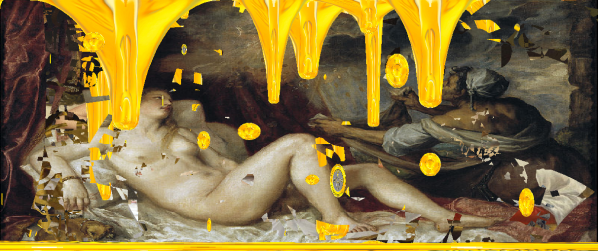
Roger Grandlapin’s “Danaë” is a Flash animation of Bitcoins dripping like honey over animated negative-space text, a porny neoclassical nude of the title and other imagery that I’m not fast enough to make out. Bitcoin’s origin story is related to those of older mythology as a shower of golden rain from Satoshi Nakamoto.
Kutay Cengil’s “Untitled” is a slightly glitched, default material rendered bust of a webcam-foreheaded, PayPal security-badged, melting financial mandarin. This is what Bitcoin is here to save us from, although in a recent interview the CEO of PayPal had more faith in Boitcoin than in NFC.
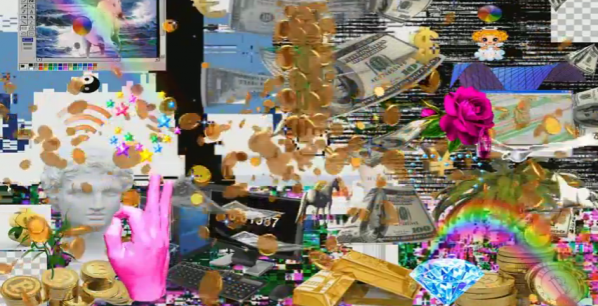
Systaime’s “Bitcoin Abundance” is a highly compressed YouTube video loop of the dross of 90s PC video clips surrounding a rain of bitcoins. It’s the opposite of Jon Cates’ piece. Visual Vaporwave, the kind of transubstantiation of kitsch that art is meant to do. It’s a formally rich composition, amusing and affecting. But even when I remove my cybercultural and net art historical horses from this race I’m left with the problem that it’s not clear how this aesthetic can fail.
Devon Hatto’s “letsnetworth” is another tumblr, this time of animated GIFs of compositions of that symbol of knowledge (and fashionable digital design), the apple. Digitisation, sustenance and symbolism combine here much as they do in Bitcoin. The net wealth of wealth on the net.
Adam Braffman’s “$$ULOGY” is a YouTube video of Dogecoins (the inflationary, Meme-mascoted rival to Bitcoins), Super Mario Bros gameplay, burning dollars and other found video imagery, with a brief visit from MST3K and a cheesy industrial and soft rock soundtrack interleaved with an echoing apocalyptic economic lecture. Its an impressionistic take on cryptocurrency and the environment in which it exists.
Nicolas Koroloff’s “Green Impact” is an image of a pile of Eurocent coins with a single transparent green bead or BB pellet in the middle. This is a reference to Bitcoin’s of-touted environmental impact due to the electricity expended in mining. The comparison between this energy footprint and that of fiat currency ATMs, chip and pin readers, and other elements of the global banking system probably compares to the relationship depicted here.
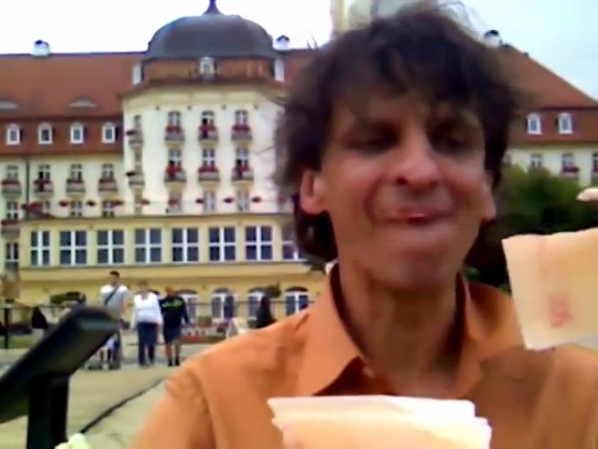
Dominik Podsiadly’s “I’ll eat any amount of EU subsidies” is a video performance of the artist smoking, drinking, and doing just that with some large edible 500 Euro notes. The Euro is a political instrument as much as a financial one, and its crisis has been another factor driving interest in alternative currencies, including Bitcoin.
Chimerik’s “Chimerikcoin” is a packed square graph puzzle that rearranges itself to fit as you drag rectangular fragments of an old gold coin around to reveal brief peaks of paper money. It’s the economy as a zero-sum game and Bitcoin as a digital return to the gold standard.
Miyö Van Stenis’s “Bitcoin Dreams” is an interactive html5 animation of settling Bitcoins in front of a cloudy sky and animated curtain. It’s an unusual and effective combination of tightly looped animation and interaction with a vaporwave aesthetic.
ASS Rain’s “Trees” is a collage of translucent green blocks dropped spillikins-style. I found it aesthetically and conceptually opaque, although a very effective composition.
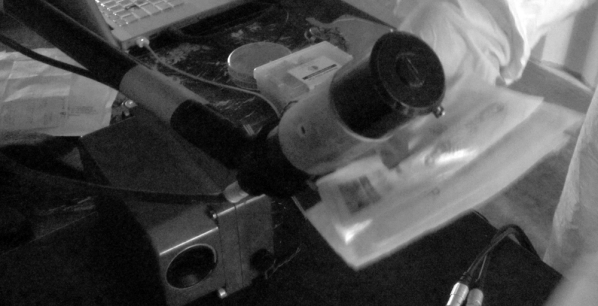
Robert B. Lisek’s “Quantum Enigma” uses a geiger counter to generate an encryption key for communication, ironically realising the promise of quantum crytography. It’s a historically and technically literate project that communicates a strong political stance while remaining technically and aesthetically interesting.
The ability to curate such a show online and present it as part of a wider cultural event marks a moment where the widespread availability of Internet access, Web 2.0 publication platforms, and computer labs at event and community spaces has transformed the possibilities for curating and contextualising digital art. “Computers and Capital” exploits these affordances very effectively. The recurrent themes, of pennies from heaven, ironic digital kitsch, glitchy compression artefacts, and potlatch, feel both appropriate and effective in visually communicating and critiquing the technical and social complexities of cryptocurrency in the age of austerity.
Bitcoin has caught the attention of the public, government, criminals, and artists. It is both an expression of the economic imaginary and a genuinely novel means of networked communication. This makes an unusual subject for art, whether celebratory or critical. Even the most ironic celebrations of Bitcoin in art are depictions of a network protocol, or a deflationary electronic currency. Whether visually and conceptually preparing us for a brave new world of cryptocurrencies or creating the illusory realm in which they will achieve their only lasting victory, Bitcoin art is very different from a Warhol dollar sign, a Hirst diamond skull, or the other symbolic band-aids for the ideological aporia of capital’s hollow victory. It is the art of a heresy rather than a hegemony, of a moment of technological, social and aesthetic possibility.
“Computers and Capital” very successfully captures this moment in art and makes it accessible in ways that thousands of words on the subject cannot. A thought-provoking, illuminating and often fun collection of work of a uniformly high standard that is nonetheless technically and aesthetically diverse can be presented online and off as part of a wider cultural event. “Computers and Capital” shows how network-enabled digital art can function as a bridge between complex and important ideas and the public imagination.
The text of this review is licenced under the Creative Commons BY-SA 4.0 Licence.
Featured image: PAH graphic resources
Over the last few years there has been a keen interest in discussing the notion of public space; demonstrations, camps, collaborative projects, artistic interventions, community projects, social activism are just a few names that exemplify the different forms of engagement that deal with the complexities of it. Despite their different aims and impact most of these actions have given evidence of the need to re-appropriate the public space; through collective and networked practices individuals, groups and organizations ‘challenge the conventional notion of public and the making of space’[1]. Although the liveness and even virality of these events, projects or actions hinder any prediction about its midterm effects or endurance, the fact is that there is an emerging legacy that is already dismantling certain assumed thoughts about ‘the public’.
The retiree Hüseyin Çetinel’s initiative of painting a public stairway with rainbow hues in his neighbourhood in Istanbul has been the last case involving cultural transformation, virality and social activism. After he painted the local stairs to ‘make people smile’ and ‘not as a form of activism’ the municipal cleaning service painted over the stairs in dull grey provoking a chain reaction that mobilized citizens to paint stairways throughout the city. Local communities and social movements appropriated this beautiful participatory action as a form of protest after Çetinel’s stairway became viral in the social media. This example shows the intricacies of the public space and its expanded performativity. As Gus Hosein Executive Director of Privacy International argues ‘there is a confusion as to what is public space is and how it relates to our personal and private space’ in a social context where the emergence of the use of social media and surveillance as well as the appropriations of the space by private corporations and social movements and individuals are constantly questioning its boundaries[2].
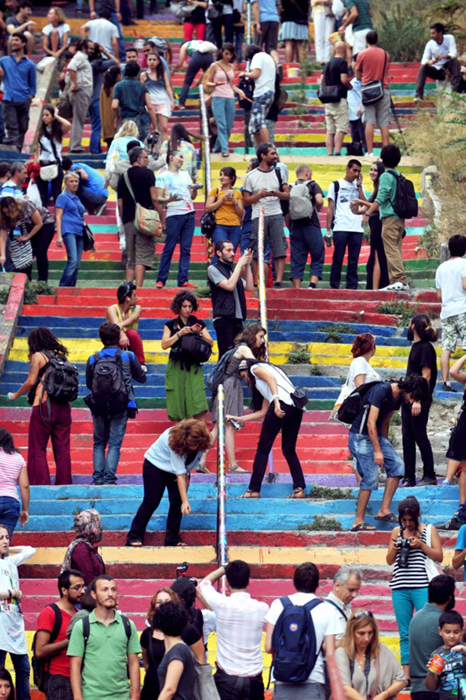
From my point of view, some of these actions that play in-between the social, political and artistic might be considered re-enactments of the public space as they aim to reconstruct the term itself by applying alternative procedures and by generating at the same time transductive pedagogies. However, in order to give a comprehensive understanding of the implications of the public space and its controversies it is essential to rethink the notion of the private space. Traditionally, home has been recognized as the physical private space; home is the main representative of the private sphere that encompasses the domestic and intimate. According to Joanne Hollows, ‘the distinction between the public and the private has been a key means of organizing both space and time’[3] and consequently to promote a clear functional division.
This traditional perspective has been questioned and altered due to some current issues and events that are noticeably interconnected with those of the public space; an increasing number of evictions and homeless peoples, housing policies, escraches[4] in front of the houses of politicians, the appearance of ghost neighbourhoods due to real estate speculation, home as an alternative space for performance practice and community development, among others. Thus, home might be conceived as a container of individuals and actions, as a social product or instrument, as topographical placement or as a relational structure. Home entangles interesting layers of analysis that might serve to establish new relational and yet responsive parameters to understand both the private and public space. Some of the following examples that perform between art, activism and affections corroborate the significance of home; as Blunt and Dowling state ‘home is not separated from public, political worlds but it constituted through them: the domestic is created through the extra-domestic and viceversa’[5].
In Barcelona, the city where I live there have been noticeable factors that have stressed the importance of home as a topic of interest. Probably the most significant case is the increasing number of evictions―over 350.000 in the last four years―as many families cannot afford their rent or mortgage after losing their jobs (the unemployment rate is 26.3%). Beyond the personal implications and devastating effects that evictions have on families, they also indicate that home is not anymore our secure space or refuge; on the contrary, if the individual does not respond to the production and consumption requirements is physically displaced to the streets. Consequently, many citizens are trying to find shelter back again in the public space.
If the 70s Richard Sennett announced the decay of the public space by the emergence of an ‘unbalanced personal life and empty public life’[6], the related problems with housing have provoked the reactivation of the public space at many levels. At the same time, there is an increasing culture of the debt that ties together individuals and financial institutions in long-term relationships. As Hardt and Negri explain ‘Being in debt is becoming today the general condition of social life. It is nearly impossible to live without incurring debts—a student loan for school, a mortgage for the house, a loan for the car, another for doctor bills, and so on. The social safety net has passed from a system of welfare to one of debtfare, as loans become the primary’ means to meet social needs’[7].
These ideas can be exemplified by the actions of PAH (The Platform of People Affected by Mortgage Debt), an activist group of citizens that stops evictions through demonstrations and guerrilla media actions in the streets and that also helps struggling borrowers to negotiate with banks and promotes social housing[8]. This organized group of citizens has been awarded this year the Citizen Award by the European Union for denouncing abusive clauses in the Spanish mortgage law and battling social exclusion. PAH has received the support of the collective Enmedio that generates actions in the midst of art, social activism and media. For example, their photographic campaign ‘We are not numbers’ consisted in the design of a collection of postcards each one containing a portrait of a person that was affected by the mortgage debt by a local bank entity. The postcards were delivered in front of the bank’s main building for people to write a message. The written postcards were then stuck in the front door main door turning numbers into a collage of human struggle. PAH and Enmedio actions become highly effective thanks to their media impact and their virality in the social media. Invisible individuals isolated in their struggle, find alternatives through an assemblage of support that connects the public and private space and that is also mediated by informative and constitutive tools that the virtual space offers. As Paolo Gerbaudo claims ‘social media have been chiefly responsible for the construction of a choreography of assembly as a process of symbolic construction of public space which facilitates and guides the physical assembling of highly dispersed and individualized constituency’[9].
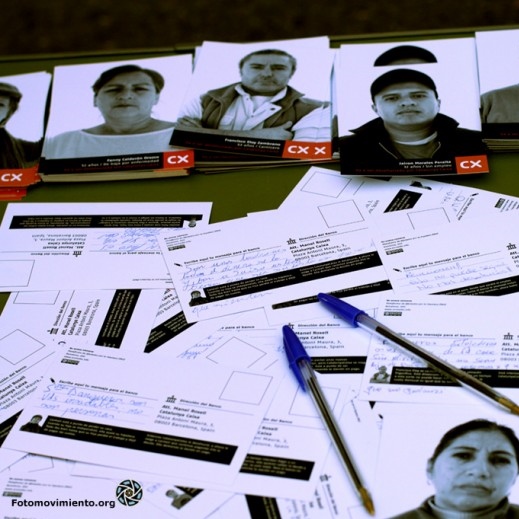
Processes of speculation, gentrification and eviction can be found in many western cities as well as different kinds of collectives and groups working for human rights advocacy. This is also the case of the Brooklyn based collective Not an Alternative has also carried out different guerrilla actions concerned with the problem of housing and eviction such as their series of workshops and media actions of ‘Occupy Real State’ or ‘Occupy Sandy’.
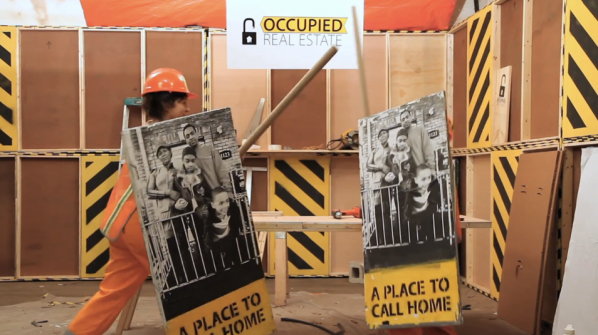
Many of the actions that these collectives promote might be understood as DIY activism as they are based on the empowerment and the development of skills. In this regard, it is interesting to observe how DIY that traditionally has been related to activities in the domestic space serves as a strategy to protect it and to trigger new forms of protest in the public space while enhancing the creation of an expanded family (or at least a sense of togetherness) through the social media.
Despite these actions, the public space is still home for many individuals. In the UK, different associations are concerned about the impact that the implementation of the bedroom tax might have, especially in London where the number of rough sleepers rises every year with an increase of the 62% since 2010-2011. The scenario is not different in many other European cities where beyond these worrying numbers there is also an increasing number of regulations and policies that difficult the life in the public space. As Suzannah Young stresses, ‘homeless people often need to use public space to survive, but are regularly driven off those spaces to satisfy commercial or even state interests’. Public space is often only open to ‘those who engage in permitted behaviour, frequently associated with consumption’[10]. The increasing number of quasi-public spaces―’spaces that are legally private but are a part of the public domain, such as shopping malls, campuses, sports grounds’ and so forth― questions again the boundaries of the private and public space, especially when ‘some EU cities use the criminal justice system to punish people living on the streets for doing things they do in order to survive, such as sleeping, eating and begging’[11]. All these policies have clear implications in the use of space and it is potential possibilities. The fact that the public space becomes home involves the reconsideration of the uses of the public space and the understanding of it through the eyes of the people that fully inhabit it. The London collective The SockMob run the Unseen Tours, alternative city tours guided by a group of homeless. Their embodied knowledge appears as a key aspect to develop these DIY versions of the city while promoting relationships between the homeless and the tour participants.
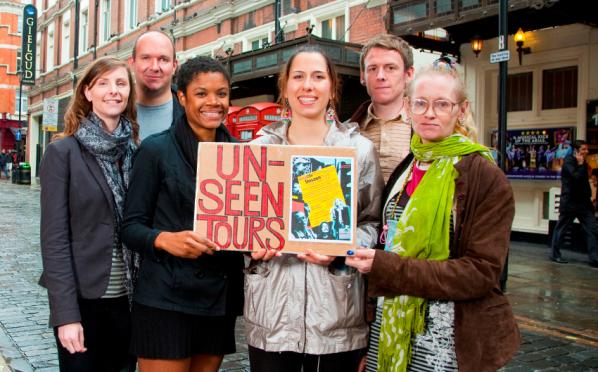
Where is home? In which ways access to spaces gives us opportunities and rights as individuals? In which ways all these site-specific initiatives that often have a transnational reach re-construct the notions of private and public space? How these DIY and media actions are generating new forms of visual arts activism? Despite the fact that these queries might need further analysis, I believe that the qualities of space becomes visible and tangible through these interactive and responsive actions with the spaces. Recently, an international group of activists, visual artists and scholars have published a handbook in which their consider these forms of activism militant research. According to them, ‘militant research involves participation by conviction, where researchers play a role in the actions and share the goals, strategies, and experience of their comrades because of their own committed beliefs and not simply because this conduct is an expedient way to get their data. The outcomes of the research are shaped in a way that can serve as a useful tool for the activist group, either to reflect on structure and process, or to assess the success of particular tactics’[12]. Hence, the idea of some hands-on, the acquisition of skills and the performance of theory appear as key aspects to disentangle and analyse the qualities of the space.
From an artistic perspective home has been crucial in many historical periods of dictatorship to construct an underground scene of the arts; in many of these cases, the evidence of artistic practice appears through testimonials and documentation (photographs, fanzines, recordings, etc.). Again different forms of media help to make the clandestine public, crossing the sphere of the private into the public realm. Thus, the importance of documentation enhances different temporalities of reception and impact in the public realm. In this regard, a differed presentation of the artistic works triggers a reconsideration of the attributes of the spaces too. Currently, homes serve as a basic space for artists to present their work; in the case of music, this is a widely known practice in the US that is becoming more and more common in other countries and other art forms. Homes serve as a personal curatorial space for fine arts artists through the open studio festivals too; artists make their private space open for others as a strategy to show their work publicly. At the same time, in some artistic disciplines self-curation through digital portfolios is becoming increasingly used to showcase artworks. One way or another, home remains often the main space for creativity, production and curation through and expanded DIY conception of their profession.
Home becomes even more crucial in a context marked by the arts cuts and the economic crisis. In this regard, there are initiatives that see an opportunity in the relationship between the public and private space not only to exhibit or perform art but also to trigger a counter-performative form of showing works. This is the case of the domestic festivals that try to challenge the concepts of cultural enterprise and institution by proposing home as a legitimate space of the artistic experience. Friends, neighbours and acquaintances offer a room or a space in their house for artists to perform there (examples can be found in different cities such as Santiago de Chile, Madrid, Berlin, Barcelona, etc.). At the same time, the format wishes to transform the spatial and affective relationships that citizens have with the space, by inverting the spatial dichotomy between the public and the private. Hence, the idea goes beyond to a practical solution to have a space to perform as it also aims to give visibility to performing practices that have not been yet legitimized by the public sphere and they are in danger to remain in a sort of clandestinity (as they are not part of the current cultural market). In this regard, there is also a sense of evicted or homeless art that is trying to produce a social context of experience and articulation beyond the immediate effects of the power that governs at many level the public sphere. These kinds of initiatives generate ‘an activity that undermines the exclusion by letting occur, at the very boundary which separates the public from the “secret”’, an articulation which challenges the prevailing framework of representation and legitimation’[14].
The intersection between art, activism and affections help to explain the multiple and complex questions that configure the notion of home. With these examples I just wanted to stress the importance of home in the discourses that address the concepts of public space/public sphere/publicly. Thus homes ‘are thereby metaphorical gateways to geopolitical contestation that may simultaneously signify the nation, the neighbourhood or just one’s streets’[15]. From a transnational perspective, home seems to pose the crucial questions that connect us with what is happening inside, outside and in-between the spaces and gives us a different perspective to analyse current artistic and social practices that engage with our mode of action, production and identity.
I guess this is all from my home.
Curated by Rosa Menkman & Furtherfield.
Opening Event: Saturday 8 June 2013, 2-5pm
with Glitch Performance by Antonio Roberts at 3pm
Open Friday to Sunday 11-5pmContact: info@furtherfield.org
DOWNLOAD PRESS RELEASE
IMAGES OF THE OPENING ON FLICKR
READ Glitch as a Symbolic Art Form BY ROB MYERS
WATCH VIDEO OF THE OPENING
“The glitch makes the computer itself suddenly appear unconventionally deep, in contrast to the more banal, predictable surface-level behaviours of ‘normal’ machines and systems. In this way, glitches announce a crazy and dangerous kind of moment(um) instantiated and dictated by the machine itself.” Rosa Menkman [1]
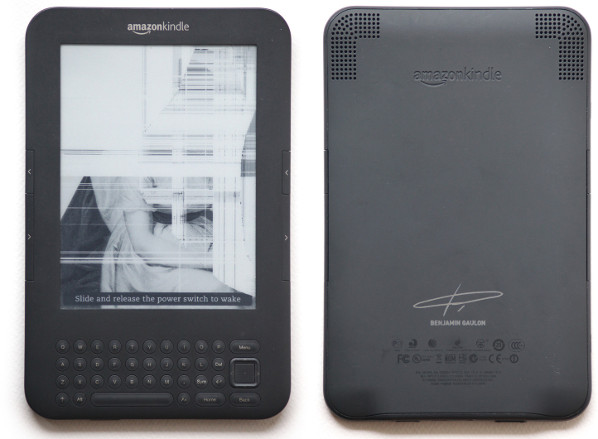
Glitches are commonly understood as malfunctions, bugs or sudden disruptions to the normal running of machine hardware and computer networks. Artists have been tweaking these technologies to deliberately produce glitches that generate new meanings and forms. The high-speed networks of creation and distribution across the Internet have provided the perfect compost to feed this international craze. The exhibition shows various approaches by artists hacking familiar hardware and their devices which include mobile phones, and kindles. They disrupt both the softwares and the digital artefacts produced by these softwares, whether it be in the form of video, sound and woven glitch textiles.
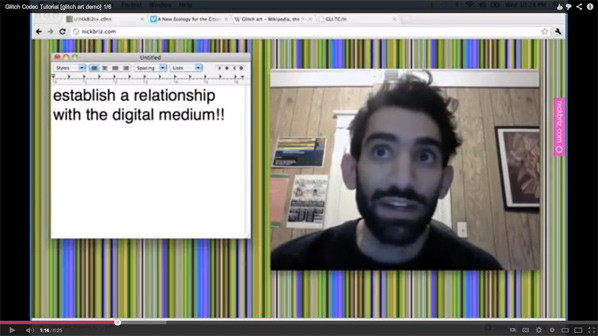
Glitch art subverts the way in which we are supposed to relate to technology, causing playful, imaginative disruptions. It is a low-tech and dirty media approach with a punk attitude. These artists appropriate the medium and forge expressions that go beyond what the mainstream art world expects artists to do, it is unstoppable – it is Glitch Moment/ums.
Copies of Rosa Menkman’s groundbreaking Glitch Art critique The Glitch Moment(um) will be available for purchase during the exhibition.
![numbermunchers from the untitled [screencaptures] series by Melissa Barron](http://www.furtherfield.org/wp-content/uploads/2013/04/melissabarton.jpg)
Empty Spinning Circle become Full (part b) (2012) from the Further Abstract series by Alma Alloro
One Square in colors (2012) from the Further Abstract series by Alma Alloro
untitled [screencaptures] (2010) by Melissa Barron
The Glitch Codec Tutorial by Nick Briz
KindleGlitched (2012) by Benjamin Gaulon
Thoreau Glitch Portrait (2011) by José Irion Neto
Copyright Atrophy (2013) by Antonio Roberts
What Revolution? (2011) by Antonio Roberts
Beyond Yes and No (2013) by Ant Scott
Glitch artists and enthusiasts are invited to add their work to GLI.TC/H 0p3nr3p0.net, a Glitch Art repository coded by and developed by Joseph ‘Yølk’ Chiocchi & Nick Briz. The submissions will be showcased during Glitch Moment/ums at Furtherfield Gallery. To include your work in the 0P3NR3P0 component of Glitch Moment/ums submit a link to any visually wwweb based file (html, jpg, gif, youtube, vimeo, etc.) and your piece will automatically be included in the line-up (one work per artist).
This new IRL exhibition has been organised in collaboration with Nick Briz and Joseph ‘Yølk’ Chiocchi.
SUBMIT && SHOW on 0P3NR3P0.NET.
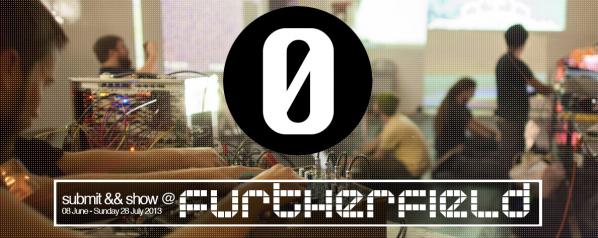
Alma Alloro
Alma Alloro (IL) is an artist, musician and performer from Tel Aviv. She is rooted in the backyard of popular culture using diversified media from drawing, installation, music, and animation to internet; her recent works focus on the correlation between old media and new media.
Melissa Barron
Melissa Barron is an artist living and working in Minneapolis, Minnesota. She studied at the School of the Art Institute of Chicago where she focused on new media and fiber. In her work she combines these two fields by reinterpreting hacked Apple 2 software through different fiber techniques. Her work has been shown at various international events, including the Notacon hack festival in Cleveland, Ohio, GLI.TC/H in Chicago and ISEA 2011 in Instabul.
Nick Briz
Nick Briz is a newmedia artist, educator and organiser based in Chicago IL. His work has been shown internationally at festivals and institutions, including the FILE Media Arts Festival (Rio de Janeiro, BR); Miami Art Basel; the Images Festival (Toronto, CA) and the Museum of Moving Image (NYC). He has lectured and organized events at numerous institutions including STEIM (Amsterdam, NL), the Museum of Contemporary Art Chicago, Marwen Foundation and the School of the Art Institute of Chicago. His work is distributed through Video Out Distribution (Vancouver, CA) as well as openly and freely on the web.
Benjamin Gaulon
Benjamin Gaulon is an artist, researcher and art college lecturer. He has previously released work under the name “Recyclism”. His research focuses on the limits and failures of information and communication technologies; planned obsolescence, consumerism and disposable society; ownership and privacy; through the exploration of détournement, hacking and recycling. His projects can be softwares, installations, pieces of hardware, web based projects, interactive works and are, when applicable, open source.
José Irion Neto
José Irion Neto is native of Santa Maria, in southern Brazil. His first contact with computers was in 1982 using a machine equivalent to Sinclair ZX Spectrum. He has an academic background in Media Advertising and worked for some years as a Graphic Designer. Today, he has been working with advertising only occasionally, focusing on creating posters, dedicating most of his time on developing Glitch Art. He has worked and researched Glitch since 2008.
Antonio Roberts
Antonio Roberts is a British digital artist whose artwork focuses on the errors and glitches generated by digital technology. Many people would simply discard such artefacts but Antonio preserves these errors and displays them as art. With his roots in free culture he develops his techniques using open source and freely available software and shares his knowledge through the development of software.
Ant Scott
Ant Scott (UK) is a glitch artist and co-author of the first glitch aesthetics coffee table book Glitch: Designing Imperfection (New York: MBP, 2009). His work is informed by cognitive distortions.
Rosa Menkman
Rosa Menkman is a Dutch visualist who focuses on visual artifacts created by accidents in digital media. The visuals she makes are the result of glitches, compressions, feedback and other forms of noise. By combining both her practical as well as an academic background, she merges her abstract pieces within a grand theory artifacts (a glitch studies), in which she strives for new forms of conceptual synthesis of the two. In 2011 Rosa wrote Glitch Moment/um, a notebook on the exploitation and popularization of glitch artifacts (published by the Institute of Network Cultures), organized the GLI.TC/H festivals in both Chicago and Amsterdam and co-curated the Aesthetics Symposium of Transmediale 2012.
Furtherfield Gallery
McKenzie Pavilion, Finsbury Park
London N4 2NQ
T: +44 (0)20 8802 2827
E: info@furtherfield.org
Furtherfield Gallery is supported by Haringey Council and Arts Council England
Scratch is a programming environment that is easy to use and created with children in mind. Create and share your own interactive stories, games, music and art!
MaKey MaKey is a kit that lets you turn anything into a controller. Let your imagination go wild!
Codasign in partnership with Furtherfield will be running two Scratch + MaKey MaKey workshops for children and their parents at Furtherfield Gallery on Sunday 14 April: a morning session with 6-9 year olds (10-12pm) and an afternoon one with 9-12 year olds (1:30-4pm).
Please book your place.
All supporting material for the workshop will be available at learning.codasign.com.
During this workshop, the children will practice using computational thinking and interactive design in creative projects through a variety of activities. The adults will even play a key role in these activities.
You only need to have big ideas – no other experience required.
You need to bring a laptop and an adult. The same adult can accompany multiple children. If you aren’t able to bring a laptop, just let us know by adding a note to your registration or e-mailing info@codasign.com.
There will be drinks available, but you are welcome to bring along some snacks to feed your creativity.
Full refund if registration is cancelled over a week before the course start, 50% if within a week of the course start, and no refund if within 24 hours of the course start.
VISITING INFO
Furtherfield Gallery
McKenzie Pavilion
Finsbury Park, London, N4 2NQ
Scratch is a programming environment that is easy to use and created with children in mind. Create and share your own interactive stories, games, music and art!
MaKey MaKey is a kit that lets you turn anything into a controller. Let your imagination go wild!
Codasign in partnership with Furtherfield will be running two Scratch + MaKey MaKey weekend workshops for children and their parents at Furtherfield Gallery on Saturday 16 and Sunday 17 March: a morning session with 6-9 year olds (10-12pm) and an afternoon one with 9-12 year olds (1:30-4pm).
Please book your place.
All supporting material for the workshop will be available at learning.codasign.com.
During this workshop, the children will practice using computational thinking and interactive design in creative projects through a variety of activities. The adults will even play a key role in these activities.
You only need to have big ideas – no other experience required.
You need to bring a laptop and an adult. The same adult can accompany multiple children. If you aren’t able to bring a laptop, just let us know by adding a note to your registration or e-mailing info@codasign.com.
There will be drinks available, but you are welcome to bring along some snacks to feed your creativity.
Full refund if registration is cancelled over a week before the course start, 50% if within a week of the course start, and no refund if within 24 hours of the course start.
VISITING INFO
Furtherfield Gallery
McKenzie Pavilion
Finsbury Park, London, N4 2NQ
Scratch is a programming environment that is easy to use and created with children in mind. Create and share your own interactive stories, games, music and art!
Codasign in partnership with Furtherfield will be running two Scratch weekend workshops for children and their parents at Furtherfield Gallery on Saturday 09 and Sunday 10 March: a morning session with 6-9 year olds (10-12pm) and an afternoon one with 9-12 year olds (1:30-4pm).
Please book your place.
All supporting material for the workshop will be available at learning.codasign.com.
What will you do and learn?
You will design and make a game or animation using the Scratch environment.
What do you need to already know?
You only need to have big ideas – no other experience required.
What do you need to bring?
You need to bring a laptop and an adult. The same adult can accompany multiple children. If you aren’t able to bring a laptop, just let us know by adding a note to your registration or e-mailing info@codasign.com.
What will be available during the workshop?
There will be drinks available, but you are welcome to bring along some snacks to feed your creativity.
Cancellation Policy
Full refund if registration is cancelled over a week before the course start, 50% if within a week of the course start, and no refund if within 24 hours of the course start.
VISITING INFO
Furtherfield Gallery
McKenzie Pavilion
Finsbury Park, London, N4 2NQ
Scratch is a programming environment that is easy to use and created with children in mind. Create and share your own interactive stories, games, music and art!
MaKey MaKey is a kit that lets you turn anything into a controller. Let your imagination go wild!
Codasign in partnership with Furtherfield will be running two Scratch + MaKey MaKey workshops for children and their parents at Furtherfield Gallery on Saturday 23 February: a morning session with 6-9 year olds (10-12pm) and an afternoon one with 9-12 year olds (1-4pm).
Please book your place.
All supporting material for the workshop will be available at learning.codasign.com.
What will you do and learn?
During this workshop, the children will practice using computational thinking and interactive design in creative projects through a variety of activities. The adults will even play a key role in these activities.
What do you need to already know?
You only need to have big ideas – no other experience required.
What do you need to bring?
You need to bring a laptop and an adult. The same adult can accompany multiple children. If you aren’t able to bring a laptop, just let us know by adding a note to your registration or e-mailing info@codasign.com.
What will be available during the workshop?
There will be drinks available, but you are welcome to bring along some snacks to feed your creativity.
Cancellation Policy
Full refund if registration is cancelled over a week before the course start, 50% if within a week of the course start, and no refund if within 24 hours of the course start.
VISITING INFO
Furtherfield Gallery
McKenzie Pavilion
Finsbury Park, London, N4 2NQ
MaKey MaKey is a kit that lets you turn anything into a controller. Let your imagination go wild!
Codasign in partnership with Furtherfield will be running two MaKey MaKey workshops for children and their parents at Furtherfield Gallery on Saturday 16 February: a morning session with 6-9 year olds (10-12pm) and an afternoon one with 9-12 year olds (1-4pm).
All supporting material for the workshop will be available at learning.codasign.com.
What will you do and learn?
During this workshop, the children will practice using computational thinking and interactive design through a variety of activities.
What do you need to already know?
You only need to have big ideas – no other experience required.
What do you need to bring?
You need to bring a laptop and an adult. The same adult can accompany multiple children. If you aren’t able to bring a laptop, just let us know by adding a note to your registration or e-mailing info@codasign.com.
What will be available during the workshop?
There will be drinks available, but you are welcome to bring along some snacks to feed your creativity.
Cancellation Policy
Full refund if registration is cancelled over a week before the course start, 50% if within a week of the course start, and no refund if within 24 hours of the course start.
VISITING INFO
Furtherfield Gallery
McKenzie Pavilion
Finsbury Park, London, N4 2NQ
Scratch is a programming environment that is easy to use and created with children in mind. Create and share your own interactive stories, games, music and art!
Codasign in partnership with Furtherfield will be running two Scratch workshops for children and their parents at Furtherfield Gallery on Saturday 09 February: a morning session with 6-9 year olds (10-12pm) and an afternoon one with 9-12 year olds (1-4pm).
Please book your place.
All supporting material for the workshop will be available at learning.codasign.com.
What will you do and learn?
You will design and make a game or animation using the Scratch environment.
What do you need to already know?
You only need to have big ideas – no other experience required.
What do you need to bring?
You need to bring a laptop and an adult. The same adult can accompany multiple children. If you aren’t able to bring a laptop, just let us know by adding a note to your registration or e-mailing info@codasign.com.
What will be available during the workshop?
There will be drinks available, but you are welcome to bring along some snacks to feed your creativity.
Cancellation Policy
Full refund if registration is cancelled over a week before the course start, 50% if within a week of the course start, and no refund if within 24 hours of the course start.
VISITING INFO
Furtherfield Gallery
McKenzie Pavilion
Finsbury Park, London, N4 2NQ
THE CRYSTAL WORLD
The White Building, London
3 August – 30 August 2012
The Space’s White Building cultural centre is within walking distance of the 2012 Olympic stadium in post-industrial, post-regeneration London. As I walked down the steps that lead to it I saw a diesel locomotive pulling a train of cargo containers across an old railway bridge over the canal nearby. Millions of these rational forms will be in transit around the world at any given moment, arranged in two or three dimensions like crystalised capital on trains and docks and ships.
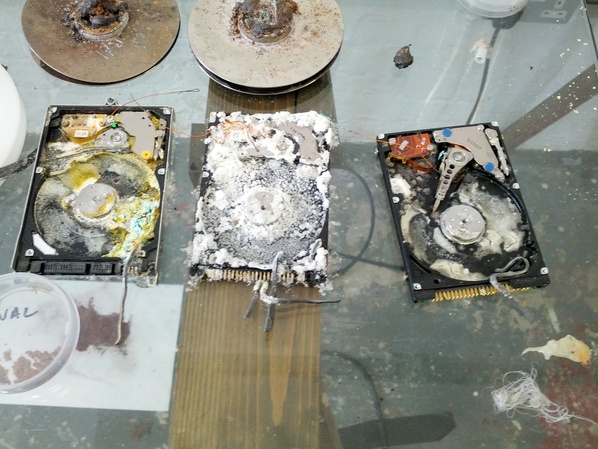
The logistics of their production and distribution are determined by computing machinery using algorithms that operate with inhuman speed and complexity. This same economic logic warps the architecture of the area around The White Building, with old factories and warehouses retro-fitted as office space and as gallery space.
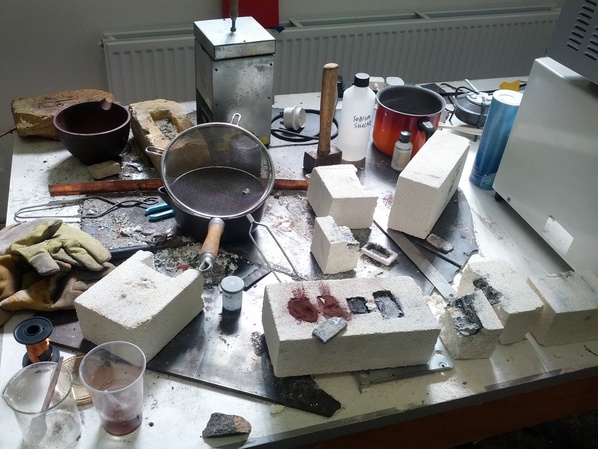
Inside the White Building’s project space the computational enabling technology of the global economy is the subject of a show by Martin Howse, Ryan Jordan and Jonathan Kemp. It takes the title of J. G. Ballard’s novel “The Crystal World” as its starting point. In Ballard’s novel a virus progressively turns all life – vegetable, animal and human – into crystal forms frozen in time. It is a Cold War allegory of the catastrophic imposition of rigid order.
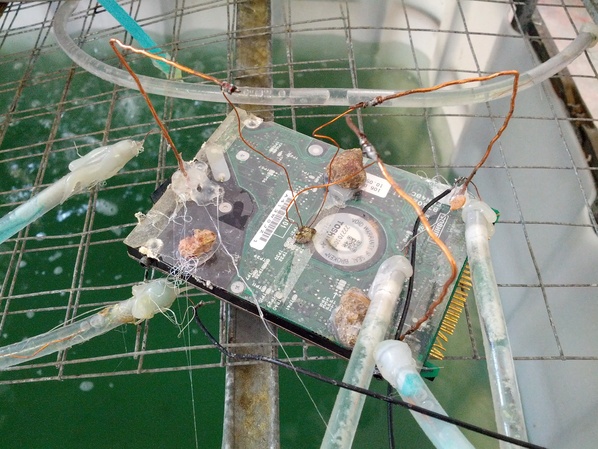
For Howse, Jordan and Kemp these imaginary crystals become the very real minerals refined in the production of the computing machinery used to structure our contemporary world. Inside every digital computer are wires, circuit boards, integrated circuits and other components. They are made from iron, copper, phosphorous, boron, tantalum and other rare earth elements. The central processing unit of a computer keeps time using a quartz crystal. The products of deep geological time are suddenly unearthed and set to pulsating millions of times a second.
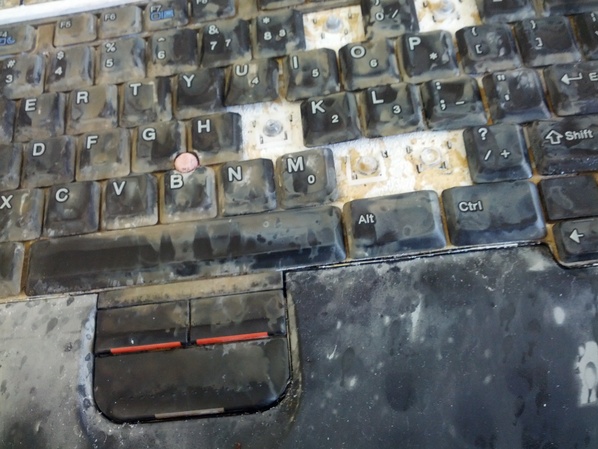
Computers are crystal engines. They are mineral fetishes that we use to manipulate powerful unseen forces that we believe we have mastered, like crystal healers working with a patient’s energy grid. But they are so invisibly familiar to us as our smartphones and laptops and their use in logistics and media is so pervasive that it takes an effort for us to perceive their operation or their implications.
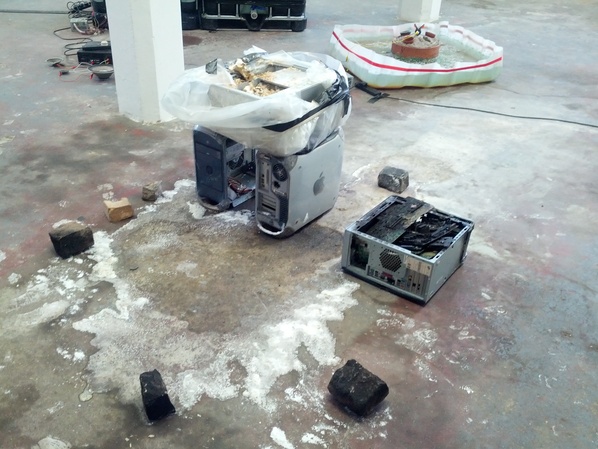
It takes almost two tonnes of raw materials to make a desktop PC. Unlike “Tantalum Memorial” (2008), by Harwood, Wright and Yokokoji, “The Crystal World” focuses on these raw materials geologically and temporally rather than geopolitically. But computing waste is toxic and valuable. The former makes disposing of old computers a growing problem, the latter makes recycling old computers a growing business. The minerals that computers contain can be recycled where they are valuable enough, or left to leach into the water supply in e-waste dumps where they are not.
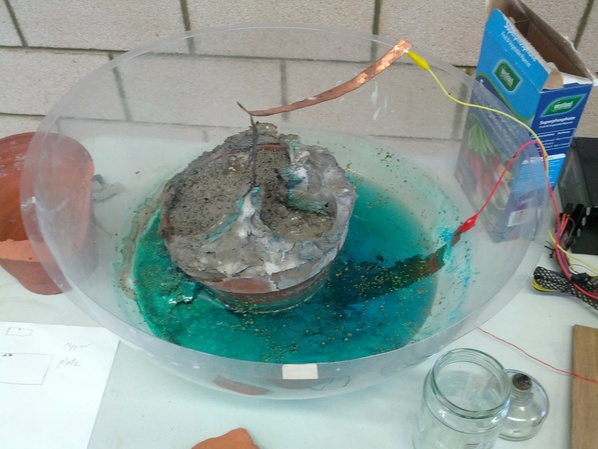
Or in the case of “The Crystal World” an open laboratory and the resultant art installation can re-extract them from their components and printed circuit boards using acid, water, electricity and heat in order to re-crystalise them and return them to geological time. The gleaming silent boxes that organize and mediate our lives are returned if not to the earth from whence they came then at least to their raw materials.
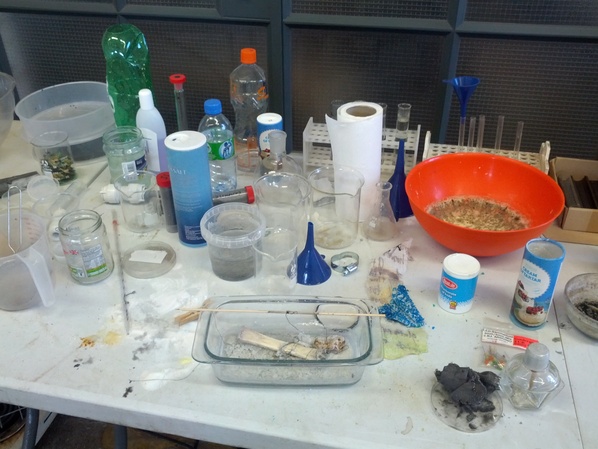
Tables edge the White Building project space, covered with the equipment and results of five days of workshops (and one with books, including Ballard’s, giving any spectators unsure of what is happening a conceptual framework to proceed from). Table after table of crystals, circuit boards, jars, electical equipment, and wires are overwhelming in the details of their appearance and implication. These traces of human activity and inquiry frame the flow of water and electricity in the center of the space, convincing the viewer of the creative intent of its production and drawing them in to its logical universe.
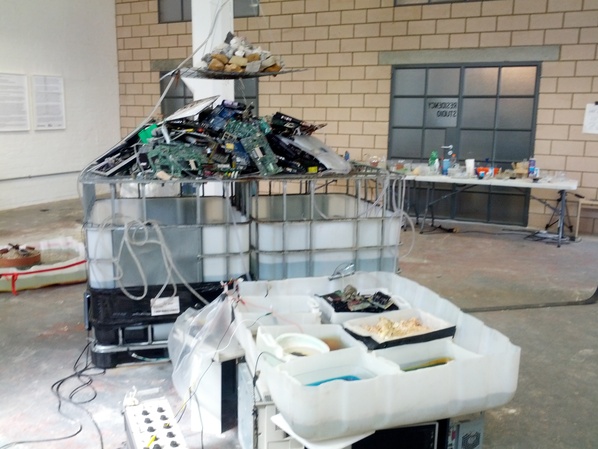
The centre piece of the show is a favela chic water feature that drips acid-loaded water through calcinous rock fragments, over e-waste, into two cut plastic-drum tanks. Next to it an array of smaller plastic containers contain circtuit boards having their copper leeched from them by acid, fungus growing on the by-prodcucts of the project, and other watery deconstructions of computing machinery. It looks dangerous and uncertain, deconstructing both the physicality and the meaning of computers. Seeing the innards of an IBM ThinkPad computer becoming encrusted with calcium like a digital stalagtite, or CPUs branching feathery crystals, returns computing machinery to its raw mineral state. FLOPS give way to eons once more. Neither is a human timescale, yet we must live between them at the moment.

The most fantastical artifact along the walls of the project space is the “Earth Computer”. It’s a battery-like construct of recycled copper and zinc in a tray of silver nitrate attached to lightning conductor-style copper strips. Sitting in earth on a plastic sheet and surrounded by the left-over materials of its creation for the duration of the show, it will be buried nearby afterward. Such a device can function effectively, but not literally. It is more likely to spring to life in the mind of the viewer than if it is struck by lightning. It is effective art, psychic engineering rather than technological cargo culting.
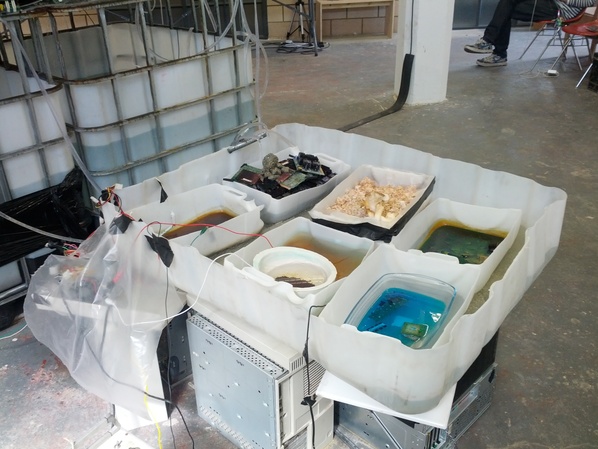
Acid, water and electricity mixed together with e-waste look and feel dangerous. The recycled ad-hoc materials and equipment containing and channeling them reinforce this feel and leaven it with an aura of creative investigation. The form of the show is timeless, the workshop of the alchemist, outsider scientist, or mad inventor. Its content is very contemporary, from Ballard’s rising cultural stock and the social and environmental costs of e-waste to Long Now deep time and posthuman philosophy. Art symbolically resolves the gaps between ideology and reality, and computing is so pervasive and key to society that most people don’t even regard it as ideological never mind conceptualise its failings as such.
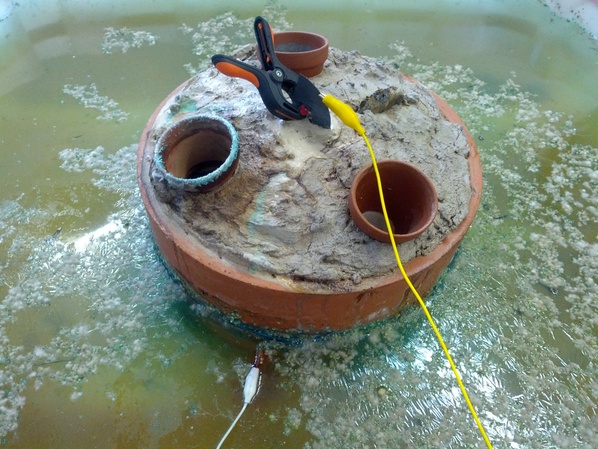
The water and abandoned human artefacts of some of the installations is more “Drowned World” than “Crystal World”, and the broken machinery is more “Crash”. Ballard’s catastrophes provide a modern mythology that is a more useful resource for art than its literary roots might suggest. It achieves the defamiliarising and critical impact of hauntological art without requiring its supernaturalism or nostalgia. There is a Ballardian attitude at play here.
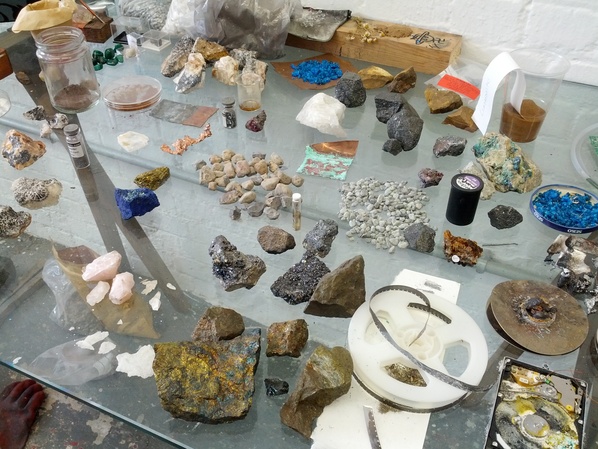
I found “The Crystal World” mind-blowing. It relates the tools of our human existence to non-human substances and timescales, providing the kind of corrective to anthropocentric vanity that object-oriented philosophy aspires to. It achieves this profound insight and presents it in an accessible way precisely because of the modesty of its materials and aesthetics, and because of the resonances of the cultural materials chosen as its starting point.
http://spacestudios.org.uk/whats-on/events/the-crystal-world-open-laboratory-exhibition-
The text of this review is licenced under the Creative Commons BY-SA 3.0 Licence.
Featured image: Jon Satrom (left) and jonCates at Intuit, Sept. 20, 2012 (right). image: Shawne Michaelain Holloway
Post-Static: Realtime Performances by jonCates and Jon Satrom @ Intuit, the Center for Intuitive and Outsider Art (Chicago). September 20, 2012. Programmed by Christy LeMaster
“Alchemy; the science of understanding the structure of matter, breaking it down, then reconstructing it as something else. It can even make gold from lead. But Alchemy is a science, so it must follow the natural laws: To create, something of equal value must be lost. This is the principle of Equivalent Exchange. But on that night, I learned the value of some things can’t be measured on a simple scale.”[1]
In 1966, Bell Laboratories scientists and engineers collaborated with artists to construct several performance-based installations under the title 9 Evenings: Theatre & Engineering. Works included Variations VII by John Cage and performance engineer Cecil Coker, in which a sound system pulled sounds from radio, telephone lines, microphones and musical instruments, and Carriage Discreteness by Yvonne Rainer and performance engineer Per Biorn, a dance event controlled by walkie-talkie and TEEM (theatre electronic environment modular system). Critic Lucy Lippard was wrote that the event was filled with technical problems and that the artists involved allowed the technology to take precedence over the art. She pointed out that no theatre people took part in the event and suggested that while this event did not offer a specific design for a new approach to theatre, it revealed the possibility that new approaches to theatre might be born from the combination of art and technology:
A new theater might well begin as a non-verbal phenomenon and work back towards words from a different angle. Departing from Samuel Beckett’s highly verbal, single-image emphasis, it could move into an area of perceptual experience alone, its tools a more primitive use of sight and non-linguistic sound. Such a theater would not necessarily be the amorphous carnival of psychedelic fame but could be as rigorously controlled as any other.[2]
She also observed that it was often impossible to understand the relationship between the technology and the events it triggered without reading the program, mentioning one such missed connection in Open Score, by Robert Rauschenberg and performance engineer Jim McGee. In this piece, tennis rackets were wired such that each impact of the ball on a racket turned off one light in the performance hall. Lippard wrote that this connection was not noticeable and thus the conceptual framework of the piece was lost to the audience.
To artists working at the intersection of art and technology more than forty years after this event, it is disturbing to note that the same issues Lippard pointed out —the subjugation of concept to technology, the failure of the technology itself and the lack of a radical approach to the intersection— are still all too present in many works taking place in the worlds of new media art [3]
. None of these were issues for jonCates or Jon Satrom as each presented a performance intersecting with the exhibition “Ex-Static: George Kagan’s Radios” at Intuit, the Center for Intuitive and Outsider Art in Chicago, IL. Their performances serve as examples of new media employed as a tactic in support of art rather than “new media art” as a condition represented by infatuation with expensive devices. Instead of yet another demo of “cool” tech, the audience experienced a rigorously controlled blast of chaos.
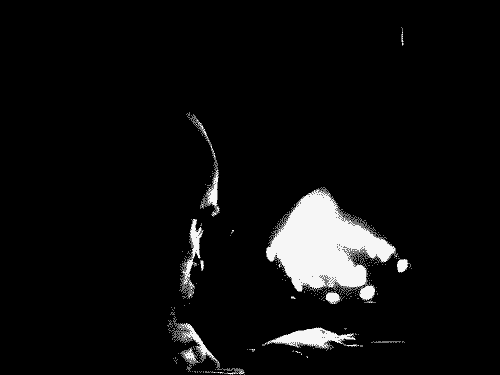
The lights go down completely and we are illuminated by a large amorphous video projection behind a table stacked with equipment. The video is black and white as is the video monitor facing us from the table. jonCates moves between the back and front of the table, with purpose. While the equipment stack is familiar, multiple mixers and cases, this is no DJ set. Much closer is the image of a few men in long sleeves and ties tending to tables full of equipment for John Cage’s “Variations VII”. With several nondescript devices on and adjusted, the air around us has become alive with a noisy drone that, by this date and to this audience, is very familiar (parallels extend back to sonic attacks from Peter Christopherson and Chris Carter with Throbbing Gristle) but now the sound is comforting, an aural field that is neither alien nor distracting.
A droning, machine sound, or the droning machine sound, has become a ridiculously common element of a contemporary “experimental” sound and video work. It is thus all the more surprising to be instantly drawn into jonCates’ audio, to take pleasure in it and to lose track of time completely. We are watching him control the mixer and occasionally speak into the microphone that is set in front of a conspicuous security camera. Again, jonCates uses the most expected situation —the camera faces upward toward the video projection screen, creating a counter-clockwise tilting feedback loop. And again, we are not distracted by this, it is familiar yet beautifully framed and we are drawn in. We have been invited to a field constructed by a tactician expertly employing simple situations.
The raw quality of both the droning audio and the feedback loop combine with jonCates’ humble appearance to remove the expectation of a spectacle and we return to the real situation with questions: who is this man and what is he going to do? He keeps speaking into the microphone, his eyes look desperate, and, despite seeing him perform a similar (although much less engaging) performance at the 2011 Gli.tc/h festival, we are surprised as we realize, as it is nearly two-thirds complete, what he is doing: giving a lecture.
jonCates has been speaking for some time but only a few echoed fragments are reaching out beyond the drone. It has been an incantation without purpose, a repetition of the meaningless words one says when one is presenting something to an audience. Finally, jonCates drops the distortion and the volume on the droning sound and his voice becomes clearer. It is obvious that some communication is going to happen and everyone shifts slightly as we strain to remember how to listen to a voice. Are we here to see another performance or hear something important?. The voice is not strong and it has no authority. It is perfectly ordinary, slightly academic with a hint of vulnerability. It’s the voice of a mad scientist who has begun to understand that his experiments may be his undoing. At this point the piece could collapse and jonCates has not propped himself up with his technology. Instead, he’s used it to lead us to key moments and obliterating everything else. Still, he seems not so much frightened as curious to see where this will end, if what he needs to say can be given a short lifespan in this space. This is where performance lives —in the unfolding present. And jonCates says:
“…and I thought [?] … I thought [?] about how I should remix something in realtime for you that I should reflect upon the past, I should reflect upon [?] …patterns so I thought that I should probably do this as a remix and render it in realtime for you but then I found … from 1997…and it was sitting right next to the first tape … it was sitting right next to the first tape, had the same title as the first one, that also said “Flow” and right next to it had another a label that said “Remix” and I thought ‘I already made that piece’ [sampled voice droning: ‘oceanic waves upon waves upon waves upon waves’] and that’s almost too good to be true so I put the tape called ‘remix’ into the VCR, not this VCR. I had to buy a new VCR that VCR broke and … called ‘remix’ .. rendered in realtime for you … and I watched it, and almost [? ] [?] decide … I had already … [sampled voice droning: ‘we can stay in the spell of the laser lights’] … and I’ve been thinking about these things … [sampled voice droning: ‘we are all together … in the time space continuum of … of … of …’ and the drone continues.]”[4]
“The peculiarity of the time bounce, as he mulled it over, was that the resumption of the earlier state of being not only set physical objects back to their former positions, it actually wiped out the events of the lost hour. Like daylight saving indeed! With the lost hour unhappened, even memories of the time were obliterated…They might be reliving a given moment for the fifth time, the fiftieth, the five millionth, and never notice it!”[5]
“A representation is the occasion when something is re-presented, when something from the past is shown again —something that once was, now is. For representation it is not an imitation or description of a past event, a representation denies time. It abolishes that difference between yesterday and today. It takes yesterday’s action and makes it live again in every one of its aspects —including it’s immediacy. In other words, a representation is what it claims to be —a making present.”[6]
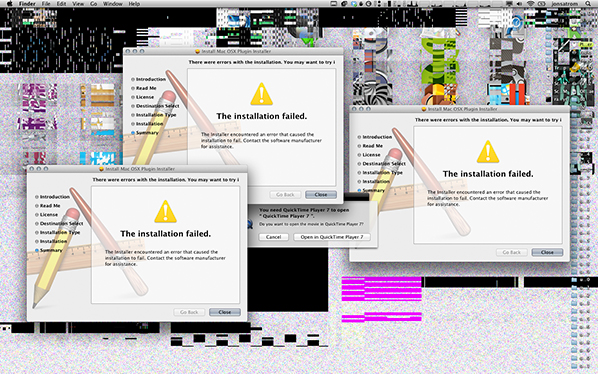
“For every organ-machine, an energy-machine: all the time, flows and interruptions. Judge Schreber has sunbeams in his ass. A solar anus. And rest assured that it works: Judge Schreber feels something, produces something, and is capable of explaining the process theoretically. Something is produced: the effects of a machine, not mere metaphors.”[8]

They are called radio buttons because on old car radios you pushed one button and the other popped out. The performances of jonCates and Jon Satrom were developed as an intersection with the exhibition Ex-Static: George Kagan’s Radios at Intuit, the Center for Intuitive and Outsider Art, on display until January 5, 2013, curated by Erik Peterson and Jeremiah Hulsebos-Spofford.
“In the wee, wee hours your mind get hazy / Radio relay towers lead me to my baby / The radio’s jammed up with talk show stations / Its just talk, talk, talk, talk, till you lose your patience”[9]
jonCates makes Dirty New Media Art, Noise Musics and Computer Glitchcraft. His experimental New Media Art projects are presented internationally in exhibitions and events from Berlin to Beijing, Cairo to Chicago, Madrid to Mexico City and widely available online. His writings on Media Art Histories also appear online and in print publications, as in recent books from Gestalten, The Penn State University Press and Unsorted Books. He is the Chair of the Film, Video, New Media & Animation department at the School of the Art Institute of Chicago:
http://systemsapproach.net/
Jon Satrom undermines interfaces, problematizes presets, and bends data. He spends his days fixing things and making things work. He spends his evenings breaking things and searching for the unique blips inherent to the systems he explores and exploits. By over-clocking everyday digital tools, Satrom kludges abandonware, funware, necroware, and artware into extended-dirty-glitchy-systems for performance, execution, and collaboration. His time-based works have been enjoyed on screens of all sizes; his Prepared Desktop has been performed in many localizations. Satrom organizes, develops, and performs with I ♥ PRESETS, poxparty, GLI.TC/H, in addition to other initiatives with talented dirty new-media comrades.
http://jonsatrom.com/
So ArtForum have launched a special September issue investigating the, lets say broader, relationship between new media, technology and visual art.*
Of worthy mention is the essay Digital Divide by the art world’s antagonistic critic of choice Claire Bishop, a writer whom a little under 8 years ago, deservedly poured critical scorn over the happy-go-lucky, merry-go-round creative malaise that was Bourriaud’s Relational Aesthetics and all of the proponents involved. Since then Bishop’s critical eye has focused on the acute political antagonistic relationships, within the dominant paradigms of participatory art and the concomitant authenticity of the social.
In Digital Divide, Bishop asks a different question, and its delivered even more bluntly than usual. Why has the mainstream art world, for the most part, refrained from directly responding to the ‘endlessly disposable, rapidly mutable ephemera of the virtual age and its impact on our consumption of relationships, images and communication.‘ This is not to say the practices of mainstream artists do not rely on digital media (in almost all cases, it now cannot function without it), but why hasn’t the shifting sands of digital culture been made explicit? In Bishop’s words;
“[H]ow many really confront the question of what it means to think, see, and filter affect through the digital? How many thematize this, or reflect deeply on how we experience, and are altered by, the digitization of our existence?”
Clearly, there are exceptions and she mentions three examples by art stars Frances Stark, Thomas Hirschhorn and Ryan Trecartin which flirt here and there with digital thematisation. Conversely artists who once specialised in digital art, Cory Arcangel, Miltos Manetas – to name two very famous examples – have previously broken out into the mainstream.
But for Bishop, there is of course, “an entire sphere of “new media” art, but this is a specialised field of its own: It rarely overlaps with the mainstream art world (commercial galleries, the Turner Prize, national pavilions at Venice)” – (one could add art fairs here). But nonetheless “these exceptions just point up the rule“. Bishop’s focus is on the mainstream and, moreover, she contends that “the digital is, on a deep level, the shaping condition—even the structuring paradox—that determines artistic decisions to work with certain formats and media. Its subterranean presence is comparable to the rise of television as the backdrop to art of the 1960s.” True enough, this structuring paradox is an implicit problem with the mainstream art world, but thats not the problem tout court.
From the responses I’ve read both in the article comments and in subsequent blog posts, a particular issue has been marked with Bishop’s statement that “new media” art is a specialised field. Whilst it doesn’t qualify as a dismissal, one could certainly suggest that Bishop is partly guilty of the same disavowal she throws at the mainstream art world when she relegates this sphere as an ‘exception’. In a blog-post response, Kyle Chayka makes a similar point; “Bishop understands that digital technology forms a seedbed for art as well as life, but fails to uncover the artists who are already critiquing that context.” I’m not a Lacanian, but maybe this is a symptom of something.
If mainstream art is ‘the rule’, (and I’m insinuating ‘the rule’ as anti-metaphor here) perhaps ‘the rule’ isn’t worth paying attention to, considering that the new media art exception is too much of a ‘specialisation’. In as much as one can only agree with Bishop’s call for mainstream art’s negotiation with digital thematisation, has she not missed the same aesthetic questions already posed and re-composed in this exceptional sphere? Why should the qualifier of the mainstream be such a factor of importance here? Why not cut off the need to reconcile digital thematisation with a set of historical, and commercially ideological principles which may not take kindly to the more ambitious and darker questions that the social and political arena of global digitalisation have thrown up. This is not to say that Bishop isn’t seeking those questions nor does she wish to reconcile those principles, but the specialised sphere of ‘new media art’ may quench the questions she herself raises.
Case in point: all Bishop would have needed to reference is something like the Dark Drives exhibition for the transmediale festival earlier this year; the tag line “uneasy energies in Technological Times” sums up her main descriptions of a digital epoch quite nicely. For instance, the artist group Art 404’s 5 Million Dollars 1 Terabyte, renders explicit one subset of the absurd, copyright, exploitative logic of proprietary software, by saving one terabyte’s worth of unlicensed software onto a single hard drive. Next to it was JK Keller’s idiosyncratic piece Realigning My Thoughts on Jasper Johns, which showed off a glitchy, abstract bastardisation of a Simpson’s episode Mom and Pop Art – regurgitating haggard mainstream perspectives. Crucially the success of the show was down to the implicitness of the exhibition’s technical triumphs – where technical jargon is often touted as a reason for the mainstream’s averted gaze. Whilst the viewer didn’t need to know the technics, but a richer understanding emerged should they have wanted to know.
There isn’t any need to clog up this article with a bottomless plethora of pieces from other equally important exhibtions and shows (I’m sure many others are better qualified in doing so); my point here, is that Bishop cannot relegate new media art as an exception to the rule, when the digitalisation of media is becoming the rule, which she herself explicitly admits. Choosing to focus on the failure of the mainstream in this arena gives the essay a healthy line of questioning, but in relegating an entire sphere which has – for some time – repeatedly dealt with these questions and more, it raises what is effectively a pointless query. To be fair to Bishop, she isn’t trying to force a fecund translation of new media with mainstream values, but looking for methods where digitalisation can instigate the change of those values.
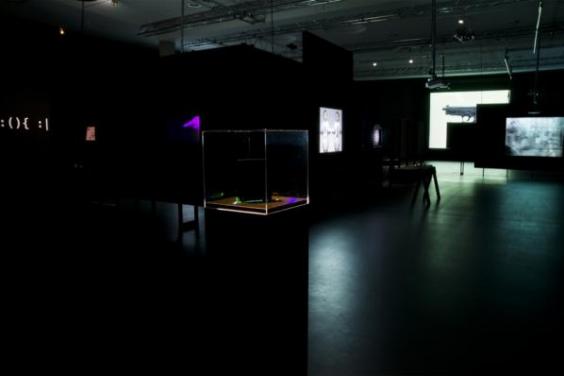
Granted, Dark Drives is one major show in a major Berlin new media festival – the top of a very extensive collection of disparate voices and influences – but it inadvertently highlights a salient thought. What if Bishop’s call to bridge the ‘Digital Divide’ was actually met by a new generation of artists thrust into the mainstream, where digital themes were translated into its own methods of commercial production? We’ve gotten over the myth that ‘virtual’ commodities are unmarketable, so it’s not as if I’m being negative for the sake of it. Where would this leave festivals like transmediale, or not-for-profit collectives like Furtherfield – how would they respond? It’s an uneasy question, one which for speculative purposes cannot be answered quickly at present, if at all.
In the throws of conjecture, there is perhaps another division at play here. Towards the end of her essay, Bishop makes a reference to the difference between the non-existent embrace of the digital medium today, and the rapid embrace of photography, film and video in the 60s and 70s.
“These formats, however, were image-based, and their relevance and challenge to visual art were self-evident. The digital, by contrast, is code, inherently alien to human perception. It is, at base, a linguistic model. Convert any .jpg file to .txt and you will find its ingredients: a garbled recipe of numbers and letters, meaningless to the average viewer. Is there a sense of fear underlying visual art’s disavowal of new media?”
This is a division which is even more striking; more aesthetically and philosophically significant in comparison to marketable rules and unmarketable exceptions. I think Bishop is really on to something when she chastises the hybrid solutions of old media nostalgia, evidently favoured by the market and contrasts it to the alien nature of code, but it’s not without problems.
Some may consider there to be nothing inherently alien about digital media; many artists, who also work as programmers and write, design and engineer artworks together with code without any recourse to an alien nature (however I vehemently disagree with the notion that code be solely reduced to human production, but it must be pointed out) Likewise, any 90s utopian reading of the ‘digital revolution’ is mired from the start, once you take into consideration, closed proprietary devices and services which falsify other meaningful alternatives (one only needs to trace the important work of the Telekommunisten art collective to realise how advanced these questions are, in what is supposed to be a specialised field).
If there is a fear underlying visual art’s disavowal of digitalisation, it’s not just a critical bemusement of code, but of the material which composes computational media; wires, LCD screens, motherboards, caches, firmware, sorting algorithms. Bishop’s call for mainstream contemporary art to be aware of its own conditions and circumstance is admirable, but unless art can actually get its hands dirty with the material processes of new media and more importantly the underlying computational conditions concerning the digital (because thats what it is), the project of explaining these circumstances will be quagmired from the start. It’s not enough to explain ‘our changing experience’ with computation, but to explain the experience of computation in itself.
But for now, lets keep the divide going, not least because antagonisms are fun (Bishop should know), but because the contemporary digital arts are not hindered with the burden of seeking the mainstream’s attention. They can get away with a lot more as a result. Digital or Computational art needs to be cheaper and nastier, as the artist’s tools of use are getting increasingly dirty with critical engagement and proflierfation of code (one cannot avoid mentioning Julian Oliver et al’s important project of critical engineering in this sense). Only then, can Bishop speak of a moment, where the “treasured assumptions” of mainstream art are brought to bear through the criticality of the digital.
——————
* Just to make it clear, I am aware that key terms in this article such as ‘new media’ ‘digitisation’, etc carry little to no relevance anymore, (I prefer computational to be more relevant myself), and they’re only used as a replying dialogue with Claire Bishop’s essay which relies on them throughout.
This conversation follows in a series of interviews with women who work at the intersection of art and technology. Amy Alexander’s work as an artist, performer, musician, and professorapproaches art and technology from a performing arts perspective, often examining intersections of art and popular culture.
Amy Alexander is an artist and researcher working in audiovisual performance and digital media art. She has worked under a number of pseudonyms including VJ Übergeek and Cue P. Doll. Coming from a background in film and music, she learned programming and began making time and process-based art on the Internet in the mid-1990’s with the Multi-Cultural Recycler and plagiarist.org. Amy has performed and exhibited on the Internet, in clubs and on the street as well as in festivals and museums. Her work has appeared at venues ranging from the Whitney Museum and Ars Electronica to Minneapolis‚ First Avenue nightclub. She has written and lectured on software art and audiovisual performance, and she has served as a reviewer for festivals and commissions for new media art and computer music. She is an Associate Professor of Visual Arts at the University of California, San Diego. During summer/fall of 2012, Amy is Artist-in-residence at iotaCenter in Los Angeles.
Rachel Beth Egenhoefer: You’ve taken on many roles as an artist, musician, performer, coder, organizer, professor. How would you explain what you do to the “average Joe” who has not idea what a code artist is?
Amy Alexander: I usually don’t try to explain to people what a code artist is. I generally just tell them about the types of projects I or my students do, (“museum installation,” “club performance,” etc.) and what some of them are about. Then I explain that it’s done by writing software, building electronics, making videos, etc. But the point is more about the projects, not about how specifically they are made.
I also think talking about code-as-art is both less necessary and less difficult than it was five or ten years ago. What motivated me and a lot of other code artists back then was a concern that algorithms had a cultural impact that wasn’t well-recognized. Nowadays, people are familiar with the idea that Google sorts your search results in a particular way, websites you visit develop demographic profiles of you, etc. – they’re already concerned about algorithms. So I think it frees up both artists and audiences to focus on other aspects of the work. Of course, there are definitely some situations in which focusing on algorithms-as-art is important. Just like photographers sometimes focus on the nature of photographs, video artists on video, etc.
RBE: You’ve worked as yourself, as well as other performers such as Cue P. Doll and Übergeek. Can you describe the differences between some of your characters, and how do you see identity as a key element in your body of work?
AA: Some of the online characters just evolved. I tend to anthropomorphize things, and I like to break into characters; I’ve just always done those things. So in some cases when I’m developing a project from a particular perspective, a character emerges who personifies that perspective. For example, The Original Plagiarist.org (1998) website was a collection of projects in which grandiose attempts to opportunistically plagiarize from the Internet always turned out to be transparent. So the character of Plagiarist emerged as the proud proprietor of this site and creator of all its projects – and the only person who couldn’t see the futility of the plagiarisms.
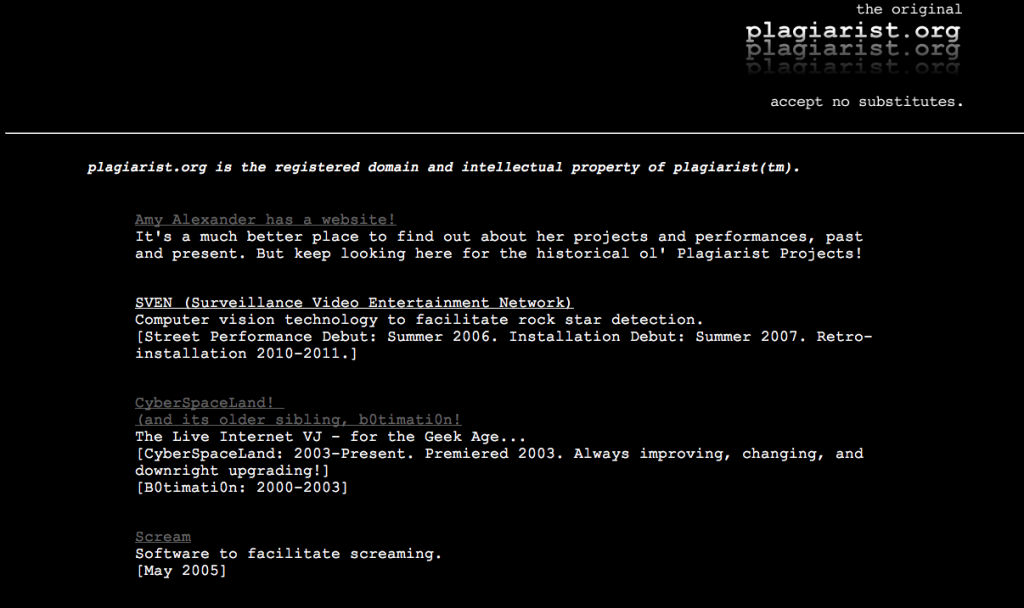
Übergeek is different, since I physically go out and perform as her. She’s both a theatrical character and actual club performer – in varying proportions depending on the context of the show. The theatrical character is a geeky rockstar wannabe. That opens up space for Übergeek to exaggeratedly escape the physical restrictions of performing on a computer – by waving around an “air mouse,” dancing on a DDR pad, etc. The club performer comes from my growing up performing music. I’d never thought about it, but the zone musicians go into to perform is really like playing a character. You have to become someone else. A few years ago I heard Steve Schick explain that when he has to perform a difficult piece of music, he imagines he’s someone else – and that other guy can play the piece. Eventually I realized that any performance of any kind I’d done that I’d been remotely satisfied with, whether music, VJ show, or performance art – I’d mentally become some other person. Going into character is really important, even if the character is just, “the performer.” It can be easy to forget the crossovers between performing arts and visual arts, but there’s a lot we can learn from one another.
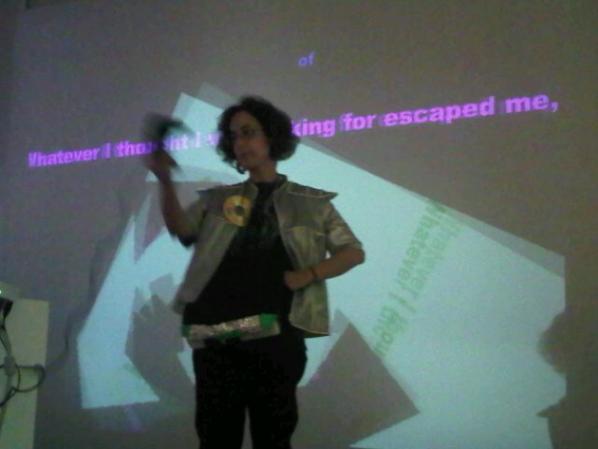
RBE: Do you think this happens to us when we interact online, that we become performers? (Some people believe for instance that Facebook is really a performance of ourselves, not our real selves) Do you see any intersections of performance in “online” vs “physical/ in person” interactions? (I realize this gets into an entirely different question, the idea of intentional performance and unintentional, but perhaps you see an overlap?)
AA: I think there’s an overlap, but there’s also an overlap between the kind of “performances” we do online and those we do in “real life.” I don’t buy the dichotomy that the physical world is real/true and the online world is fake. We perform different sides of ourselves in different real life situations – work, friends, family, large group, small group, etc. Sometimes we perform more consciously than others. On the other hand, sometimes we feel less inhibited in online interactions, so we behave more naturally.
That’s not to say there’s no difference between online and offline interactions – but then again, these differences didn’t just suddenly emerge when the Internet came along. Think back to when people sometimes had pen pals by snail mail, for example. The relationships could be friendly, intimate, or performative. When things like immediacy and nonverbal communication disappear, that invites a different kind of behavior – be it more natural, more performative, or a combination.
RBE: What connections do you see between identity, code, and performance?
AA: I guess I’ve responded to identity & performance in the question above. As for code & performance: people have pointed out that code parallels musical notation, in that both are executable languages. If you think about scores by people like John Cage, where scores could actually be diagrams or verbal instructions to the performers, the connection between performance and instruction set becomes even clearer. This is interesting historically and theoretically, but for many of us who use code in performance, the connection becomes self-evident in practice. Code launches processes and actions, and performance *is* processes and actions, and there’s a back and forth between the performer and software. It’s not that much different for me performing software than performing a musical instrument; if I play violin, I finger, bow, pluck in various ways to get various sounds. You can think of the violin as interface, the notes and gestures as parameters, or whatever. But to be honest, trying to create precise analogies is a recipe for disaster. The point is, you perform both of them, and you have to learn how to do it. The difference with software is, you build your own instrument; that’s both a blessing and a curse. So you try to balance playability with flexibility, and so on. Because of my experience playing music, I keep trying to build ones that will accommodate clumsy performers like me!
RBE: Do you see all code as being “performed”? (Or perhaps is saying code is executable the same as saying code is performed?)
AA: It depends on which sense of the word “performed” you’re using. In the sense that means to do some sort of process – like to perform your job duties – yes. You can think of data as nouns and algorithms as action verbs. You “run” code, and though the physical metaphor might be an exaggeration, in general, some sort of an action happens. So in that sense, the processor is performing the code.
But in the other sense of the word – intentional performance, performing arts, performance art, etc. – running code is innately no more of a performance than breathing. People like John Cage have made interesting performances out of breathing, and people like Alex McLean have made interesting performances out of running code. But it’s not that way on its own, except in the Cagean sense of it being performance if you think of it that way. I think that’s interesting, but I’m personally more interested in code’s cultural, rather than formal, implications. In other words, I’m not so excited that processes are dynamic and self-repeating for their own sake. I’m more interested if, for example, that means we have increasing difficulty finding unpopular or obscure information online, because the popular perspectives have formed an algorithmic echo chamber.

RBE: Your newest work is using audiovisuals, performance, solar energy, and the history of dance in cinema. How did you arrive at this combination of ideas?
AA: The project is Discotrope: The Secret Nightlife of Solar Cells. It’s an audiovisual performance – a collaboration with Annina Rüst, with algorithmic sound design by Cristyn Magnus. There’s really two parts to the project: the projection system, and the content and performances that we develop for it. The system is a disco ball where some of the mirrors have been replaced by solar cells. The cells power the motor that turns the ball. We project video onto the ball instead of colored light. The result is, reflected, fragmented video images move around the room. Since the video projections “solar”-power the ball, the speed at which the images move around the room varies with the brightness of the images.
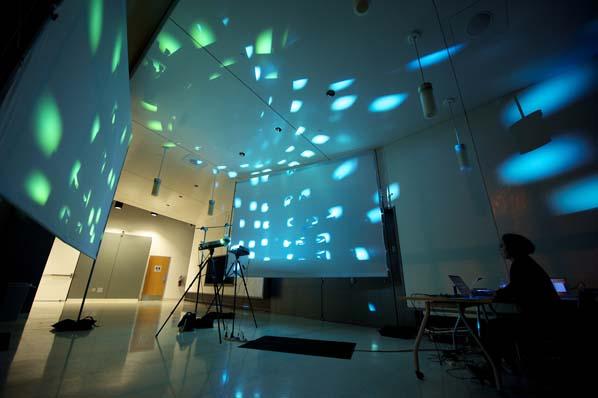
The way this all came about was I’d been interested in the philosophy behind hybrid cars and various other things – that when we “waste” energy, we might actually be creating it. I kept wondering if this idea could be applied to media somehow, and I kept trying various experiments with video: could the talking heads on cable news power an LED? etc. Never quite found the right outlet for this idea, though. At some point, Annina and I came across a disco ball, and we noticed the similarity between its mirrors and small solar cells. Then the idea of projecting videos onto it hit us, and it all came together as a “media-powered” system. Of course, that was just the general idea. After Annina built the initial prototype of ball, it took many hours working with it the studio for the “instrument” to reveal itself – i.e. how exactly does a video-powered disco ball become useful visually and performatively? Figuring that part out was just elbow grease – but getting from rough idea to what-is-this-really always is for me; I have to get my hands on things and play with them.
The content framework we’re working with for at least our initial round of performances is “the history of dancing ‘at’ cameras.” Since it’s a disco ball, we envisioned performing it at community dance parties, etc., and so people dancing seemed like the obvious thing to project. We started from the idea of projecting the people at the party onto it live – but we realized we also wanted to expand beyond that. Again, the elbow grease process: I’d try different clips of people dancing on YouTube, old movies, TV shows. Eventually a connection emerged between early cinema clips and contemporary YouTube clips. In both cases, people dance pretty much like vaudeville performers, directly for the audience – as opposed to cinematic narrative style, in which the viewer is a fly on the wall. In the dancing “at” cameras style, there’s a more direct, intimate connection between dancer and audience. We’ve written some things about this on the Discotrope blog – and I’ll probably write more there soon. Another thing we became interested in is how representation (gender, physical, etc.) does and doesn’t change from early movie camera demos and Hollywood films to YouTube, where people are generally self-cast and self-directed. And I’m really interested in the relationship between all of this and the muddy space between exhibitionism, voyeurism, and surveillance. That’s a theme that’s run through a number of my projects, and dancing at cameras certainly exemplifies that murkiness.
Of course, a lot of the dancing at cameras perspective relates to film history in general – cinema’s origins in theatre and vaudeville, the development of montage, etc. So it’s interesting to see it return with YouTube. Teresa Rizzo has written a really interesting article related to this called, YouTube: The New Cinema of Attractions.
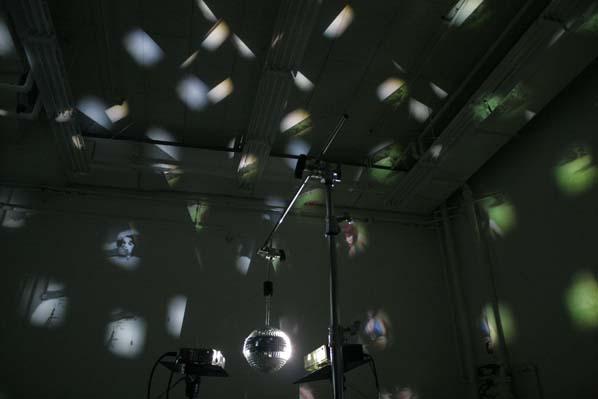
RBE: When you say “people dancing at cameras” I immediately thought of surveillance cameras. Is your disco ball a type of surveillance camera?
AA: I’m really interested in the blurring between surveillance, exhibitionism, and voyeurism. The Multi-Cultural Recycler, SVEN, and CyberSpaceLand all hit on that theme in one way or another; this time it’s cinematic dancers. The cinema/YouTube performers who appear in Discotrope all knew they were on camera, so overtly it’s more about exhibitionism and voyeurism. Glamorous 1950’s female burlesque dancers did their strip tease acts for the camera; sixty years later, not-so-glamorous scantily-clad men proudly stomped through the Single Ladies dance on YouTube. One group does work-for-hire within the Hollywood studio system; the other does what they want. Does that make one voyeurism and the other exhibitionism, or is it more complicated than that? in some cases, we see the performers much differently than they probably saw themselves. Does that make it surveillance? I think it’s all very muddy, and that’s what I find interesting.
The flip side is that there are people in some of Discotrope’s YouTube videos doing things like dancing in Walmart, which gives the video a surveillance camera look even though it’s obviously not surveillance (in the traditional sense, at least.) People turn the tables on surveillance video and make their own production numbers in surveilled/controlled areas – for fun and as a type of resistance. That’s one of my favorite parts of Discotrope. Then we get to recreate those Walmart spaces in the big Discotrope projection. It makes it even more like an old Hollywood production number, and it makes it weirdly immersive. This is fun for us, because Walmarts are not the kind of thing normal people like to recreate immersively. 🙂
RBE: For this piece you are creating something for other people to perform with. Are there any differences for you in creating work that you will perform vs. others performing?
AA: Ah, those pesky multiple senses of “performance” again!. 🙂 I do the visual performances for Discotrope, so for now I’m primarily building the software system for myself to perform. So far Annina is the only other person who performs with the software. Like anything, it’d require some tweaking to be distributed for more general use, though I’ve tried to make it not too terrible in that regard. 🙂 More challenging/interesting might be for performers to get the feel for moving the ball – like anything, it takes practice to get proficient.
But perhaps you’re talking about performers in terms of the audience who can dance to Discotrope, or the parts of the show where audience members can dance on camera interactively. In this case, they’re both performer and audience at the same time. That’s an interesting challenge, because in designing the show, we have to think about them in both ways.
RBE: You are starting a residency at the iotaCenter in Los Angeles, what will you be working on there?
AA: It’ll be mainly exploratory/preliminary research; things will likely be changing/developing as I go along. But my general plan is to explore two threads: gestural and spatial cinematic performance. In performing CyberSpaceLand over the years, I found myself unconsciously developing certain gestural/structural performance techniques that were much different than what I’d consciously designed for the piece. That spawned some ideas about gesture, time and space that I’m going to try to take further. The spatial thread grew out of some things we’ve played with in Discotrope in terms of deconstructing cinematic narrative in a 360 degree space. I’ll be exploring these spatial cinema ideas both in regards to Discotrope and as broader research.
iotaCenter’s a great place for doing research in abstract / formal and experimental cinema, visual performance history, etc. They’ve got a terrific collection of films and texts. I’m hoping to also use the opportunity to get together with other experimental cinema and visual performance folks in LA. It’d be great to organize some fun/intellectually-stimulating/breathtakingly-earthshattering screening/performance events.
RBE: This interview is going to be part of a series of interviews with women working in art and technology. What do you consider to be important today about being a woman working in art & technology? Do you think it is still useful to discuss the female voice as a separate voice in the field?
AA: It’s a tricky subject, because we both need to hear women’s voices and avoid tokenizing or homogenizing them. Women artists working with technology do tend to have different perspectives than men, and there are far fewer of us. So often when the dominant themes emerge, they tend to be the “masculine” themes by virtue of sheer numbers. A corollary is that often women artists feel pressured to focus on gender issues or certain types of social issues. Again, it’s a problem of critical mass and self-perpetuating themes. Since a fair number of women are already involved with those topics and many women’s interests overlap there, they have momentum. But this ends up discouraging women from discussing or doing work on other topics they’re interested in, So, while we need to talk about shared experiences among women in art and technology, we also need to recognize that they have a diverse range of work and perspectives.
RBE: How have you seen perceptions of gender change through the years either in teaching, performing, or working as an artist?
AA: It’s interesting to think that the first programmers were women, and that at the time it was considered clerical work. (See Researcher reveals how “Computer Geeks” replaced “Computer Girls” by Brenda Frink.)
As men started to fill programming jobs, the perception of programming shifted. It became something “technical” that was somehow inherently “man’s work,” even though it had been clerical “women’s work” only a few decades earlier. I’ve seen something similar happen as a female computing artist. I think there are more of us now – at least we don’t seem to be the novelty we were ten or fifteen years ago. And I’ve seen a shift in attitudes and perception among undergraduate computing arts students: by now both the men and women have grown up playing video games and doing a variety of Internet activities that might have seemed like “boys-with-toys” pastimes a decade ago. So their perceptions of what they’re learning to do as computer artists is a little more open and less gendered. But unfortunately, there are still circular perceptions in all age groups that whatever technical work women are doing can’t be too serious by virtue of the fact that a woman did it. It would seem to parallel the current political debate in the US about the pay gap between women and men. There are always arguments that women’s jobs aren’t as demanding, and they usually end up with someone saying, “I can’t believe we’re still talking about this in 2012!” So on one hand, the more things change, the more they stay the same. On the other hand, as more women computing artists emerge, we’ll hopefully soon achieve sufficient critical mass for world domination. Don’t say I didn’t warn you.
This conversation follows in a series of interviews with women who work at the intersection of art and technology. As someone who works as an artist, curator, organizer, professor, researcher, and board member Sue Gollifer embodies this intersection across many venues.
Sue Gollifer has been a professional artist and printmaker for more than thirty years, Gollifer has exhibited her work worldwide and been collected by major international public institutions. A pioneer of early computer art, she has continuously explored the relationship between technology and the arts and has written extensively on this subject. Gollifer is a Principal Lecturer in Fine Arts and the University of Brighton where she is also the Course Leader of the MA Digital Arts Program. She has been instrumental in shaping major international arts communities including: the Design and Artists Copyright Society (DACS), the Computer Arts Society (CAS), and the College Arts Association, (CAA), ISEA, SIGGRAPH, Lighthouse Brighton, and many others. Gollifer is currently also the Director of the ISEA International Headquarters.
Rachel Beth Egenhoefer: Given the many hats you wear as an artist, curator, organizer, professor, many people describe you as many things… how do you describe yourself?
Sue Gollifer: I am an artist.
RBE: But you do other things too?
SG: I know I do. At the moment I’m more of a curator and an organizer, but at the end of the day I am still an artist.
RBE: How do you define your role as an artist in relation to being on the many board of directors you are on (such as ISEA, CAA, DACS, and others)?
SG: I’m not a theorist or in a senior management position but I think that these organizations need people who have a broad sense of the discipline to be on their boards to make sure that people like me and people like you have a voice.
RBE: So you see yourself as representing artists?
SG: Yeah, and I think the fact that I have a European background gives me a broader image as well. When I think about being on the board of some local organizations like Lighthouse or Phoenix in Brighton they value that I’m also part of an International network such as CAA and SIGGRAPH and ISEA. It’s quite reciprocal too. The bigger organizations value my spectrum.
RBE: What do you learn as an artist from doing all these other organizational things?
SG: I think what it does is it starts me making work. It’s like any of those things. But I think it started off when I was a consultant to Higher Education in the UK and I just got used to facilitating and networking and telling people about things. And I realized I was really quite good at that.
RBE: Networking?
SG: Yeah. But not just networking. I organize a lot of mailing lists, where I act as a kind of filter for people, letting them know about events and festivals, and ideas that are going on.
RBE: So given that you work in all of these roles, as an artist, as an organizer, as a filter, what changes have you seen over the years of working in these fields?
SG: Well, technologies have changed our lives with the Internet and mobile phones. You know I travel a lot, but half the time people don’t know that I’m not really there, because I still do what I’m doing somewhere else. Where you are doesn’t really matter. You still kind of function, which has its good points and its bad points really, cause you’re always on call.
RBE: What about changes in content or questions that people are asking? Either in art practice or education or conferences and festivals, have there been any changes?
SG: I think the reason why ISEA is successful is because, although we all have our distributed networks and we’re always in constant touch, I think the act of physically bringing people together is really important. But I do think also that a lot of the organizational things like content management systems and the ways that you hear about various festivals and things is made so much easier. At the same time there are so many of them. It’s really important with my ISEA hat on that I’m thinking about the “un-conference” and that you don’t get stuck in a rut. There is a changing landscape and environment and you need to keep up with that.
But with my educator’s hat on, thinking about PhDs and research papers, there’s a lot more to do with money and research and getting money from science backgrounds now. But the idea of research gets lost. What they value is that people are writing about stuff, they’re not actually doing it, but writing about it, using research as evidence.
RBE: What is the role of research in art?
SG: I don’t know. What do you think? Do you think it’s the work? Do you think it’s making the work?
RBE: Well, I think research can inform the work, and work can inform research. But I think the point you brought up about research and the sciences and the value of it, it seems like it can become problematic when it is seen as a moneymaker. Or when the purpose of it is to get money and not the purpose being to inform the work.
SG: Yeah, I was involved in a science project and there was a lot of money in it and they obviously valued the significance of the artists being in there but really you have to fit your research around the money rather than the other way around. It just got out of sink.
RBE: Does that map at all on to how conferences and festivals are set up? Does the work dictate what will be at the event, or does the event dictate what will be made by artists?
SG: Well, to get back to the research thing. Research as evidence of something, even if you are putting work in an exhibition or putting work in a paper or something, you still need evidence.
RBE: But as far as themes or content, how is that dictated? For example the upcoming ISEA is all about “Machine Wilderness”. Was that a result of artists making a lot of work in that realm and we should have a festival about it, or do you think that it was a decision to have a festival about this and encourage artists to think and make work like this?
SG: Well when people put in a bid to host ISEA, they put in what they think the nature of what ISEA will be about. Obviously when we look at proposals we look at not only the relevance but also the integrity of the people delivering it. “Machine Wilderness” in this case is very much around the themes that Andrea Poli is interested in. The theme of ISEA in Istanbul was “Contained/ Uncontained” which was similar but also a bit broader.
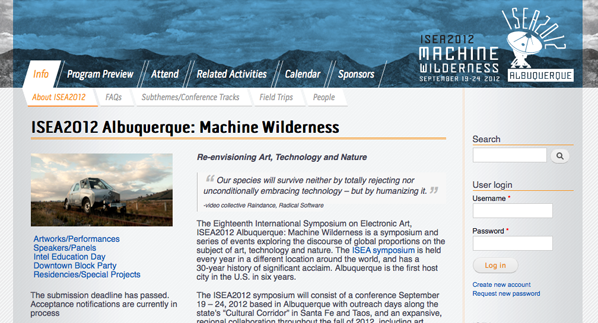
RBE: How do you see the differences in cultures influencing different ISEA’s? ISEA purposely has the festival in different cities around the world, how does that influence the work or the field or what people are thinking and doing?
SG: Well if you take the case of the ISEA in RUHR, Germany, it was to do with the Creative Industries, and creating awareness of new industries. You know we come in and inform people about new things. There’s the idea that we can change things. Or bring things to a city in a way of education and outreach. It shouldn’t be just us sitting in a dark room talking to each other.
RBE: So you see it as a way to bring new media awareness to these different cities?
SG: Yeah.
RBE: But then what do the artists and participants get in return? Or what does ISEA get in return?
SG: You get to travel and meet people! I think you get a different perspective.
We did have two bids coming through for ISEA2014 from Zayed University, Dubai, UAE and Simon Fraser University, Vancouver, BC. Recently the ISEA Board agreed that the Dubai bid, with its focus on the burgeoning field of art and technology in the Arab World would provide a unique opportunity for ISEA to connect audiences and artists from the Middle East with the international electronic art community.
A strong aspect of the bid was the focus on women’s education and ensuring that young women have the potential to influence the future of the region and develop international contacts.
I hope that ISEA can leave a legacy somewhere. I mean otherwise we might as well just have it over Skype calls. The overarching theme of ISEA2014 ‘Location’ will explore strands such as Technology; Science & Art East Meets West; Emerging Economies/Emerging Identities; Nomadic Shifts and Digital Archaeology and Collaborative Spaces.
RBE: This interview is part of a series of interviews with women using art and technology. What do you think is important in having a female voice in today’s art world?
SG: I talk to my students about my role and my job and things like that, and my female students think that it’s really great that I run a digital arts course. If I were a man it would be very very different. I think it’s equally important that students aren’t just taught by women, but women of all ages, those that are married, not married, children, no children. I think we do have to establish role models to a certain extent.
I was a feminist in the 60s and 70s but I never thought that we should be different. I just wanted to be accepted for who I was really. That might be a bit anti-feminist, but I always fought for women for education and opportunities. This goes back to the Dubai thing to a certain extent, the university there started off because one of the princesses wanted to learn about art but there was no place to do so. So it started and went on to have a validated degree. And maybe one day it will have a masters program and women can apply for scholarships and travel abroad?
RBE: Do you think it’s important to have “Women Art & Technology” as a separate category? Or should it just be “Art & Technology”?
SG: Art and Technology.
RBE: Aside from being a female role model for your students and talking about the female voice, what else do you think is important for your students to know right now or learn right now?
SG: Code! (laughs) But I don’t like to think we’re bringing them up differently?
RBE: Or even taking gender out of it, what do young people need to know?
SG: They need to be aware of things. But it depends on what they are trying to do and what direction they want to go in… A big thing is confidence. A lot of my women students do lack confidence.
RBE: Why do you think that is?
SG: I don’t know what it is.
RBE: So what do you do to boost their confidence?
SG: I give them a voice. I give them a space and an opportunity in the class.
When I used to do interviews for undergrad programs in Printmaking, it always started off that the women had better grades, better portfolios, better skills, but at some point it switches. And they loose that confidence and that voice. I don’t know what it is really.
Do you find that?
RBE: The program I teach in has a majority female students. I think that it might be easier for them. I do wonder though sometimes if they are more confident when they are in a classroom with me verses one of my male colleagues or just a different background. But I think there’s also the other end of the spectrum where they are overly confident because they are growing up in this world where you have to be liked constantly on Facebook. You know, like me, like my image, like me, like me, like me… They need to be constantly validated and that spirals into “I’m amazing”. But those aren’t the ones who are asking the tougher questions; those are the ones who want to be liked.
SG: There’s another aspect. Maybe not about confidence, but I think there’s a smoke and mirrors element. There are some men that seem to have all the jargon without actually any credibility. And the women I know with credibility don’t necessarily tell everyone that they do it.
RBE: There are actually studies about that, and how male and female brains are wired differently to behave differently.
SG: I think they address issues in a different way.
RBE: What are you working on now?
SG: Alan Turing!
RBE: What is your role in the Turing Project?
SG: I’m putting together with Anna Dumitriu the exhibition ‘Intuition and Ingenuity’, a group exhibition that explores the enduring influence of Alan Turing – the father of modern computing – on art and contemporary culture. 2012 will be the 100th anniversary of the birth of Alan Turing, one of the greatest minds Britain has produced; the world today would have been a very different place without his ideas.
I’m also curating a projected drawing Exhibition for the Drawing Research Network (DRN) conference in Loughborough in September.
I have also just been part of selection partnership for two newly commissioned pieces of work for Brighton Festival, ‘Sea of Voices’, and ‘Voices of the SEA’. Plus reviewing work for SIGGRAPH art gallery 2012 and for ISEA2012, and papers for the journal ‘Digital Creativity’, of which I am assistant editor.
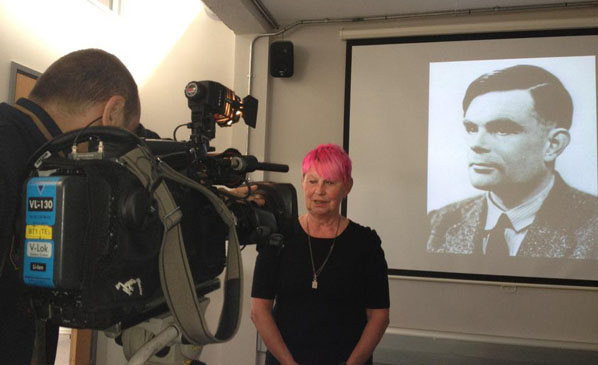
RBE: What excites you about the future?
SG: I don’t know really. I hate to get gloomy about the future, but I do think it’s going to get worse. I mean you live in San Francisco and I live in Brighton so I don’t think it’s hit us quite yet, but I am starting to notice a lot of shops closing. And I know that things I took for granted like buying a house, having children and having a job, I don’t think they have these choices anymore.
RBE: How do you think this will impact the art community?
SG: There are surprisingly good opportunities for the use of vacant shops and offices for exhibition spaces and studios and surprisingly people buy art because they think it’s an investment for the future.
RBE: Do you have anything else you want to tell the Furtherfield readers?
SG: I think it’s going to be interesting and exciting in the future, despite all this, I think it’s going to be exciting to see what comes next.
Other interviews in this series:
Woman, Art & Technology: Interview with Lynn Hershman Leeson By Rachel Beth Egenhoefer
Women, Art & Technology: Interview with Sarah Cook
The Glitch Moment(um)
Rosa Menkman
Institute Of Network Cultures, 2011
ISBN 9789081602167
Rosa Menkman’s book “The Glitch Moment(um)” is a comprehensive study of the theory, practice and social context of contemporary digital Glitch Art. Glitch Art is similar to the ironisation of the noise of old media into cultural signals seen in Trip Hop and that is the basis for the nostalgic image-making of Lomography or Instagram. But it is based on current digital technology, rather than past analogue technology.
Glitch Art is growing in popularity and critical attention, and is already being recuperated by the mass media (for example in a recent Calvin Klein perfume television advertisement). Analogue glitches have been part of art and popular culture for decades, for example in Nam June Paik’s television-based art or the titular character of the cyberpunk TV show “Max Headroom”. Digital glitches and their simulation featured in the postmodern graphic design of the early 1990s created by groups such as Designers’ Republic. But between a history of analogue media and a future of mass media recuperation there is the current Moment(um) of digital glitch aesthetics that Menkman identifies.
Menkman begins by explaining the basics of Shannon/Weaver information theory as the basis for a theory of what glitches are. In information theory, messages are sent as a signal from a transmitter to a receiver over a channel which is disrupted by a source of noise. This “noise” is the crackle on analogue telephones or on vinyl records, the static on analogue TV and radio, and the corruption that sometimes affects digital images or audio streams (nowadays notably Skype chats).
Where kinds of noise are associated with a particular we can recognise them as particular “noise artifacts”. We can also recognise compression artefacts in digital media such as those seen in over-compressed lossy image and video files (JPEG and MPEG artefacts). These noise and compression artifacts are experienced by the users of communication media as glitches. Menkman describes these phenomena in detail, providing the reader with a firm foundation in the sources and expression of Glitch phenomena.
How artists can deliberately create these phenomena is the subject of the next section of the book. Titled “A Vernacular Of File formats” it is a condensed adaptation of Menkman’s 2010 artwork of the same name. It is a thorough and accessible resource for both understanding the production of and creating visual glitch aesthetics. Each picture demonstrates a technique for modifying the data of an image file format so that a computer can still parse and render the file but it will appear corrupted to a human viewer. Starting with an uncorrupted (but unnervingly contrasty) “RAW” image, Menkman explains the production and principles of corrupted digital images in sufficient detail that the reader can recreate and build on these techniques themself, or use this knowledge as the basis for understanding and appreciating the work involved in the Glitch Art produced by others.
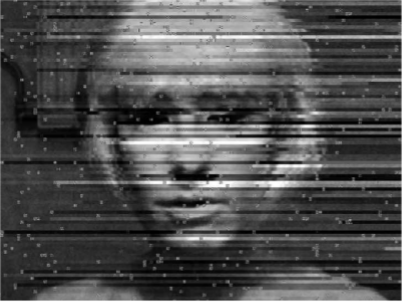
The next two chapters cover the phenomenology and philosophy of Glitch. The theories of Paul Virilio and Alan Liu are usefully deployed here to give Glitch a philosophical grounding. But there is also a recognition that Glitch is an inherently open concept that is difficult to define. Menkman rightly considers the work of Beflix (Ant Scott) as a leading Glitch Art figure. The diversity of Beflix’s work illustrates the problem with categorizing Glitch neatly, or at all. 5VOLTCORE, JODI, and others provide alternative views of what Glitch can be. This builds to Menkman defining “Glitchspeak” as the vernacular, or in possibly the creole, of Glitch Art.
In “From Artifact To Commodity”, Menkman turns to Glitch aesthetics in music, particularly the glitches created through circuitbending, and the precedent this has set for the creation of standardized tools for glitching visual media. As such tools have been created for images, Glitch aesthetics have found their way into the artistic mainstream and into music videos and other mass media. Glitch may be impossible to categorize but it is all too easy to commodify. This marks its emergence as a genre, and Menkman finishes this section by considering Glitch as a recognizable but still problematic genre that relies heavily on spectators’ technical, aesthetic and theoretic literacy.
Having given the reader a solid grounding in the theory, practice and philosophy of Glitch, Menkman finally moves on to its sociology. Using a tool that looks like Gephi but isn’t (Issuecrawler), Menkman models the social network of relationships between Glitch artists that exist on the Internet. Clustering blogs and other Internet expressions by the number of links between them allows the tools of social network analysis to be used, revealing who is central to the Glitch artworld as judged by the clicks of their peers.

Finally Menkman sums up Glitch aesthetics in a section called “The Emancipation of Dissonance Glitch”. Starting with a quote from Jackson Pollock:
“I don’t use the accident. I deny the accident. There is no accident, just as there is no beginning and no end.”
Menkman concludes that “Like the best ideas, glitch practices are dangerous because they generate awareness”. By which point the reader is perfectly placed to understand just how and what kind of awareness Glitch generates, and how they can appreciate or produce Glitch art themselves.
Glitch Art has been long overdue serious critical attention. I cannot remember the last time I read a book that so thoroughly and concisely presented the theory and practice of a contemporary art movement in as does “The Glitch Moment(um)”.
You can download a PDF or order a print copy here
The text of this review is licenced under the Creative Commons BY-SA 3.0 Licence.
“It is not accidental that at a point in history when hierarchical power and manipulation have reached their most threatening proportions, the very concepts of hierarchy, power and manipulation come into question. The challenge to these concepts comes from a redsicovery of the importance of spontaneity – a rediscovery nourished by ecology, by a heightened conception of self-development, and by a new understanding of the revolutionary process in society.” Murray Bookchin. Post-scarcity and Anarchism (1968).
The rise of neo-liberalism as a hegemonic mode of discourse, infiltrates every aspect of our social lives. Its exponential growth has been helped by gate-keepers of top-down orientated alliances; holding key positions of power and considerable wealth and influence. Educational, collective and social institutions have been dismantled, especially community groups and organisations sharing values associated with social needs in the public realm. [1] Bourdieu.
In this networked society, there are controversies and battles taking place all of the time. Battles between corporations, nation states and those who wish to preserve and expand their individual and collective freedoms. Hacktivist Artists work with technology to explore how to develop their critical and imaginative practice in ways that exist beyond traditional frameworks of art establishment and its traditions. This article highlights a small selection of artists and collaborative groups, whose work is linked by an imaginative use of technology in order to critique and intervene into the opressive effects of political and social borders.
In June 2000, Richard Stallman [2] when visiting Korea, illustrated the meaning of the word ‘Hacker’ in a fun way. When at lunch with some GNU [3] fans a waitress placed 6 chopsticks in front of him. Of course he knew they were meant for three people but he found it amusing to find another way to use them. Stallman managed to use three in his right hand and then successfully pick up a piece of food placing it into in his mouth.
“It didn’t become easy—for practical purposes, using two chopsticks is completely superior. But precisely because using three in one hand is hard and ordinarily never thought of, it has “hack value”, as my lunch companions immediately recognized. Playfully doing something difficult, whether useful or not, that is hacking.” [4] Stallman
The word ‘hacker’ has been loosely appropriated and compressed for the sound-bite language of film, tv and newspapers. These commercial outlets hungry for sensational stories have misrepresented hacker culture creating mythic heroes and anti-heroes in order to amaze and shock an unaware, mediated public. Yet, at the same time hackers or ‘crackers’ have exploited this mythology to get their own agendas across. Before these more confusing times, hacking was considered a less dramatic activity. In the 60s and 70s the hacker realm was dominated by computer nerds, professional programmers and hobbyists.
In contrast to what was considered as negative stereotypes of hackers in the media. Steven Levy [5], in 1984 published Hackers: Heroes of the Computer Revolution [6]. In three parts, he writes about the canonical AI hackers of MIT, the hardware hackers who invented the personal computer industry in Silicon Valley, and the third-generation game hackers in the early 1980s. Yet, in this publication, what has had the most impact on hacker culture and is still used widely as a guideline by many is the ‘hacker ethic’. He identified this Hacker Ethic to be a code of practice consisting of key points such as that “all information is free”, and that this information should be used to “change life for the better”.
1. Access to computers—and anything which might teach you something about the way the world works—should be unlimited and total. Always yield to the Hands-on Imperative!
2. All information should be free.
3. Mistrust authority—promote decentralization.
4. Hackers should be judged by their hacking, not bogus criteria such as degrees, age, race or position.
5. You can create art and beauty on a computer.
6. Computers can change your life for the better.
Levy’s hacker ethic promotes the idea of performing a duty for the common good, an analogy to a modern day ‘Robin Hood'[ibid]. Proposing the concept that hackers are self-reliant whilst embracing a ‘healthy’ anti-authoritarian stance, combined with free and critical thinking. Proposing that hackers should be judged by their ability to hack, and presenting hacking as an art-form. Levy also says that the Free and open source software (FOSS) movement is the descendant of the hacker ethic. However, Levy’s hacker ethic has often been quoted out of context and misunderstood as to refer to hacking as ‘breaking’ into computers. This specifically prescribed role, denies the wider and creative context of what hacking is and could be. It does not have to be just about computer security.
This leads us to ‘crackers’. All crackers hack and all hackers hack. But, crackers are seen as second rate wannabe hackers by the older generation of hackers. The Black Hat Hacker or cracker designs and releases malicious code, gathers dangerous information and brings down sensative systems. The White Hat Hacker hunts down and destroys malicious code, and the casual hacker who hacks in order to learn information for his or her own curiosity; both generally dislike ‘Black Hats’ and ‘Crackers’, and tend to view them as computer criminals and dysfunctional juveniles. Lately, crackers have also been labeled as ‘script kiddies’. As a kind of snobbish insult, it refers to those who are not capable of building or programming their own tools, but tend to use scripts and programs written by others to perform their intrusions. To add to the confusion we also have the term ‘Grey hat’. Which refers to a hacker acting between black hat and white hat. Indeed, this could demonstrate where art hacktivists reside, challenging the trappings of the traditional concept of goody and baddy.
“There is another group of people who loudly call themselves hackers, but aren’t. These are people (mainly adolescent males) who get a kick out of breaking into computers and phreaking the phone system. Real hackers call these people ‘crackers’ and want nothing to do with them.” [7] Raymond.
“The basic difference is this: hackers build things, crackers break them.” [ibid] Raymond.
But before we judge,
let’s view a snippet of the \/\The Conscience of a Hacker/\/ by +++The Mentor+++
Written on January 8, 1986.[8]
“This is our world now… the world of the electron and the switch, the
beauty of the baud. We make use of a service already existing without paying
for what could be dirt-cheap if it wasn’t run by profiteering gluttons, and
you call us criminals. We explore… and you call us criminals. We seek
after knowledge… and you call us criminals. We exist without skin color,
without nationality, without religious bias… and you call us criminals.
You build atomic bombs, you wage wars, you murder, cheat, and lie to us
and try to make us believe it’s for our own good, yet we’re the criminals.”
The term ‘Hacktivism’ was officially coined by techno-culture writer Jason Sack in a piece about media artist Shu Lea Cheang published in InfoNation in 1995. Yet, the Cult of the Dead Cow [9] are also acknowledged as defining the term. The Cult of the Dead Cow are a group of hackers and artists. They say the Hacktivism phrase was originally intended to refer to the development and use of technology to foster human rights and the open exchange of information.
Hacktivism techniques include DoS attacks, website defacement, information theft, and virtual sabotage. Famous examples of hacktivism include the recent knocking out of the PlayStation Network, various assistances to countries participating in the Arab Spring, such as attacks on Tunisian and Egyptian government websites, and attacks on Mastercard and Visa after they ceased to process payments to WikiLeaks.
Hacktivism: a policy of hacking, phreaking or creating technology to achieve a political or social goal.
“Hacktivism is a continually evolving and open process; its tactics and methodology are not static. In this sense no one owns hacktivism – it has no prophet, no gospel and no canonized literature. Hacktivism is a rhizomic, open-source phenomenon.” [10] metac0m.
The practice or behaviour of Hacktivism is at least as old as Oct 89 when DOE, HEPNET and SPAN (NASA) connected to (virtual) networked machines world wide. They were penetrated by the anti-nuclear group WANK worm.
WANK penetrated these machines and had their login screens altered to…
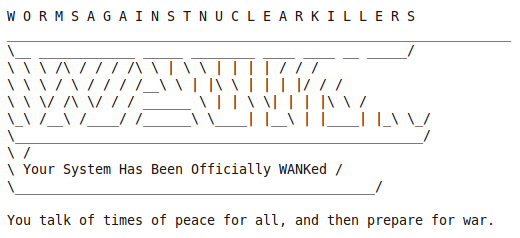
HACKING BORDERS: Examples of Art Hacktivism & Cultural Hacking…
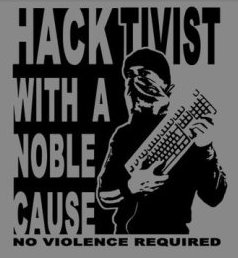
“Radical groups are discovering what hackers have always known: Traditional social institutions are more vulnerable in cyberspace than they are in the physical world. And some members of the famously sophomoric hacker underground are becoming motivated by causes other than ego gratification.” [11] Harmon.
Hacktivism, exploits technology and the Internet, experimenting with the immediacy of distributable networks as a playful medium for independent, creative and free expression. There has been a gradual and natural shift from net art (and net.art) into Hacktivism. Net Art in spirit, has never really been just about art being viewed on a web browser alone. Some of the very same artists whose artwork involved being shown in browsers and making code behind the browser as part of the art, have also expanded their practice outside of the browser. One such artist is Danja Vasiliev, “Fifteen years ago WWW was something very new in Russia and besides the new dial-up aesthetics and world-wide means it brought a complete new layer of existence – “netosphere”, which made my youth.” Vasiliev very soon moved on from playing with browsers into a whole new territory. [12]
Danja co-founded media-lab moddr_ in 2007, a joint project at Piet Zwart Institute alumni and WORM Foundation. Based in Rotterdam moddr_ is a place for artists and hackers, engaging with critical forms of media-art practice. He collaborated with Gordan Savicic and Walter Langelaar from the moddr.net lab on the project Web 2.0 Suicide Machine, which lets you delete your social networking profiles and kill your virtual friends, and it also deletes your own profile leaving your profile image replaced by a noose.”The idea of the “Web 2.0 Suicide Machine” is to abandon your virtual life — so you can get your actual life back, Gordan Savicic tells NPR’s Mary Louise Kelly. Savicic is the CEO — which he says stands for “chief euthanasia officer” — of SuicideMachine.org.” [13]
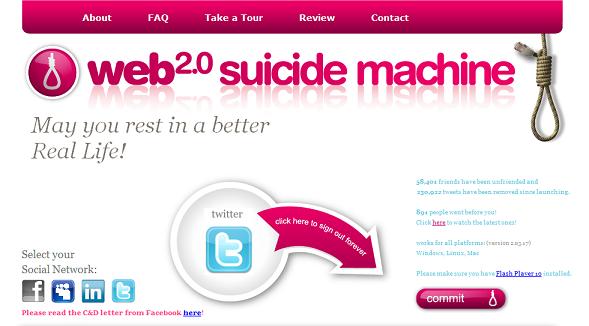
Just like another project called ‘Face to facebook’ that stole 1 million facebook profiles and re-contextualized them on a custom made dating website (lovely-faces.com), set up by Italian artists Paolo Cirio and Alessandro Ludovico, whom also just so happens to be editor in chief of Neural magazine. Web 2.0 Suicide Machine, had to close its connections down regarding its Facebook activities after receiving a cease and decease letter from Facebook. [14]
Julian Oliver and Danja Vasiliev teamed up and formed the mysterious group Men in Grey. The Men In Grey explore our online vulnerabilities by tapping into, intervening into wireless network traffic. Observing, tracing and copying what we do. This hack then redisplays our activities back to us, showing the data of our online interactions.
At first no one (except myself & a few others) knew who they were. When they first arrived on the scene I started an interview with them and then suddenly, I was asked to hold back due to their antics on the Internet and interventions in public environments receiving much coverage. They were not sure how it would pan out for them. Partly due to the anonymous nature of their project, and also because of the sudden impact of the larger hacktivist group Anonymous getting much press in commercial media themselves.
“Men In Grey emerge as a manifestation of Network Anxiety, a fearful apparition in a time of government wiretaps, Facebook spies, Google caches, Internet filters and mandatory ISP logging.” M.I.G
“Spooks are listening into calls, just like they always have,” said Eric King of London’s Privacy International, in an e-mail. “With A5/1 being broken—you can decrypt and listen into 60 calls at once with a box smaller than a laptop.” [15]
Later they won the Golden Nica (1st prize) Interactive Arts category, Prix Ars Electronica in 2011. In a show called Project Space — M.I.G. — Display of unknown, quarantined equipment hosted at the Aksioma Project Space Komenskega, Ljubljana 2011. The statement read:
“The particularly threatening quality of the Men In Grey equipment is its apparently invasive nature; it seems able to penetrate – and even hack into – virtually any electronic device in its reach. While we are all aware of the wire-tapping and data retention done by the government (along with the spying carried out by corporations like Facebook and Google), Men In Grey seem to operate with a range of tools and techniques well beyond those that are currently known to be in use.”
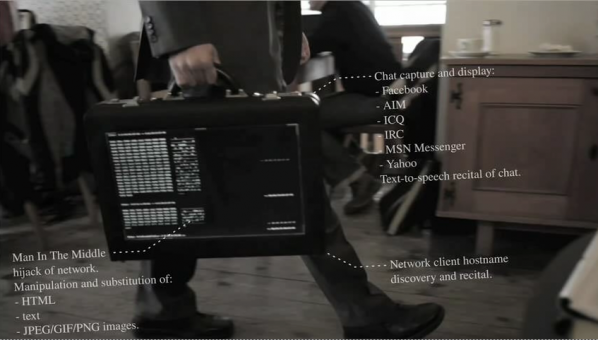
Hacktivism involves many different levels of social intervention and engagement. Whether it is to do with direct action, self-referential geekiness, obscure networked antics, crtical gaming, or peer 2 peer and collective change. Hacktivists challenge defaults put in place by other people, usually the systems imposed upon them and the rest of us by authority. Even though the subjects themselves may be concerning serious matters, humour and playfulness are both essential ingredients.
“A promising tactic for the early Situationists was the unpredictable yet forceful potential of play — what anthropologist Victor Turner termed the “liminoid,” or the freeing and transformational, moments of play when the normal roles and rules of a community or society are relaxed.” [16] Dovey & Kennedy.
One group crossing over from the digital into physical and social realms, is Tiltfactor. [17] Their form of intervention is not necessarily about causing political controversy, but is engaged in reaching people through games of play. Experimenting with social everyday contexts, making games that tackle less traditional topics, such as public health, layoffs, GMO crops. One of the many games creating awareness on these subjects, is POX “Our game actually helps a player understand how a disease can spread from one place to another and how an outbreak might happen” says Mary Flanagan. [18]
A local public health group called Mascoma Valley Health in the New Hampshire region of the US approached Tiltfactor with the problem of the lack of immunization. “At first, a game about getting people immunized seemed like one of the most “un-fun” concepts imaginable. But that sinking feeling of impossibility almost always leads to good ideas later.” [19] Flanagan.
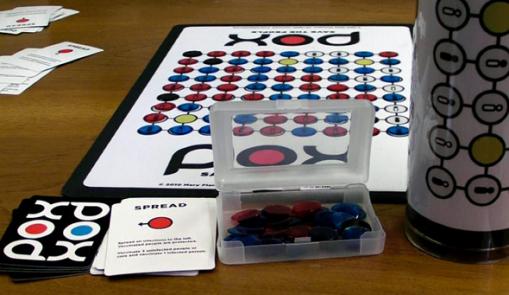
“Geopolitical space has always been a conflicted and fragile topic. Borders and frontiers are changing so fast, that sometimes it seems that our sociopolitical status can change from “citizen” to “immigrant” from one moment to another, or simply live under the “immigrant” status all your life. We’re getting used to words like refugees, enclaves, war, borders, limits –and the list has no end.” Ethel Baraona Pohl & César Reyes
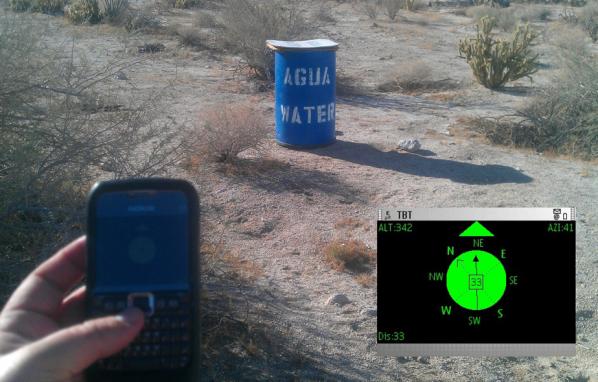
Ricardo Dominguez collaborated with Brett Stalbaum, Micha Cardenas, Amy Sara Carroll & Elle Mehrmand, on (TBT) (and others), on a hand-held mobile phone device that aids crossers of the Mexico-US border. An inexpensive tool to support the finding of water caches left in the Southern California desert by NGO’s for those crossing the border.
“The entire group of artists who are part of Electronic Disturbance Theater 2.0/b.a.n.g. lab working on the Transborder Immigrant Tool (TBT) was being investigated by UCSD and 3 Republican Congressmen starting on January 11, 2010. Then I came under investigation for the virtual sit-in performance (which joined communities statewide against the rising students fees in the UC system and the dismantling of educational support for K–12 across California) against the UC Office of the President (UCOP) on March 4, 2010. This was then followed by an investigation by the FBI Office of Cybercrimes.” [20] Ricardo Dominguez.
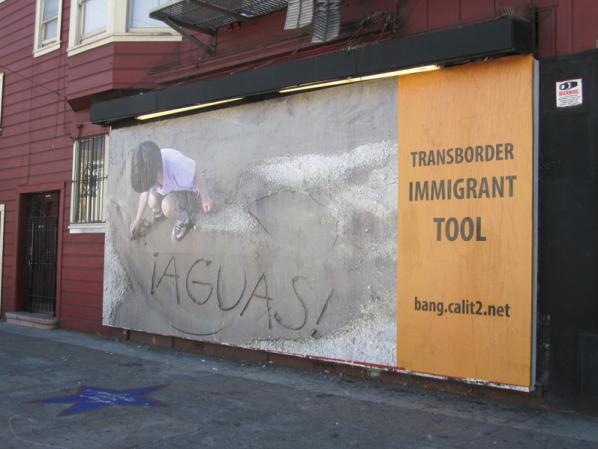
In an interview with Lawrence Bird Dominguez discusses that the TBT is still developing as a gps tool, but infers that it is not just a tool but also ‘border disturbance art’, consisting of different nuances existing as part of a whole with other factors at play. Such as a hybrid mix of things, objects and expressions “artivism, tactical poetries, hacktivism(s), new media theater, border disturbance art/technologies, augmented realities, speculative cartographies, queer technologies, transnational feminisms and code, digital Zapatismo, dislocative gps, intergalactic performances, [add your own______].” [ibid]
“Borders are there to be crossed. Their significance becomes obvious only when they are violated – and it says quite a lot about a society’s political and social climate when one sees what kind of border crossing a government tries to prevent.” [21] Florian Schneider
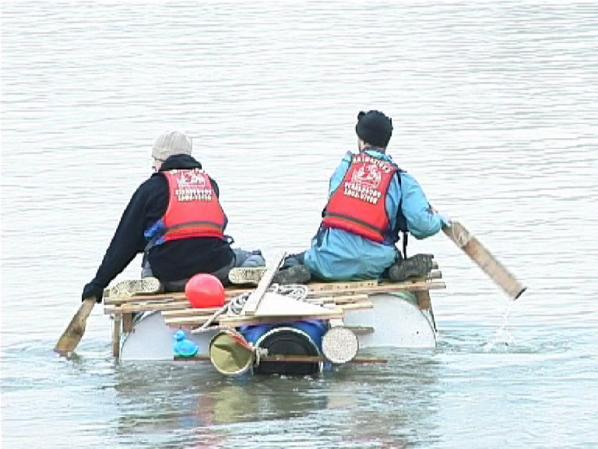
National borders are front-lines of political and social friction. The exerience of asylum-seekers and political migrants reflect some of the most significant issues of our time. Immigration is a toxic issue and unpopular with voters. Bunting’s BorderXing Guide, plays on the fear of invisible alien hordes of people crossing our borders illegally.
The context of this work fits well with issues about borders, whether it is about creating borders online or physical environments. Only those needing to cross a border are allowed access to the site, it is limited to ‘social clients’ who have a static IP (Internet Protocol) address and who, most notably, have gained the artist’s confidence. Such as peer activists and immigrants using libraries, colleges, cultural centres. The site allows those who would other wise end up crossing borders in harmful ways, such as in containers, on the backs of (and underneath) lorries and planes.
Heath Bunting’s BorderXing Guide website primarily consists of documentation of walks that traverse national boundaries, without interruption from customs, immigration, or border police. The work comments on the way in which movement between borders is restricted by governments and associated bureaucracies. It is a manual written not at distance like a google map, but by foot. A physical investigation, involving actually going to these places; trying these discovered routes out and then sharing them with others. A carefully calculated politics of public relations.
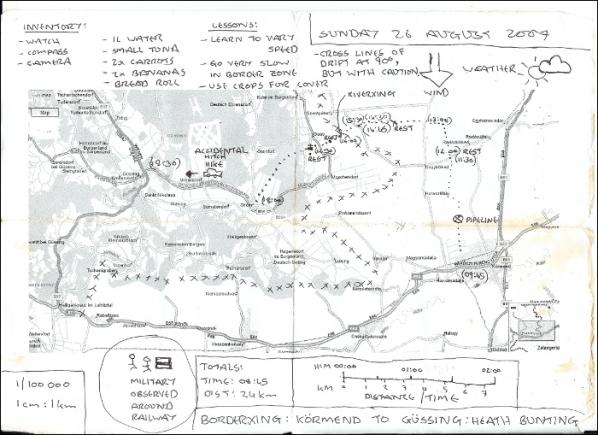
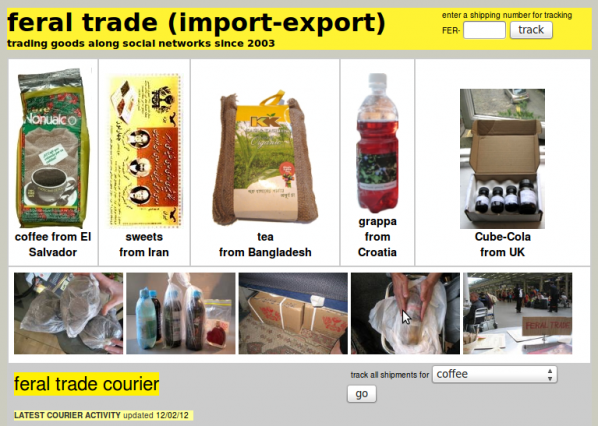
“The Feral Trade Café is more than just an art space that’s a working café, it’s about provoking people to question the way big food corporations operate by looking at the journey of the food we end up scraping into our pampered bins.” [22] Gastrogeek
Feral Trade uses social and cultural hand baggage to transport food based items between cities, often using other artists and curators as mules. Feral Trade products (2003-present), alongside ingredient route maps, bespoke food packaging, video and other artefacts from the Feral Trade network. The goods rangefrom coffee from El Salvador, hot chocolate from Mexico and sweets from Montenegro, as well as locally sourced bread, vegetables and herbs.
Kate Rich uses the word ‘feral’ as a process refering to being deliberately wild, as in pigeon, as opposed to romantic nature wild as the wolf. It is an unruly wild, shitting everywhere, disruption and annoyance in contrast to ‘official’ human structures and connected infrastructures. Feral Trade freight operates largely outside commercial channels, using the surplus potential of social, cultural and data networks for the distribution of goods. Working with co-operatives, small growers and food producers.
The Feral Trade Courier is a live shipping database for a freight network running outside commercial systems. The database offers dedicated tracking of feral trade products in circulation, archives every shipment and generates freight documents on the fly.
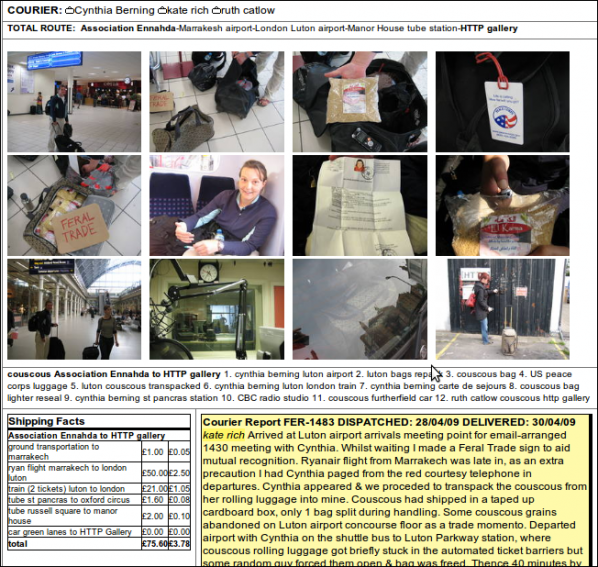
Every shipment is different and has its own story of how and where it was delivered from. Also included is information on who the carriers are with details about producers and their local culture as contextual information. The product packaging itself is also a carrier of information about social, political context and discussions with producers and carriers.
![Feral Trade at Furtherfield's Gallery (2009) [23] Link to exhibition](http://www.furtherfield.org/wp-content/uploads/2012/03/3657297700_42b1c26014_b.jpg)
Since the rise of the Internet individual and collective actions are symbiotically connected to the every day. In a world transformed, common people have access to tools that can change ‘our’ cultures independently; sharing information, motivating actions and changing situations. We know of the Arab Spring, the Occupy movement, Anonymous and Wikileaks and how successful they have been in exploiting technology and social networks. Technology just like any other medium is a flexible material. By tweaking, breaking and remaking ‘something’ you can re-root it’s function, change its purpose.
The links between these mass social movements and the artists here are not just relating to technology’s use but, a shared critique at the same enemy, neo-liberalism.
“”Neo-liberalism” is a set of economic policies that have become widespread during the last 25 years or so. Although the word is rarely heard in the United States, you can clearly see the effects of neo-liberalism here as the rich grow richer and the poor grow poorer.” [24] Martinez & Garcia.
At the same time as highlighting the continual privatization of human society. This form of art practice shows us the cracks of where a social divide of gate-keeping has maintained power within the Western World’s, traditional art structures. We now realize that the art canons we have been taught to rely on as reference are more based around privelage, centralization and market dominance rather than democratic representation or even just pure talent. Hacktivist artists adapt and recontextualize with a critical approach, towards a larger and more inclusive context beyond their own immediate selves. Demonstrating a respect and use of autonomy, and an awareness of social contexts and political nuances, freeing up dialogue for new discussions which include a recognition of social contexts, as a vital ingredient and valued resource in art. Re-aligning, reconfiguring the defaults of what art is today.
Marc Garrett interviews John Jordan and Gavin Grindon about their collaborative publication, A Users Guide to (Demanding) the Impossible.
Published by Minor Compositions
“This guide is not a road map or instruction manual. It’s a match struck in the dark, a homemade multi-tool to help you carve out your own path through the ruins of the present, warmed by the stories and strategies of those who took Bertolt Brecht’s words to heart: “Art is not a mirror held up to reality, but a hammer with which to shape it.”
Marc Garrett: In the introduction of your publication it says that it, “was written in a whirlwind of three days in December 2010, between the first and second days of action by UK students against the government cuts, and intended to reflect on the possibility of new creative forms of action in the current movements. It was distributed initially at the Long Weekend, an event in London to bring artists and activists together to plan and plot actions for the following days, including the teach-in disruption of the Turner Prize at Tate Britain, the collective manifesto write-in at the National Gallery and the UK’s version of the book bloc.”
I think readers would be interested to know how the ‘teach-in disruption’ and the ‘collective manifesto write-ins’ went?
John Jordan: I was not at the first Turner teach-in so can’t give first hand account. From what I’ve heard it was a wonderful moment where the sound of the action penetrated into the room where the Turner Prize were being held, as the back drop of the channel 4 live link up. Kind of perfect, because it was a sound artist who got the award.
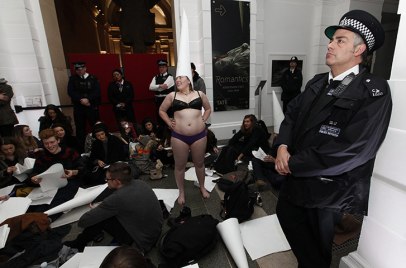
As for the National Gallery event – this was held during the evening after one of the big days of student action. Having spent the day being trampled on by her majesties police horses, a load of us went up to the National Gallery and mingled in front of Manet’s Execution of Emperor Maximillian, opposite a corridor that held a Courbet painting. It was a perfect placement as Courbet of all the 19th artists was really the one who understood the role of art within an insurrection, putting down his paintbrushes to apply his creativity directly to the organising of the Paris Commune of 1871 just as the impressionists fled the city to the quiet of the countryside. Only to return a few years later when Impressionism was launched, as a kind or artistic white wash over the massacres of the Commune, a return to normal bourgeois representation. Courbet had used the rebel city, a “paradise without police” as he put it, as a canvas to create new forms of social relationships and new ways of public celebration, including the destruction of the monument to Empire and Hierarchy, the Vendome column.
Several hundred artists and art students at a given moment sat down and occupied room 43, telling the staff that we would leave once a collective manifesto had been written. Which is what happened. Small groups of 10 or so were formed as the guards and director of the gallery paced up and down unsure of how to react, each group worked on points for the manifesto which were then read out and merged in ‘The Nomadic Hive Manifesto’ – http://www.criticallegalthinking.com/?p=998 – it was an extraordinary moment of collective, emergent intelligence, a reclaiming of a public cultural space from the realm of musefication and representation.
MG: ‘A Users Guide to (Demanding) the Impossible’ features quotes by individuals and groups, who have inspired many of us in the networked, Furtherfield community. But, I am also aware that you may be part of a younger generation, presently experiencing the brunt of education cuts imposed by the current government coalition. Could you explain how these cuts are effecting you and your peers?
JJ: Well I wish I was a younger generation !!! I’m 46 years old, it was written for the youth !! You should talk to some arts against cuts folk, I can put you in touch if you need to?
Gavin Grindon: I’m not exactly ‘the younger generation’ either, but I guess I’m in a strange position between. I recently finished my PhD, so a lot of my friends are either students or just becoming teachers. There aren’t many jobs about, academic or otherwise, and most of them are doing multiple part-time, short-term jobs to make ends meet, without the assumed security or career progression of a generation before, and the cuts are only going to exacerbate that situation. I guess what’s new is a recession on top of these kind of precarious work conditions, which extend far beyond the University. With part-time, hourly-paid and non fixed positions, replacing real jobs.
Of course it’s damaging, but it’s also been inspiring to see students responding to turning over lessons to discuss the cuts and seeing them on the streets. It’s politicised a lot of young people, and there’s an opportunity there. At one of the University’s I work at, it was great to see the art students working together to make protest banners, not in their studios but in the foyer, where other people could see and join in. And when I started talking with them, we began to realise that with all the technical resources of an art school at their disposal, it was possible to be much more ambitious and imaginative than just making banners or placards, the standard objects of protest. But the history of a lot of art-activist groups who had these kind of ambitions isn’t taught, never mind the more popular history of the arts of social movements itself. And it’s not just about knowing and being inspired by some great utopian tales of adventure, or understanding yourself as part of a historical legacy – it leaves you strategically disadvantaged about what can be done. So starting a conversation with these students, was, as JJ says, kind of the idea behind the guide.
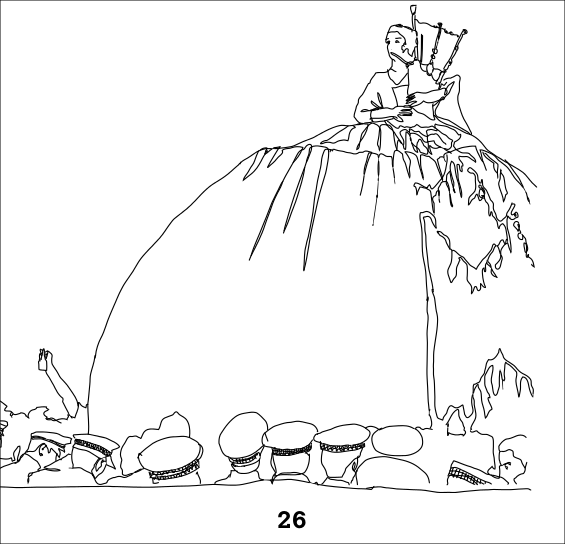
MG: There are various other creative protest groups such as UK Uncut (http://www.ukuncut.org.uk/) and the University for Strategic Optimism (http://universityforstrategicoptimism.wordpress.com/), whom I interviewed live on Resonance FM, December last year (http://www.furtherfield.org/radio/8122010-university-strategic-optimism-and-genetic-moo). Are you connected to any of these creative activist groups, and are there any others in the UK you would like us to be more aware of?
JJ: Yes – I’ve worked with UK Uncut, and was unfortunately arrested in Fortnum and Mason, whilst recording the BBC 4 afternoon play, but that’s another story! There are lots of interesting groups that work on the edge of art and activism, right now a space to keep an eye out for and to visit is THE HAIRCUT BEFORE THE PARTY – http://www.thehaircutbeforetheparty.net/ – set up by two radical young art activists who have opened a hair dressers that offers free hair cuts and political discussion about organising and friendship, rebellion and the material needs to engage in it. The salon is in 26 Toynbee Street, near Petticoat Lane and open till November. It’s an interesting example of a medium to long term, art activist project that attempts to create new forms of relationship and affinity, and sees itself as building radical movement and not simply representing them.
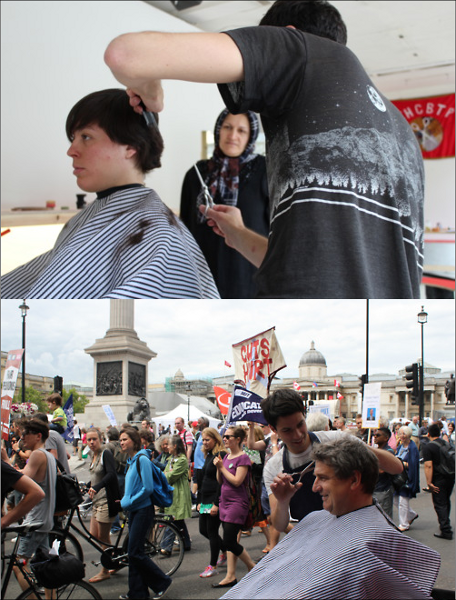
GG: Yeah, again the idea of the text was to build on the connections that are already there, which THBTP does too in a more informal, social way. And for sure, you shouldn’t be seen at the June 30th strikes or UK Uncut’s support actions without a flash new haircut. I should also get a plug in for Catalyst Radio – http://www.catalystradio.org/ a new 24/7 DIY UK-wide activist radio station, which started up the other week and is still growing, and brings together a lot of radical radio projects from around the country.
MG: Do you share a mutual empathy and respect for other protesters elsewhere such as those in Spain and in Greece, and in the Middle East?
JJ: Of course. Although it feels like the camp protests are lacking a conflictual approach and without the mixture of conflict and creativity, protest can easily be ignored, which is a bit what has happened with all the European camps. Although sitting here in the British library its easy to be critical ! Whatever happens, those involved in the camps will have tasted politics, new friendships, alternative ways of organising etc… As for the middle east, its all still in flux, who knows what will happen and the role of artists and musicians has been pretty key in setting the powder kegg alight there..
GG: Yeah, though I think there’s a tension between the symbolic solidarity of occupying city squares and the strategic differences between activist practices in different countries. I think solidarity between these struggles is massively important, though I’m personally not sure how it’s best to manifest that here right now.
MG: In the User’s guide, it mentions the workshops in art and activism at the Tate Modern, held by the Laboratory of Insurrectionary Imagination (Labofii), entitled it ‘Disobedience makes history’. And that Laboffii “was told, in an email, by the curators that no interventions could be made against the museum’s sponsors (which happen to be British Petroleum) [..] decided to use the email as the material for the workshop. Projecting it onto the wall they asked the participants whether the workshop should obey or disobey the curator’s orders.”
What I find interesting regarding this episode is both that a big institution would take the risk of inviting in art and activist culture to their usually, protected environment whilst being sponsored by British Petroleum; and the different forms of controversies reaching the public from such situations. I am surprised that Laboffii would even consider doing such a project in the Tate Modern in the first place, but also pleased, because of the dialogue that has come out of the clash of different political contexts. So, isn’t it the case that we need to explore issues of corporate corruption further within these big institutions so that those who would not usually consider such things are suddenly faced with the issues?
GG: I’m sure JJ has plenty to say about this. But more generally, it depends *how* they function as a platform. An art gallery or a university can be a great discursive space to explore issues, but the bounds of that debate are also strictly limited in lots of ways. This is a problem with the idea of a bourgeois public sphere. Most often, that boundary is that you can debate whatever you like but questioning the basic systemic assumptions on which such spaces rest isn’t possible, at least not in a practical way. The lab’s workshop at the Tate tried to question exactly that kind of assumption about what culture is for, and who it benefits. But for many activists from social movements, who have less faith in the public sphere and its institutions to resolve issues by discussion, that neutered debate is more of a problem than a benevolent gift to the public, and they have to take a different approach. Its not necessarily opposed to those institutions as a whole, but just asks them to make good on what they claim to be.
JJ: It’s a long story, but the key is to be able to put one foot inside these institutions and to be not frightened to KICK. But not to KICK symbolically, to really kick, to really shake them up and to be able to let go of one’s cultural capital. The Labofii will NEVER be re-invited to do anything at the TATE, bang goes all our chances of a retrospective in the fashionable art activism world !!! 😉 But, what we gain is that we were free ! When the curators told us that we could not do anything, could not take action against BP and we refused to obey them, we were free, we could do what we wanted because they could not give us anything in return. The Zapatistas say, “we are already dead so we are free” – when power can give you nothing you want, you can do anything.. this is a very powerful moment. To see the faces of the curators, the head of public, the head of security etc during the meeting where they tried to censor the lab, was priceless – they had always had power over artists, because artists will normally do ANYTHING to get their work in the Tate, but we did not care, we cared about the politics, about the actions, about climate change and social injustice – we were more powerful than the institution in that moment because we were no longer dependent on them.. it was one of the most beautiful moments… and now the movement against oil sponsorship is spreading everywhere. The message is simple, give up your cultural capital throw away your dependence on these institutions and be free…
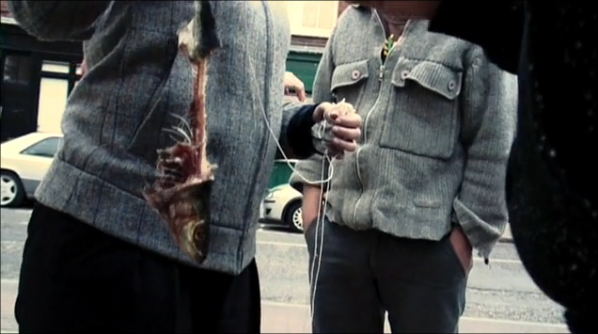
MG: I come from a background of hacking, social hacking and D.I.Y culture, and instead of going to University I chose to be self-educated, creating alternative groups for self discovery and art with dedication to social change. And even though, many are fighting the education cuts right now, what are your own ideas around self-education, do students really need to go to college now that there are so many different forms of information and ways in creating one’s own place in the world ‘with others’?
GG: A lot of experiments with autonomous self-education have sprung up recently which ask just this question, like the Really Free School (http://reallyfreeschool.org/), there are even some more institutional business-model experiments online with peer-to-peer education. But at the same time the catchment of both of these is relatively narrow at the moment, so I think there’s still a place for these kind of education institutions, and there are interesting radical experiments going on all over, either by individuals or whole departments, although the cuts to institutional funding for education by the government changes the playing field again, so there’s an opportunity for something like this to become less marginal, both inside and outside the university.
MG: JJ, In 2005 you wrote, Notes Whilst Walking on “How to Break the Heart of Empire”, in it you write “Radicals are often vulnerable souls. Most of us become politically active because we felt something profoundly such as injustice or ecological devastation. It is this emotion that triggers a change in our behaviour and gets us politicised. It is our ability to transform our feelings about the world into actions that propels us to radical struggle. But what seems to often happen, is that the more we learn about the issues that concern us, the more images of war we see, the more we experience climate chaos, poverty and the every day violence of capitalism, the more we seem to have to harden ourselves from feeling too much, because although feeling can lead to action we also know that feeling too much can lead to depression and paralysis…” How the hell do you remain positive when you know how many horrible and disgusting things are being done to decent folks and the planet all of the time?
JJ: Unfortunately there are no magic recipes that can protect us from such feelings, a lot depends on context on our particular situations etc. But here are a few tips that have helped me keep the despair of capitalism at bay:
1) Resist the spell of individualism that capitalism tries to weave around us, a spell that chains us to the fantasy of autonomy and keep us in a state of sadness and paralysis. Break this spell and its toxic chains by realising that you are part of a greater whole, that working with others gives us strength, that seven minutes making real friendships (face to face) is more political than seven days glued to a computer browsing social networks in a trance, that inevitably fails to shake the loneliness of modern life.
2) Build a gang, a group, a collective, a crew – remember the joy of plotting things together, the power and possibilities when work and imagination is shared. In fact, imagination finds it’s insurrectionary potential when we share it, when it’s freed from the privatised ego, escapes from shackles of copyright and the prison’s of the art world.
3) Learn the skills to work together with others, consensus decision making, group facilitation, conflict resolution etc. We need to re learn collective working methods, capitalism has destroyed all our tools of conviviality and we need to reclaim them back, recreate new forms of being together.
4) Redefine Hope. Not as something that will come and save us, like a saviour, but as something that comes from not knowing what will happen next, something that takes place when we act in the immediate moment and don’t know what will happen and trust that history is made from acts of disobedience that did not necessarily have any idea of what the next step was…
5) Remember that victory is not always what happens, but what did not happen. Social movements tend to forget this. Look at all the nuclear power stations that WERE not built, all the wars that did not happen, the laws that were never passed, the free trade agreements that were never agreed on, the repressions that the state could not get away with, the gmo’s that were never planted. One of my favourite books, what I call prozac on paper, is Rebecca Solnit’s HOPE IN THE DARK (http://www.goodreads.com/book/show/28048.Hope_in_the_Dark) – it’s a lovely little book which redefines hope in the most beautifully optimistic way, recommended reading when capitalism seems irresistible.
6) When everything appears useless, try to change your conception of time… think deep time, not shallow modern now time, but think about the generations that went before you and those that will come after you. Try to imagine what the generations of the future will think about your actions, imagine those from the past that fought for the emancipation of slaves and yet never saw the results of their actions, those who died for the eight hour day, for the right to build a union, the right to vote or publish an independent magazine. Spend time imagining how those alive in 50, 100 years will view your life and work…

MG: In the publication, you mention Marx and Debord. “We can all be engineers of the imagination”…”that our “general intellect”, all the collective knowledge and skills we use in making things, are taken away from us and embodied instead in the machines of our work. What would happen if we somehow re-engineered these machines if we did what Guy Debord argued and started, “producing ourselves… not the things that enslave us.” Do you see the recent cuts across the board as an example of how the powers that be are actively dis-empowering the working classes?
GG: Definitely. The cuts aren’t just about an experience of ‘austerity,’ however long term, but constitute a historical attack on poor and working people. They’re an attempt to technically recompose the material of the institutions, structures, ideas and habits people live through, in order to limit their ability to resist and remake them for themselves. In factory production, that involved the local restructuring of machine-labour, but later at a wider level Keynesian economic restructuring. This neoliberal restructuring of education is an extension of capitalist discipline into a new area, an attack on a social space which has historically been a base for social change. The government has made this pretty clear by, for example, David Willetts’s dictate amidst these massive cuts, to the Arts and Humanities Research Council, that the Tory party’s vacuous advertising slogan “the big society” become a core research area, replacing the less ideologically narrow area of ‘communities and civic values’; and the Department for Business and Innovation’s concomitant rewriting of the 1918 Haldane principle, that research directions are best decided by researchers through peer review.
The optimistic take on this is not that it’s an inevitable recuperation of resistance, which was the position Debord tended towards in the end, but that capital is always on the back foot – that its own developments are driven by and a response to social movements. That it’s an open dialectic (or if you prefer, not a dialectic at all). There’s a kind of neurosis to it, although rather than excluding the other to maintain its ego, the state is including everything to stave off other possibilities – you can see this in the language. The whole discourse of ‘participation’ and networks in business (and since the 1990s, also in art), is as Boltanski and Chiapello observed in their book the New Spirit of Capitalism, a recuperation of the language and terms of 1960s social movements – movements which first properly gave birth on a mass scale to the kinds of self-consciously autonomous and creative politics, or art-activism, which we talk about in the guide. Likewise, the big society is focused on mutuality, and there’s a strange recuperation of libertarian and radical thought by the thinkers behind it like Phillip Blonde. In this case, you’re left with a stunted vision of the anarchist idea of mutual aid, without any institutional aid, and structurally limited mutuality. But rather than simply critique this, I’m interested to look at how we might otherwise structurally and materially embody other kinds of social relation. Obviously this starts on a much smaller scale, and is often more directly materially embodied. University departments’ attempts to support radical philosophy within existing institutions and setting up new autonomous radical art institutions are two possible, but not mutually exclusive, directions here. As, of course, at the most local, accessible level, are the art-activist practices and objects we discuss in the guide.
Our new book-film is out “Les Sentiers de L’utopie”
Free online (in french) : http://www.editions-zones.fr/
Our blog: http://lessentiersdelutopie.wordpress.com/
our twitter: @nowtopia
3 different links to download the publication:
http://www.minorcompositions.info/usersguide.html
http://artsagainstcuts.wordpress.com/2010/12/06/a-users-guide-to-demanding-the-impossible
http://www.brokencitylab.org/notes/required-reading-a-users-guide-to-demanding-the-impossible
The Font used was Calvert is by Margaret Calvert, designer of our road signs.
Words: Gavin Grindon & John Jordan Design: FLF Illustration: Richard Houguez Original Cover: The Drawing Shed Produced by the Laboratory of Insurrectionary Imagination, London, December 2010. www.labofii.net Anti-copyright, share and disseminate freely.
More about Minor Compositions – a series of interventions & provocations drawing from autonomous politics, avant-garde aesthetics, and the revolutions of everyday life.
http://www.minorcompositions.info/
Crude awakening: BP and the Tate. The Tate is under fire for taking BP sponsorship money. Does corporate cash damage the arts — or is it a necessary compromise? We asked leading cultural figures their view. Interviews by Emine Saner and Homa Khaleeli. guardian.co.uk, Wednesday 30 June 2010. http://www.guardian.co.uk/artanddesign/2010/jun/30/bp-tate-protests
“Festival of Ideas For A New City” organized by the New Museum, The Architectural League, The Bowery Poetry Club, C-Lab, Columbia University Center for Architecture, Cooper Union, The Drawing Center, NYU Wagner, PARC Foundation, Storefront for Art and Architecture, and the Swiss Institute blossomed like spring in New York City from May 4 – 8th, setting out to “harness the power of the creative community to imagine the future city and explore the ideas destined to shape it.”
Keynotes addressing the issues were architect Rem Koolhaas, virtual reality inventor Jaron Lanier, and former President of the National University of Columbia, and former Mayor of Bogota, Antanas Mockus. A StreetFest set up along the Bowery with over 100 local grassroots organizations and small businesses “presenting model practices and products in a unique environment.” Over 100 projects, events, performances and walking tours expanded on the Festival’s themes.
Rem Koolhaas with OMA and The New Museum showcased CRONOCAOS, an exhibit examining the growing “empire” of preservation and destruction and the consequences of how we build, rebuild and remember. What is the role of preservation on the art world? As larger and larger spaces are repurposed for art from industrial spaces they focus on the “apocalyptic sublime,” mimicking Hollywood and B movies. Oddly enough Koolhaas noted, this increase in preservation closely parallels the rise of Wall Street and tourism.

There were panels on “The Heterogeneous City,” “The Networked City,” “The Reconfigured City,” and “The Sustainable City.” At night curator Anna Muessig’s Flash:Light Nuit Blanche event included murals along the Bowery, art projections on Nolita and Lower East Side buildings, and music and performances including projects on the facade of the New Museum and St. Patrick’s Old Cathedral in Little Italy. There was also a 3D video installation Civilization reinterpreting Dante’s Diving comedy.
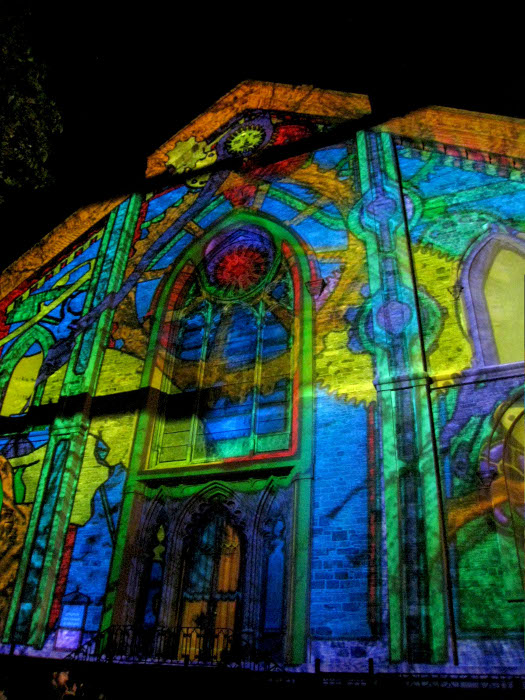

Jaron Lanier’s Keynote address on “The Networked City” at the Great Hall at Cooper Union reiterated many of the themes in his new book, “You Are Not A Gadget.” Not one to follow any set path, Lanier began his talk by playing a Laoitian “Ban Lao” (Ban Bang Sai Kai) bamboo wood pipe. He declared the simple reed flute was one of the first holders of digital information, even older than the abacus, because each reed object and note is turned on and off just like a series of digital 0’s and 1’s. The Ban Lao, traded across the Silk Route was noticed by the Greeks and Romans, and influenced the development of the pipe organ. The pipe organ was automated and turned into a player piano, a programmable loom, and finally became the origins of Charles Babbage’s computer.
Computers have gotten better Lanier explained, processing more and more bits, but humans still have more precise acuity at the level of quantum physics. They can respond to just one photon. He then veered off topic discussing the first computer scientist Alan Turing who used computers to crack codes during World War II. Persecuted for being gay, he was injected by authorities with female hormones which gave him breasts and made him suicidal. Just like Snow White, he killed himself by eating a poisoned apple.
He then veered back on track saying using computers as metaphors to the human condition is an irrelevant, outdated metaphor. The brain is not a CPU, and eyes and ears are not USBs. A better metaphor is thinking of the head as a spy submarine performing spy missions. You are constantly moving your head seeking out data, not passively seeing it. Your visual system is sensitive to minute differences. A musical instrument is an additional instrument to the sensory motor loop that makes perception possible. Can we build digital tools that are as sensitive as we are? This, he noted, was one of the key questions now facing computer scientists.
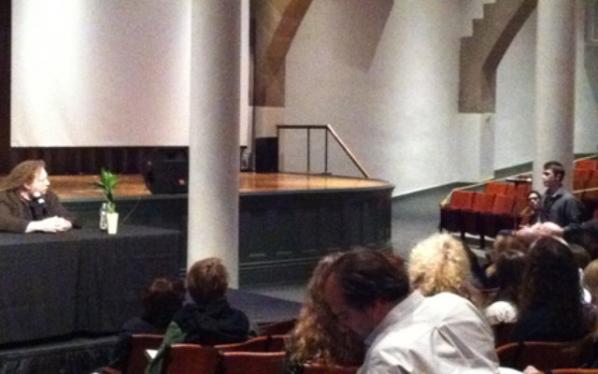
New technologies are usually developed to become weapons. But many important inventions were first developed for music. Musical bows existed before arrows, and guns developed from the casting of metal bells. Even Hewlett Packard’s first object was a musical synthesizer. Music is a driver with innovation taking place around making sounds.
In order to make his lecture relevant to the “Networked City” theme of the festival, Lanier discussed his favourite thing about New York City, that the same sense of acuity as applied to musical instruments also applies to personal interactions. More diversity means you have more chance of connecting with someone who will change your life. The fates of people in New York are guided by their activities. Its important that the fates concern an extra world of human to human contact.
In such a huge network context people are sensitive to subtle motions in each other, and can identify subconscious communication we don’t really know about. Contrast that to sound networking, where digital music does not give you the subtle minute accuracy of acoustic sound. People who only communicate virtually are spinning their wheels in place. When we connect to each other through digital representations we lose some form of expression.
Lanier proselytized for the necessity of the “head and the heart”, insisted technology needs to bring better jobs to society than the ones they are destroying. The basic social contract he said was turned back 11 years ago when advertising became the new way to get information. Sergey Brin, the co-founder of Google was the one who started it. Because digital technology is cheaper, cheaper just gives this stuff away for advertising. But, when you take the products of people’s hearts and minds, such as their music and literature, and give them away for free this becomes a problem. When you put effort into a promotion on line you get the illusion of benefits, but you actually lose relative advantage. This is because the true customers of a social networking site like Facebook is not you, you are actually the product of Facebook. You are sold and the customer pays to influence events. This is the difference between overt and covert information with Lanier stating, “The official business of computation is advertising.” At some point though, there is nothing to advertise. If cars can drive themselves, what happens to truck drivers? Or if 3D machines make fabrications they make manufacturing obsolete.
The Japanese are creating elder care robots. We are making ourselves unemployed. The fashion of making everything free leads us down a path from a city of dreams to a cry of despair. We have to figure out a way to change our relationship to information technology, instead of chasing after users and followers and making more money. Ending his lecture he declared, “We must humanize digital architecture – We must see beyond fads.” And then he played a little ditty on dual Gypsy flutes.
Featured image: Healing Station. mixed media, interactive installation, size variable. Christy Matson and Jon Brumit, 2009.
The New Materiality: Digital Dialogues at the Boundaries of Contemporary Craft.
March 10–June 12, 2011
Decorative Arts Gallery
http://www.mam.org/exhibitions/details/new-materiality.php
For the first half of the 20th century, curator Fo Wilson reminds us, the practice of craft was heralded as a “remedy” to how human values were changed by the Industrial Age. Here the hand-made was given privileged status over the machine-made, and thus craft forms gifted new value through the artisan. In the latter part of the last century, as the world moved from apprenticeship and artisanship to a more intellectual and theoretical-based framework for valuing contemporary art, so too have craft practices and discourses been challenged. This rethinking of craft has accelerated in the last several years, with books like Glenn Adamson’s Thinking Through Craft and Howard Risatti’s A New Theory of Craft (both 2007), both arguing for conceptual rigor and provocative possibilities within craft as a discipline.
The New Materiality: Digital Dialogues at the Boundaries of Contemporary Craft, an exhibition that began at the Fuller Craft Museum and is currently up at the Milwaukee Art Museum (MAM) until June 12, follows on and extends current trends in contemporary craft. It engages not only with craft’s reinvigoration as a creative practice and discourse, but with how these have been shaped by, and also transformed, new technologies, new designs, new materials and new ideas. Wilson’s exhibition and events make discussions around Art or Craft, Art or Design, Digital or Hand-made, and Conceptual or not seem, in a word, quaint; she engages with a broad set of materialized ideas that divide and relate across the artistry of craft, the ephemera of technology, and the theoretical frames of post-conceptual art.
The exhibition can perhaps best be summarized through the work of the four exhibiting artists/artist teams that spoke at the “Dialogues on Innovation” panel at the Milwaukee Art Museum on April 16th. Collaborative artists Donald Fortescue and Lawrence LaBianca, for example, spoke to Milwaukee activist and printmaker Nicholas Lampert about their piece, Sounding. This work consists of a huge, custom built cabriole-legged table, which was initially filled with beach rocks and sunk to the bottom of the ocean. There it lay, for two months, with a hydrophone to record the ambient sounds of the sea, including the overwhelming swish of waves, the low hum of slow-moving current, and the activity of sea life – the most prominent being the continuous clicks of what must be shrimp in its vicinity. When the artists’ creation reemerged, it brought the bottom of the ocean with it: all the messiness and stink and poetry of the sea – barnacles, rusty parts, plant life, fish scents, mystery and more. It is exhibited with an over sized hornlike funnel, a huge phonograph tied together with zip ties, to amplify the recorded sound.
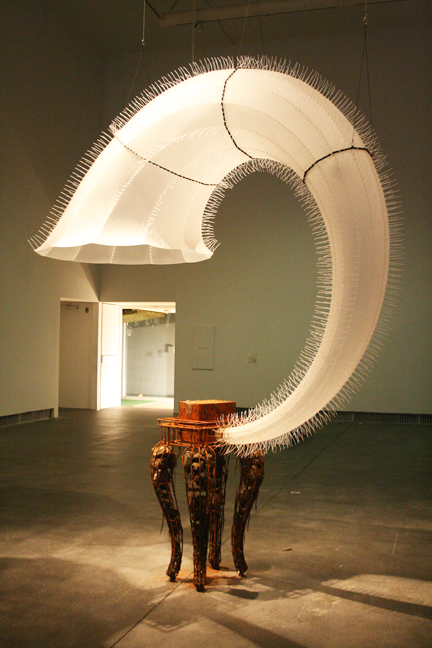
Sounding, avowedly inspired by Captain Ahab’s hunt for an un-killable whale, acts as a kind of parallel to the ongoing hunt for singular disciplinary focus in craft. The piece dives into the sea, hits “rock bottom,” and looks as if it barely survived; and on its return, we see that Sounding is far from a singular entity. Yes, it is trashed and torn, but it’s also imbued with literal life, entwined with technical innovation, and rich with stories of its journeys. Like the theories and practices behind the current craft movements, it came back more beautiful, more visceral, more sensory, and more technological than it ever was: a new materiality.
You can listen to or download Sounding file here:
http://www.furtherfield.org/audio/Soundings-1.mp3
My discussion with artist Christy Matson revealed an exploratory practice that shifts between digital and hand-made, generative and interactive, and always with an eye towards the implications of each. Soundw(e)ave, her piece on show, is a self-referential textile, where the actual sounds of computerized Jacquard looms were used to create woven compositions. Her noisy sound waves were turned into three patterned pieces of fabric, made by hand-operated, computer-assisted and fully automated (Jacquard) looms, respectively – each weave growing progressively denser with the more advanced technologies used in their production. The piece, says Matson, was a huge turning point in her practice; it pointed her towards a kind of digital craftsmanship, where she was better able to place value on the ideas, materials and skillfulness needed to be an artisan across contemporary digital, craft and art domains.

Soundw(e)ave, generative weaves, triptych (each 34″ x 54″). Christy Matson, 2004.
For example, Matson then began weaving copper wire directly into her fabrics, and, using the magnetic waves our interactions generate and alter, engendered new aural compositions. In other words, her sonic sculpture turns cloth into a Theremin, where movement and hand-waving at the gallery are transformed into the kinds of musical gestures often associated with science-fiction films of the seventies. While Matson’s earlier, sound-generated works were generative and performative on some level, here she moves into real-time interaction, invoking our embodied relations to textiles, craft, technology and language, all in one fell swoop.
healing station, a collaboration with Jon Brumit and quite possibly the most complex of Matson’s installations thus far, sees piezo sensors placed inside of swaths of fabric to pick up the ambient sounds of the room – including gallery-goers, passersby, street sounds, and the minute vibrations in the fabric itself. This lovely noise is then fed back into the space with bass shakers: speakers optimized for sending waves into solid media rather than air. Viewers can literally feel the low hum of presence, absence and movement as the textile, bodies and room speak at and to one another in a perpetual feedback loop of embodied music. The small crowd at the MAM laughed along with Matson when she relayed a story in which her wired-up piece, and its feedback, caused a small fire at one of its showings – quite a performance, indeed.
Tim Tate artfully explained to Milwaukee staple Tom Bamberger that nowadays “craft” is a starting point rather than an end point. I’m paraphrasing here, but he treats craft as an approach, a space of understanding materials, what they’re good at, perhaps their “habits,” and most certainly their implications. Here, narrative, function and the conceptual are always already implicated across technique – whether new or old – and value is derived from a contextual corpus.
Tate’s work is itself a beautifully resolved hodgepodge of hand-blown glass, hi-tech LCD screens, and visceral videos of typewriters and books, all literally tied together with plastic (zip ties again – don’t knock it ‘til you try it!) around a printed circuit board. In Virtual Novelist, for example, miniature monitors display the aforementioned “dead media” tools from behind artefactual casings of glass. Atop are beguiling sculptural homages to each of the gone-but-not-forgotten analog recording devices of yesteryear.
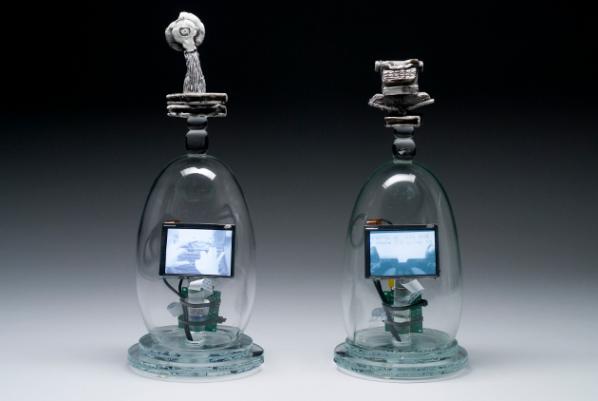
Bamberger is a smart artist with a quick wit, and Tate is similarly not one to spar with unless you have a good grasp of the discourses at hand. In this lively thirty-minute discussion, the two managed to disarm the Art vs Craft debate as both unproductive and long-since over, and open up possibilities for “ornamental aesthetics” in time-based media. Here the implication was that, following Tate’s lead, video objects and installations could place more emphasis on the object and installation – rather than the video – and use each as an equal material that informs and plays off of the other; the video and screen need not be the central focus.
Sonya Clark then told us how she views her practice as a fiber artist as similar to how author Toni Morrison views her own writing practices. In one of her essays (found in several publications, including a collection entitled What Moves at the Margin), the latter tells a story of the Mississippi River, which was laboriously straightened for travel and transport by boat. Every so often, the river floods; but, Morrison goes on, it’s not really flooding. It is remembering. The water is trying to get to where it belongs, to re-member, to embody again. Morrison says writers do the same with their texts; and Clark claims that she remembers through her materials. Originally trained as a fiber artist and now working across found objects, digital art and more, Clark’s practice sees her reclaiming forgotten histories, and giving them greater potency through her processes and media.
Clark discussed this approach with longtime friend and former colleague, UW-Madison Professor Henry J. Drewal – one of the foremost thinkers surrounding African Art. Clark’s brilliant work on the exhibition, a portrait of Madam CJ Walker, is constructed entirely out of small, acrylic and thin toothed, black hair combs. She overlays the combs and removes some of their teeth to make a huge, grayscale, and literally bit-mapped image.
Madam Walker, the first ever female millionaire in America (and African American to boot), made her fortune selling beauty products to black women hoping to straighten their hair – as was the fashion of the time. And so Clark utilizes her combs, with their own memory, narrative and political weight, to construct a lo-resolution digital image. This exceptional work manages to explicitly straddle issues of race, gender, class, memory and materiality on its very tactile surface, and implicitly engage with the contemporary conceptual frames of digital art and data, in its transcoding of the image from one form to another, and craft, in the final material and hand-made form it takes.
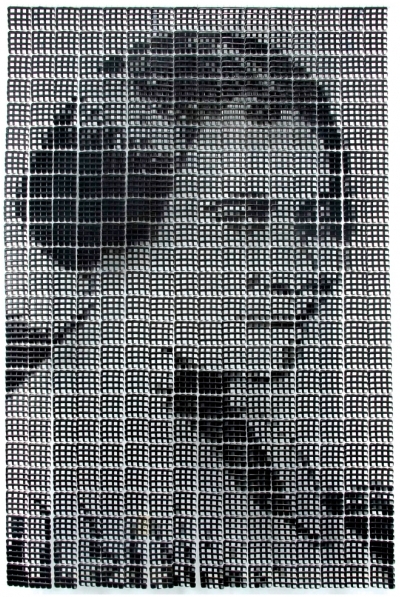
Clark finished with the generous idea that, at present, all art work is collaborative in that it fits into broad social and cultural contexts, builds on extant technologies, and is produced, received, and engaged with outside of the individual’s studio. And Drewal concluded by declaring that technology has always been at center of the arts in the form of new techniques. When something comes into the world, he went on, whether technical or formal or as an image, artists take it someplace else. They “turn common objects… into uncommon things, stretching our imagination and the world” along with them.
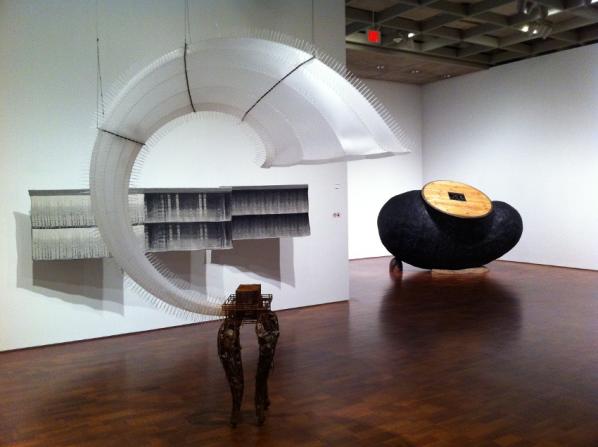
These are just a handful of the works in The New Materiality, by four of the artists represented in our discussions – not even all the works they contributed, much less those of the other artists, which include Brian Boldon, Shaun Bullens, Lia Cook, E.G. Crichton, Maaike Evers, Wendy Maruyama, Cat Mazza, Nathalie Miebach, Mike Simonian, Susan Working, and Mark Zirpel.
It is a show that, in its entirety, succeeds in stretching our imagination, through its expansion of craft, art and digital forms, and what they individually and collectively mean today.
Nathaniel Stern (USA / South Africa) is an experimental installation and video artist, net.artist, printmaker and writer. He has produced and collaborated on projects ranging from interactive and immersive environments, mixed reality art and multimedia physical theatre performances, to digital and traditional printmaking, concrete sculpture and slam poetry http://nathanielstern.com.
‘Made Real’, an exhibition by Scott Kildall and Nathaniel Stern, the founders of Wikipedia Art. Can be seen at Furtherfield’s Gallery from 27th May 2011 http://www.furtherfield.org/exhibition/made-real
Featured image: Radion at NetAudio London festival 2011.
NetAudio London Festival, 13th – 15th May 2011.
A three day festival that explores music environments in the digital age of networked technologies. http://www.netaudiolondon.org/
Marc Garrett interviews Andi Studer of NetAudio London, about their latest Festival at the Roundhouse and other venues in London, from Friday 13th – 15th May 2011. Showcasing work of artists who use digital and network technologies to explore new boundaries in music and sonic art, their festivals encourage participation in all forms: interactive sound art installations, conferences, workshops, collaborative online broadcasting and headline shows. This year promises to be a special event, headlined by the legendary Nurse With Wound and many more – read on.
Marc Garrett: This seems like an amazing festival. Not just because it’s context relates to my own background and Furtherfield’s own connected communities and its history in exploring an engagement of contemporary, networked creativity which was once perhaps, considered to be at the edge of art. But now, it does seem as if a new passion is alive and kicking, representing what exists across the genres of art, technology and social change.
The Netaudio London festival began its life in 2006, why did you chose to set up such a dynamic and involving festival, and who are your influences?
Andi Studer: The first Netaudio London grew out of a general passion for electronic music, combined with the recognition of a booming netlabel scene distributing new music with CC licenses for free download. Culturally it spanned the three fields of club culture, avant-garde music and net-politics. During the research phase, we came across of string of European festival projects with the same scope and decided to align with them, so after Netaudio Berne and Cologne, in 2005, London took it’s turn in 2006. Over 3 days we presented more than forty acts in club as well as gig settings; we hosted cultural discussions, organised a knowledge fair around digital music distribution and premiered an the audio installation by Si_COMM, S.E.T.I and N-Spaces… good old days!
MG: What do you feel is important about the Netaudio festival and how does the current one relate to contemporary culture?
AS: Netaudio aims to play an active role in the ongoing process of exploring how technologies, and particularly the Internet, shape our lives. Within this vast field, we focus our work on sonic culture, music and sound art, but reach out to wider aspects such as politics and protest or collaborative creativity.
Whereas in 2005/06 much of the cultural discussion was driven by an incredible optimism about new communication and distribution channels, this year’s festival may pick up on something best described as ‘cyber realism’. The festival, and particularly the conference, building on our 2010 research project, presents a strong case for individuals taking action. And in process of so doing, we are interested to explore what emerging digital tools they use to create new sound art/music, as well as in the social and political endeavours related to their creative work.
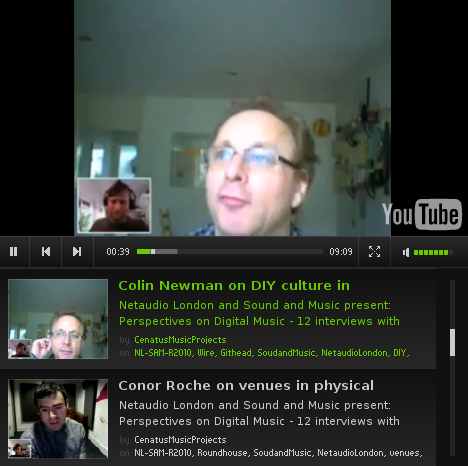
MG: Why chose to include those who have a history in net art, critically engaged thinkers invlolved in networked culture, and many who have been and are part of the (new) media art generation?
AS: We recognise a continuation of creative and socially aware work, enabled by network technologies. Including emerging as well as established projects, some dating from well before the WWW time, allows us to show this continuation and hopefully furthers the wider understanding of these different elements/groups. Whilst there are clear differences between them, there are also many overlaps and we hope that the inclusion of as many as possible in the debate and the wider festival allows for an exploration and greater understanding of these overlaps, and differences.
MG: Your festival includes a visiting member from UK Uncut who will be discussing with others at the Conference and Workshops, regarding the proposed theme of ‘politics and protest; creativity and collaboration; digital futures and analogue survivals.’ They have made headline news regarding their activities challenging the government’s ongoing cuts, and have been actively involved across the country targeting corporate tax dodgers and the banks who caused the financial crisis.
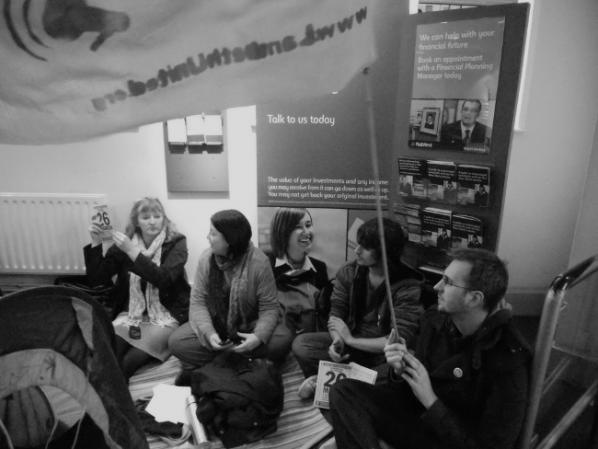
Do you think that UK Uncut’s own perceptions and its activism reflect the festival audience’s general interests and feelings on the matter, across the board?
AS: The participation of UK Uncut is confirmed, but the speaker is to be announced. Whilst some festival audience members may be sympathetic with UK Uncut’s perceptions and activism, others may not. Similarly, whilst members of the festival programming board may have sympathies with UK Uncut’s cause, the festival as such does not necessarily share the same cause with UK Uncut. The reason for inviting UK Uncut was their very successful work as a technology savvy protest movement, as well as their exploration of new forms of protest, particularly sit-ins involving poetry readings and the singing of songs. We are interested to find out more about how they use technology and music/sound in their cause. Presented in a panel with Jeremy Gilbert, Mark Fisher and Anthony Iles, we hope to show how their work sits within the incredible role music had and continues to have in social, political and economic protest.
MG: Nurse With Wound is headlining the festival and they are legendary in the underground music scene. Spanning a career of 30 years plus, under the curatorial guide of Stapleton who has seen NWW collaborate with a highly respected troop of free thinkers including David Tibet (Current 93), William Bennett (Whitehouse) and Andrew McKenzie (Hafler Trio). Many artists who have been working with technology and similar experimental genres, are influenced by those of industrial and avant garde music scene, such as Throbbing Gristle, Cabaret Voltaire, Virgin Prunes, This Heat and NWW, so it seems fitting to have them in the festival, with their peers and of course, an equally interesting selection of younger sound artists and musical explorers.
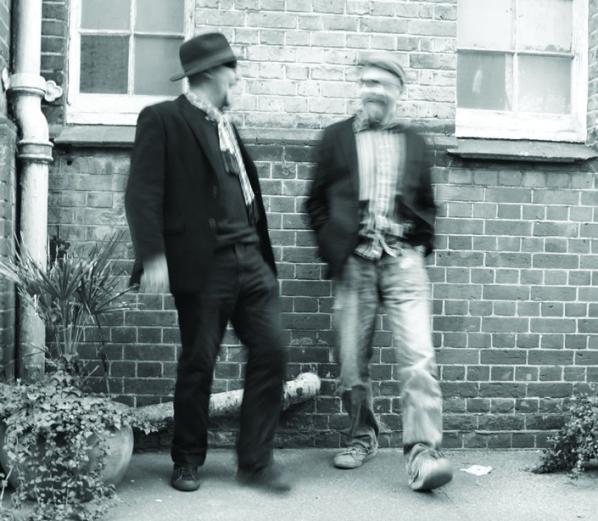
It may say seem like the perfect decision now, but how did you come to the idea of asking Nurse With Wound and what are the links with the other aspects of the festival?
AS: To have Nurse With Wound headlining our festival is a dream come true. Their achievements in anarchic, experimental, DIY, post-industrial music is unparalleled, and it is possible to find many of their approaches in the current new music produced by emerging musicians. This is something we hope to draw on in the rest of the festival.
At KOKO we will also present a newly commissioned live collaboration between Bruce Gilbert (ex-Wire) and Mika Vainio (ex-Pan Sonic). This opportunity to present new work came about though the direct continuation of an ongoing enquiry into collaborative creativity, as featured on one of the three conference panels. This is definitely also a strong theme in the work of Radian, the opening act at KOKO.
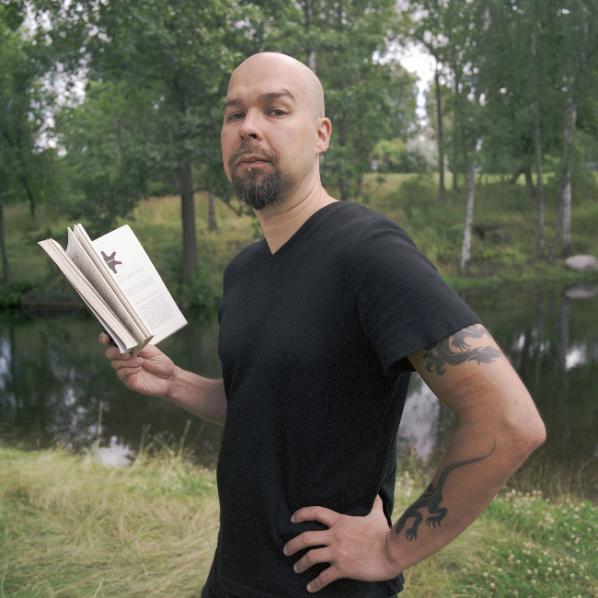
I’d urge anyone who is coming to see NWW at KOKO, to join us at the Roundhouse for the afternoon programme, particularly the conference, but also with the Open Platform stage, we hope to showcase some glimpses of the NWW legacy.
It may be worth mentioning the broadcast strand of the festival here too. Enabled by the Roundhouse Studio facilities and with creative input from Ed Baxter of Resonance104.4fm we are able to feed the festival back to the online domain for the first time. Throughout the afternoon of the 15th May, we will present a live web-zine, thereby leading an enquiry into the future of broadcasting. As part of this we will present three new pieces of work by the commissioned artists: Stefan Blomeier, VHS HEAD, and Liliane Lijn, the latter presenting an online adaptation of her Power Game project.
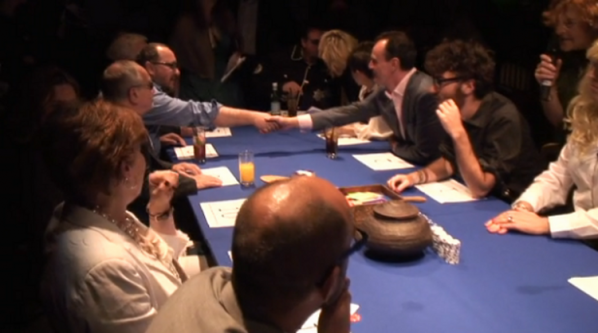
MG: This interesting development warrants investigation, not only because there is an an influx of new interest from a much larger informed and adventurous audience across the board but also because it represents an obvious, cultural dynamic at work. Reflecting a ‘real’ contemporary interest for something different to happen, beyond the remit of normative, art world restraints and its usual, hermetically sealed approaches. We will definitely be there ourselves. To experience what promises to be an engaging and critical conference, but also to explore and enjoy the other varied live events and projects.
The Conference – will bring together theorists, practitioners, activists and academics to address a challenging set of themes in 21st-century culture, featuring speakers including Matthew Herbert and Cecelia Wee: politics and protest; creativity and collaboration; digital futures and analogue survivals.
http://www.netaudiolondon.org/2011/strand/conference
Sound Art – In partnership with Call& Response Netaudio presents an event of 8-channel immersive audio-works. The dynamic and varied explorations of the nine prolific artists brought together by Call& Response highlights the vibrant and diverse field of contemporary sound art. Also there’s the Sonic Maze, an immersive series of sound art installations set in the Roundhouse Studios. http://www.netaudiolondon.org/2011/strand/sound-art
Broadcast – Using the format of a live webzine, Netaudio Broadcast will explore the future of broadcasting with a series of video and radio features. Netaudio Broadcast is co-curated with Ed Baxter of Resonance104.4fm. http://www.netaudiolondon.org/2011/strand/broadcast
Live Music – Starting at cafe OTO on 13th with Robert Piotrowicz (http://www.myspace.com/robertpiotrowicz) and Valerio Tricoli, continuing at Apiary with the runsounds hosted late night event; and the main live show of the festival, a rare live appearance from Steve Stapleton’s Nurse With Wound (http://en.wikipedia.org/wiki/Nurse_with_Wound), a special commission performance by Bruce Gilbert (ex-Wire) and Mika Vainio (ex-Pan Sonic) and Radian.
The 2011 Netaudio London festival supported by the National Lottery through Arts Council England and by the Austrian Cultural Forum London. It is presented in partnership with The Wire, ResonanceFM and Last.fm and supported by the Roundhouse and many more.
Featured image: Nightingale’s Playground Chapter Selection
Andy Campbell is a UK writer who has been experimenting with new media fiction since the 1990s, when he started creating stories on floppy disc for the Commodore Amiga. By 2000, when I first came across him, he was working mainly in Flash and self-publishing the results on a website called “Digital Fiction”. He has continued to produce one or two pieces of work per year ever since, latterly on a site called “Dreaming Methods”. His output is invariably enigmatic, complex, densely-textured, dark in tone and technically highly-accomplished; and he has gradually established himself, certainly amongst his peers, as one of the leading exponents of the digital fiction form.
His most recent work is also his biggest and most ambitious to date. Entitled Nightingale’s Playground, it consists of four interlinked parts: a click-and-read interactive story; a 3D “game”, which involves exploring a dark flat; a virtual exercise-book, the pages of which can be turned by dragging them across the screen with your mouse; and an ebook text narrative, written in short fragments.
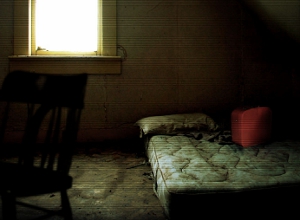
The story, put simply, goes like this. In “Consensus Trance” (the click-and-read interactive section), the adult Carl has just broken up with his girlfriend. The one item he carries away from the breakup is an old red vanity case belonging to his Gran, with whom he used to live when he was a boy. The case contains bits of talismanic bric-a-brac dating back to Carl’s schooldays. Partly because the contents of the case have jogged his memories, Carl attends a school reunion in the hope of catching up with his best schoolfriend, Alex Nightingale. But Alex isn’t there – and furthermore nobody else can remember him. Carl remembers that Alex disappeared unaccountably while he was still at school. He begins to wonder whether Alex actually existed at all, or whether he imagined him; but at the same time he starts to feel as if “ordinary life” might be the illusion, and Alex might have disappeared because he somehow managed to get through to a further reality. He goes back to revisit the flat where Alex used to live.
“Consensus Trance II” picks up from inside the flat’s front door. It takes the form of a 3D “game”, in which we must walk through the passages and rooms of a half-dark flat, discovering fragments of white text as we go, and unlocking extra sections of the flat once a certain number of texts have been discovered. The text-fragments reprise parts of the story which can be found elsewhere, but they also develop the theme that Alex may have disappeared because he managed to get beyond the illusion of everyday life, along with a suggestion that Carl and Alex may be figments of one another’s imagination (many of the text-fragments have Alex’s name in them at one moment and Carl’s at the next), and a third idea that Carl may not be able to remember what happened to Alex because it was something so terrible that he blocked it out of his mind. In the last room of the flat, which has to be unlocked by discovering and “walking through” all the text-fragments elsewhere, this suggestion becomes more concrete: Alex may have tested out his own theories about reality by drinking something poisonous, and therefore he may have disappeared because he killed himself. The process of exploring the half-dark flat thus becomes a metaphor for Carl’s exploration of his own repressed memories, and the fragmentary revelation which awaits us in the last room represents the moment in which he rediscovers his personal nightmare.
The third part of the story, “The Fieldwork Book”, is an old exercise book of Alex’s – or rather a virtual exercise book, apparently recently dug-up, complete with soil-stains, scribbly handwriting, comments in blue from the teacher, doodles, bits of leaf stuck to the pages with sellotape, and woodlice running around on the front cover. It contains the beginnings of a school project about nature – “A dead tree may look lifeless, but actually it’s teeming with activity…” – along with notes from Alex to Carl – “Worthington has paired me up with this mad girl called Joanne. She smokes and stinks but I quite like her.” – and a lot of press cuttings and comments about a computer-game called The Sentinel. All of this makes more sense once the other parts of “Nightingale’s Playground” have been visited, particularly the ebook, which gives a lot of background information about both the Fieldwork Book itself and the Sentinel.
One thing we learn from the ebook section of the story is that The Fieldwork Book is a kind of changeling. Carl buried his science exercise book in the back garden behind his gran’s flat, at Alex’s suggestion, as a way of making it look more grubby and out-of-doors, and thus suggesting to the science teacher that it had been used intensively in the development of the nature project. However, when he dug it up again after Alex’s disappearance, what he discovered was not his own exercise-book but one belonging to Alex.
Another thing we learn is that The Sentinel, to which the Fieldwork Book makes numerous references, is an old Commodore computer-game with which Alex was obsessed. It had 10,000 levels, all based on the same principle: that players had to approach an object called The Sentinel across mountainous terrain without being observed. If they were detected the game would be over. Carl never managed to get very far but Alex managed to get to level 9,999 – and in fact one possible explanation for his disappearance is that it may have had something to do with him reaching level 10,000. He and Carl also played their own outdoor version of The Sentinel, in which Carl would have to stand still while Alex attempted to creep up on him undetected. A copy of The Sentinel is one of the items of bric-a-brac which Carl the adult discovers in his Gran’s old red vanity case.
The ebook also gives some more information about the vanity case itself. When Carl retrieves the Fieldwork Book and finds it to be Alex’s version rather than his own, he hides it in his Gran’s sideboard, and whilst hiding it he discovers something else in there – the red vanity case. The story doesn’t actually tell us in so many words that he looks inside the case, but we gather he must have done, because later on he has a conversation with his Gran, who is telling him that the contents of the case are private and he mustn’t look in there again:
“But what’s that red case? What are those papers?”
“They’re nothing,” she said insistently. “They’re from a long time ago, they don’t make any sense and they’re private love, they’re just private.”
The papers may have something to do with Alex’s death. On the other hand, they may be connected with Carl’s mother, since this is one of the few times in the story when she gets a mention:
…[Gran said] there were things in the world, happenings, that she didn’t understand, and neither would I, and neither would anyone else, and sometimes it was best to just leave them alone.
“Like we leave Mum alone,” I murmured. She didn’t answer that, and looked a little hurt, so I whispered “sorry” and she started talking to me again…
These hints are never developed further.
Nightingale’s Playground is not without its shortcomings. Its most obvious structural weakness is that its four different sections are in four different formats, each with its own distinctive “look” in terms of graphic design, and each needing to be viewed and interacted with in a different way. This is asking a lot of any readers and viewers who are unfamiliar with new media, although it’s actually less of a problem than might be supposed. Once the initial leap of faith has been made the cross-references between the four sections soon start to pull the story together into a surprisingly cohesive single structure. All the same, the fact that two parts are designed to be viewed online, whereas the other two parts are designed to be downloaded onto your own computer (or ereader) does make it a little bit inconvenient to shuttle backwards and forwards between one section and another if you want to examine the story in detail.
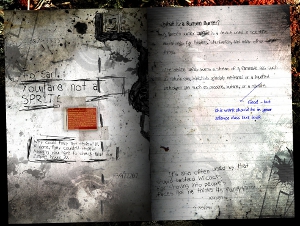
A more serious flaw is the fact that the Fieldwork Book doesn’t actually add very much to our sense of what’s going on. Pretty much all the information it contains (about the Sentinel, and Alex’s view of reality) can be garnered from the other sections, and although reading the Fieldwork Book gives us a slightly stronger sense of Alex’s personality and voice, the material in it begins to seem rather like padding on repeated viewing. There is a similar problem with the red vanity case, which is built up into something of great importance both in the point-and-click narrative section of the story and the ebook. When we actually get to see what’s inside the vanity case, halfway through the point-and-click section, the contents turn out to be rather disappointing.
Campbell does tend to talk up the importance of events and symbolic objects in his stories, rather than leave them to speak for themselves, which can sometimes backfire and lead to a sense of anticlimax. His prose-style can be overblown, a trait which is probably at its most noticeable in the “game” section of the story, where white texts either hang in the air or in some cases appear on the walls of the darkened flat. Some of these texts are particularly sonorous and doomy:
Where were we? Who were we? How much control did we have over the rain coming down, the hideous blank backdrop we were cut and pasted and glued against?
You were onto it, like you were onto something that meant all of this was wrong, some kind of mad illusion; that there was a staggering, amazing psychedelic hope going on that I desperately, weepingly wanted to understand.
I get the feeling everything changed then, like you said words to me that didn’t exist; a language that spoke the impossible; couldn’t be absorbed by the normal brain. Did you even invent some new words? Pierce a new crack in the fabric of what was going on in our limited, messed up world?
“The hideous blank backgrop”; “mad illusion”; “staggering, amazing psychedelic hope”; “desperately, weepingly wanted to understand”; “pierce a new crack in the fabric of what was going on” – the harder these phrases try to impress us, the less they succeed. The trouble is that there isn’t enough concrete observation or information here to convince us that the big emotive adjectives are justified. They seem to be flapping around in a vaccuum.
On the other hand, the ebook section of Nightingale’s Playground contains some of Campbell’s tightest and most effective writing:
Science was my best lesson because Alex was in it – science without Alex was a shitty prospect. I didn’t like any of the other kids in the class, I didn’t like the teacher, I didn’t like doing experiments or doing any work. Science for me was about swapping computer game cassettes under the table, scribbling rude shapes on Alex’s excercise book, whispering about whether the teachers were really aliens trying to brainwash us or whether the entire school was some kind of hologram that folded up and disappeared after the bell for hometime.
This is both convincing about the boredom of being a schoolkid in a dull lesson, and suggestive in terms of the story’s wider themes – the idea that “the entire school was some kind of hologram” clearly links to the alternative-reality theme. The ebook as a whole is written in short punchy sections jumbled into a non-linear sequence, shuttling us backwards and forwards through a term of so or Carl’s school memories, and unfolding (without ever fully explaining) the story of Alex’s disappearance. It works as a stand-alone, but it also works as the glue which holds the entire structure of Nightingale’s Playground together.
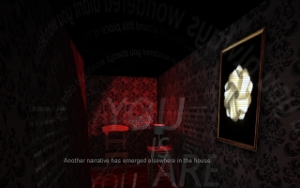
It should also be said that although the flat-exploring section of the story is sometimes overwritten, it is also the most thoroughly immersive of all four parts, and the one where Campbell’s characteristic approach to new media fiction comes into its own most strongly. He has always been at pains not to place his text in front of his images, or beneath them or to one side, like labels on tanks at the zoo or explanatory plaques next to pictures in a gallery; instead he puts his words inside his graphical environments, sometimes hidden or partially-hidden inside them, so that we have to explore to read. This avoids the danger of us regarding the texts as more important than the images. It pulls us in, and it makes his work inherently immersive and interactive.
This characteristic technique is taken a step further in the flat-exploring section of Nightingale’s Playground (which was built with gaming software called Coppercube 2.0), because here the three-dimensional space is deeper, more mazelike and more thoroughly-articulated than Campbell’s customary Flash environments. There is a sinister audio track which changes incrementally as we move from one part of the flat to another, enhancing our sense of three-dimensionality (the audio dimension of Campbell’s environments should not be overlooked in any of his work). The atmosphere is claustrophobic and scary. When you manage to find the right number of texts to unlock an extra section of the flat, there is a loud door-latch click which makes you jump even if you’re expecting it. When you get to the last room of the flat – the one where Carl is starting to get fragmentary recall of Alex’s possible suicide – the space is suddenly bigger, the predominant colour is red, there are items of furniture floating in the middle of the air, the far wall is decorated with a massive staring eye (an icon from the Sentinel game), the text-fragments tend to slide around in front of you as you approach them instead of staying still, and the whole effect is genuinely climactic and nightmarish. There can be no doubt that at moments like this Nightingale’s Playground is an extremely effective piece of new meda fiction.
It’s interesting to note how closely the climax of this flat-exploring sequence resembles Grandma’s house in Tale of Tales’ horror-game The Path. Campbell is an admirer of Tale of Tales’ work, but he hadn’t seen The Path prior to the completion of Nightingale’s Playground. All the same, the parallels are striking: the feeling of combined claustrophobia and disorientation, the sinister red-and-black colouring, the way the reader/viewer is barraged with suggestive fragments, and the way this technique is used to suggest flashbacks. There is a strong sexual theme in The Path which is not present in Nightingale’s Playground, but otherwise it’s difficult to escape the feeling that both Campbell and Tale of Tales have seized upon the exploration of a mazelike game-space as a metaphor for an inner journey, and have developed the metaphor in very similar ways.
Readers who are familiar with Campbell’s earlier work will recognise a number of the themes and motifs employed in Nightingale’s Playground. The Fieldwork Book, for example, is designed in very much the same way as an earlier virtual exercise book from a story called “The Scrapbook”; collections of fragmentary jottings, or old half-corrupted electronic files, can also be found in “Fractured”, “Floppy” and “The Incomplete”; the feverish boy being looked after by his Gran, with his mother either absent or not interested, is a familiar figure from “Dim O’Gauble”; the schoolfriend who introduces the first-person narrator to an apocalyptic secret is an echo of “Capped”; and a gloomy flat which must be explored for clues to the story’s central mystery can also be found in “The Flat”.
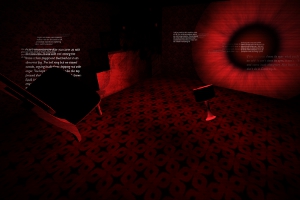
But these narrative strategies in turn suggest certain deeper patterns on which much of Campbell’s work seems to be built. His abiding interest in hints and fragments, for example, is admittedly suited to the nonlinear style of new media literature, but it also serves to suggest that Campbell’s central characters are often living in a reality with two layers: the “ordinary” everyday world which is mean, dull, shoddy and constricting, but relatively safe; and an inner or underlying reality which can only be glimpsed rather than viewed as a whole, possibly because it is so dangerous and frightening – a reality which emerges fitfully via dreams, games, imaginings and doodles.
It also frequently the case in Campbell’s work that the constricted dullness of the “ordinary” world is associated with adult life and adult sensibilities, whereas the “inner” reality is associated with childhood. Thus, in Nightingale’s Playground, the adult narrator starts to rediscover his “real” self when he breaks up with his girlfriend and rediscovers his memories of his best friend Alex. In a way, this could be seen as a Romantic or Wordsworthian view of the relationship between childhood and adulthood: as children we are much more in touch both with our imaginations and our inner selves, and therefore much more aware of the true nature of things, while as adults we become more absorbed in “getting and spending”, and therefore spiritually dull. Campbell is certainly no sentimentalist about childhood – in fact his stories are full of instances of kids being nasty to each other – and it should also be noted that the imaginative insights of the children in his stories may be shared or partially shared by more elderly figures such as the Gran in Nightingale’s Playground, another Gran in Dim O’Gauble, and the dying old man in Last Dream. It may be that these old people share the visionary capabilities of the young by virtue of their closeness to death – there are strong hints in the ebook section of Nightingale’s Playground that Carl’s Nan is about to die of lung cancer.
Perhaps a better literary antecedent for Cambell’s obsessive and visionary kids is the figure of Roland from Alan Garner’s Elidor – another hypersensitive and super-visionary outsider whose insight and talents serve to isolate him both from the mundane world of the Manchester suburb where he lives, and from the other members of his own family who would rather have safe, dull lives than dangerous, eccentric and magical ones. Of course Roland is an outsider-figure who can easily be identified with Alan Garner himself; and in the same way, Alex Nightingale can easily be identified with Campbell. The refusal of these visionary characters to settle for mere ordinary life can be interpreted as an oblique declaration of intent from the artists who created them. But there are other messages here too. The whole structure of Nightingale’s Playground is telling us something about the nature of the world we live in. Did Alex Nightingale actually disappear into an alternative reality, or did he commit suicide? Did Carl imagine Alex, did Alex imagine Carl, or did they both somehow imagine each other? Is the Sentinel just a computer-game or the key to something deeper? What was in the red vanity case when Carl first discovered it? What is the secret his Gran is so anxious to keep hidden? The fact that all of these issues are left hanging, and that the whole pattern of the story is therefore deliberately-unresolved, ambiguous, is a message in itself. Life isn’t clear-cut: it isn’t about answers: it’s about questions.
Nightingale’s Playground has its shortcomings, but it builds Campbell’s open-ended style of narrative into a more ambitious and absorbing structure – and explores some of his characteristic themes with greater maturity and depth – than anything he has produced before.
This review is co-published by The Hyperliterature Exchange and Furtherfield.org.
The four day event at the Showroom collated a series of practitioners, artists, theorists and historians, to examine, test and explore ideas stemming from cybernetics and information theory and more specifically the idea of feedback.
Described as an ‘experimental cross-disciplinary research project’, Signal : Noise was a fusion of talks, lectures, performances, screenings and debates that made diverse contemporary evaluations of the legacy of cybernetics using an inter-disciplinary approach. It tackled subjects as seemingly diverse as economic theory; urbanism and the arrival of the motor car in London; game theory; linguistics; media-performance art from the 1970’s; and the problematic legacies of the recent UK arts funding system on artists – all viewed using the concepts and terminologies of cybernetics and systems.
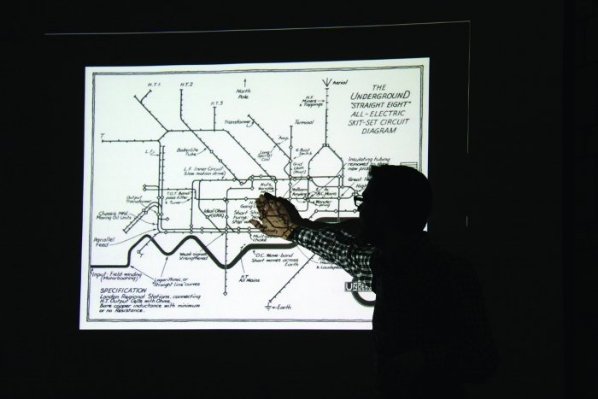
Signal : Noise, in part, played out like a small conference, mainly set in The Showroom Gallery space with one wall covered with a network diagram drawing by Stephen Willats, and fly posted theoretical systems diagrams from his recently re-published 1973 book, or maybe manual, ‘The Artist as Instigator of Changes in Social Cognition and Behaviour’.
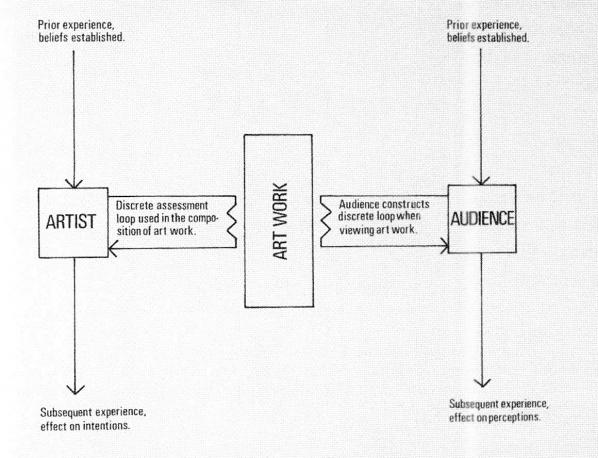
This visual reference served as a backdrop to the proceedings and served as an on going reminder that despite the deep theoretical and historical base being presented and discussed in its many forms, Signal : Noise was ultimately attempting to re ignite debates, and help reset the ideas of cybernetics and systems into a contemporary context of practical application. Willats’ book describes his process as an ‘investigation by the artist into the processes, procedures and models’ of the ‘Art Environment’ using ‘cybernetics as a research tool’.
The first night introductory presentations by Charlie Gere and Steve Rushton provided an overview of many ideas explored throughout the weekend. Artist and writer Steve Rushton on ‘How Media Masters Reality’ used an array of examples, from conceptual and media architecture group Ant Farm using pioneering ideas of investigating media feedback, through to the 500 millions votes (!) on US TV programme American Idol; the latter an example of how contemporary applications of media feedback loops are now often conceptually embedded into the core of television productions, and in turn, are now part of the audiences expectations and involvement.
Ant Farm’s 1975 work ‘The Eternal Frame’, screened later during the weekend, along with Gary Hill’s Why Do Things Always Get in a Muddle (Come on Petunia), based on Gregory Bateson’s Metalogues.
Ant Farm’s 1975 work ‘The Eternal Frame’, screened later during the weekend, was their carefully staged, somewhat trashy live ‘re enactment’ of the 8mm film footage of the Kennedy assassination, complete with a drag version of Jackie Kennedy and sunglass wearing suited security. This film sequence is familiar today, but in 1975 it had yet to reach the public domain. Working to a tightly choreographed moment derived from a bootleg of the 29 seconds of 8mm film, Ant Farm’s grotesque mimicry of the assassination was performed as an ongoing loop, complete with car driving around the block (interestingly, the random people watching in the street in 1975 took photographs like they were at a theme park).
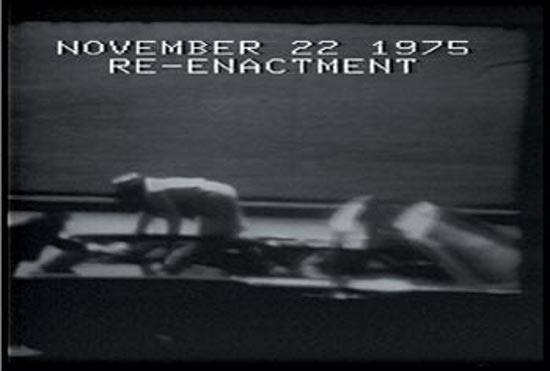

Despite being conceived in the mid ‘70s media environment of portable video and cassettes, the documentation of Ant Farm’s performance resonated with something surprisingly familiar and contemporary in our era of the internet, social media and rolling 24 hour news, and what Rushton termed our “society of self performance”.
Rushton’s historical threads from the origins of Cybernetics and to the Whole Earth Catalogue and the WELL served as a excellent base for the oncoming proceedings of the weekend, and showed that the arrival of the contemporary mass information network in the form of the internet, has habituated it’s millions of users into a kind of cybernetic practice based on input, observation, control, intervention, response, feedback, and adaptation but without necessarily using or being aware of its lexicon.
Nearby, in the Cockpit Theatre, was ‘Closed Circuit’ a performative work by Rod Dickinson (along with Rushton), which consisted of two actors staged and dressed, in a precise duplication of a set for political announcements; wooden lecterns, curtained background, complete with an array of flags – but all carefully neutralized by the removal of logos and national flags identities into plain white.
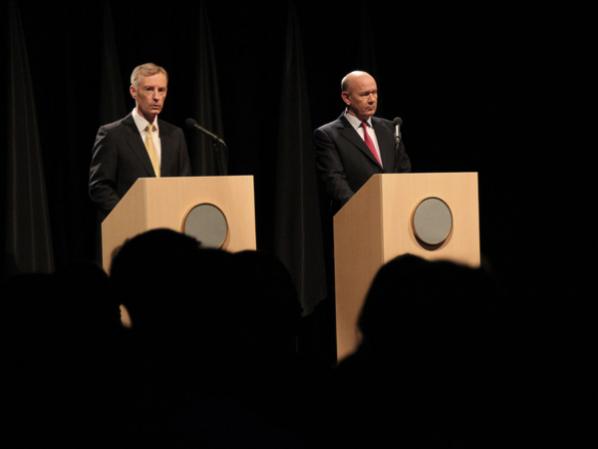
What followed was a series of political speeches utilizing the familiar language and tone of grandeur and crisis, delivered by the actors in the style of a world leader address. What they delivered, was a carefully sequenced remixed script derived from political speeches over the past 50 years; Margaret Thatcher; Richard Nixon; Ronald Reagan; Tony Blair; Yasser Arafat and others. All the details from each specific event they were referring to had been carefully edited out. The only way to differentiate one world leader, country or event from another, were the large projected auto cues for the actors, situated behind the audience at the rear of the theatre. Each one gave the full scrolling speech text and also the year and original context for each leaders’ delivery. Looking towards the stage, it sounded like a single coherent speech, but eluding any specific meaning, isolating the language of threat and authoritarian political control, leaving us just the husk of political presentation and the transparency of the format itself.
Ideas explored in Stephen Willats’ network drawing were expanded further during his talk in the final morning session of Signal : Noise, where he gave a refreshing clarion call to abandon ‘last century thinking’ during his prescient and timely discussion. His seminal works have persistently and methodically challenged the process, structure and meaning of art making and display. Willats made his earliest system diagrams in the late 1950’s, and was the first artist to make the artwork itself a map of communication. But maybe it is this century, rather than our last, that will connect with his provocations to the hierarchical, highly codified, object obsessed ‘Art Environment’, as he terms it, to see that ‘object based thinking is still a hangover from last century attitudes’.
Willats was an early reference for emerging net art and media art in the mid 90’s, with artists then clutching for any art historical roots that gave the field of networked and computer based practice some practical grounding.
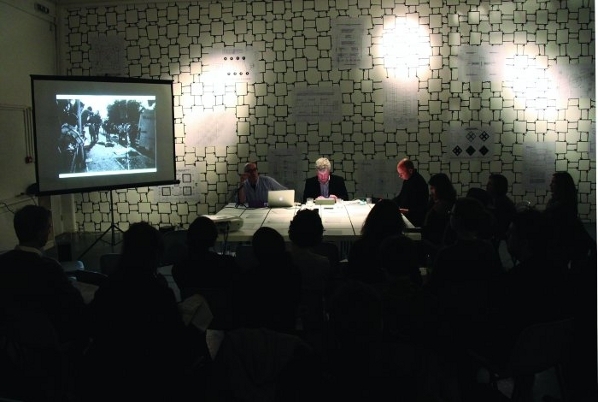
This in-conversation with Emily Pethick surveyed his own personal development and immersion in Cybernetics in its differing stages, a short history lesson, moving from Norbert Weiner to Gregory Bateson and Gordon Pask, but always resolutely en route to the practical issues in the present and what Willats defines as the artist as an ‘instigator of transformation’.
In parallel to Willats, was a presentation and discussion hosted by Emma Smith and Sophie Hope which began to interrogate the legacy of a the New Labour arts commissioning process. It discussed how the criteria for successful funding was intrinsically linked to a social agenda, audience and location set by government policy. Discussions followed about how the arts commissioning process may turn out to have skewed a generation of artists practice, as they slowly lost control of their own output, became tagged with being an ‘artist facilitator’, and began conceiving works to fit in with the criteria of funding bodies, with each funder slowly extending their own prospective reaches. All this supported by an immense drive to build ‘Cultural Industries’ into mechanisms for regeneration.
Seeing this placed against Willats, whose ongoing practice could initially seem in tune with the past decades cultural policies and its overtly prescribed socially engaged agenda, in fact served to show how contrasting, distinct and rich his rigourous thoughtful approach is by comparison.
All this made for a timely discussion. With the approaching withdrawal and decimation of arts funding in the UK, Signal : Noise could prove to be a prescient event. With presentations, workshops and panels by Stuart Bailey and David Reinfurt of Dexter Sinister, Charlie Gere, Matthew Fuller, Marina Vishmidt and others, the interdisciplinary approach of Signal : Noise worked well despite its fairly dense timetable.
Using the gallery as a discursive space, with theorists and writers set within context of practice, is a good base for the next event in this on going series. What it maybe didn’t allow for, which is easily rectified, is a more unpredictable agenda, and more intervention by the ‘audience’. The whole event could function more as a real feedback working system, an adaptable structure that potentially allows for input from its participants (both presenters and audience) letting things move in unexpected directions both on line and offline, leaving a physicalised network as a residue after the event. With the decision to include food and beer in the ticket price (great dumplings, fresh vegetables and miso soup), there is potential here to expand this type of event even further.
With the on coming cultural landscape in the UK moving into un-chartered territory, it is potentially events like Signal : Noise which might begin to unearth and test new ideas and ignite debate within a less rigid format than a ‘curated’ show. In the future this type of event may even re-claim the word ‘radicalise’ from its current narrow, negative media usage, and re-purpose it for artists who decide to reject art market values, in favour of a exploring new ways of working within the emerging (and significantly less funded) ‘Art Environment’.
Signal : Noise. The project was led by Steve Rushton, Dexter Sinister (David Reinfurt and Stuart Bailey), Marina Vishmidt, Rod Dickinson and Emily Pethick. http://www.theshowroom.org/research.html?id=161&mi=254
The Artist as an Instigator of Changes in Social Cognition and Behaviour. 1973. Stephen Willats. http://www.occasionalpapers.org/?page_id=825
Closed Circuit, Rod Dickinson in collaboration with Steve Rushton.
http://www.roddickinson.net/pages/closedcircuit/project-synopsis.php
Dr Charlie Gere. Reader in New Media Research. Department: Lancaster Institute for the Contemporary Arts. http://www.lancs.ac.uk/fass/faculty/profiles/charlie-gere
ANT FARM. ART/ARCHTECTURE/MEDIA [1968-1978]. http://artsites.ucsc.edu/faculty/lord/AntFarm.html
The Eternal Frame by T.R. Uthco and Ant Farm: Doug Hall, Chip Lord, Doug Michels, Jody Procter. 1975, 23:50 min, b&w and color, sound. http://arttorrents.blogspot.com/2008/02/ant-farm-eternal-frame-1976.html
Emma Smith. Social practice that is both research and production based and responds to site-specific issues. http://www.emma-smith.com/www.emma-smith.com/Homeindex.ext.html
Sophie Hope’s work inspects the uncertain relationships between art and society. http://www.welcomebb.org.uk/aboutSophie.html
Brian Eno hovered over me in a darkened room as I squatted writing notes about his 77 Million Paintings on a crumpled up piece of paper. Though I knew he couldn’t see what I was scribbling, its not often one gets the chance to come face-to-face, or rather back-to-face in situ with the flesh and blood incarnation of one’s investigations. He had slipped into the viewing room at the Glenbow Museum unobtrusively because he likes to watch – the audience as well as his “paintings,” and therein lays his strategy and appeal. In a lecture he gave that night at the Museum auditorium he described, in magnificent pantomime, the reactions one has when entering the viewing space of his exhibit:
looking around, furtively glancing at the work
walking further into the space, looking around, glancing at the work
leaning against the wall, glancing at the work
squatting, glancing at the work
sitting down, glancing at the work
focusing on the work, lying down on the floor mesmerized by the work
unable to tear oneself away from the work
77 Million Paintings contains 550 paintings Eno created over a span of 22 years. Since 2006 the exhibit has toured all over the world including Tokyo, Sydney and St. Petersburg before landing in Calgary. The digital projection is a “generative” work in that the ambient music for which Eno is better known, and the combination of images are generated and combined in an endless mandala-like array by a computer. Nine screens project a diamond shape with eight inserted “paintings” and one solid colored square on the lower right hand side serves as a control for the other eight. There are four black leather couches for people to zone out on while enveloped by his signature ambient sounds – and they are packed to capacity as the audience warms and hunkers down to the slow experience.
Originally conceived for in-home viewing, the show seems to change your brain waves from Alpha to Beta to Theta and the experience is pure occipital enjoyment. The cross-fades in the banks of images creep up as the landscape subtly changes as blue morphs into green, and triangles expand into circles As Eno says, “We’re not seeing a film. There’s no beginning, there’s no progression, there’s no end, there’s no narrative, there’s no drama. In fact everything is missing that would normally be called art or entertainment.”
Eno’s lecture at the Glenbow Auditorium could have continued all night but for the protestations of those with day jobs. He began explaining the radical impact Copernicus had in 1543 when he revealed man was no longer the center of the universe, as earth orbited around a system with some 400 million stars. Darwin came along in 1859, and pointed to the phylogenic tree stating there were 20 billion species besides humans. “ We are amazingly minute in this picture,” Eno mused. After Darwin it was Cybernetics, which introduced the notion of feedback as a way to think about complex systems. We cannot control these systems, only set them up to control themselves, and that notion became part of his vocabulary of how things organize themselves.
Starting with royal Kings and the Church, man organized himself in hierarchies from the top down that includes the structure of the 18th Century orchestra, still extant today. Sixty or seventy years ago this would show up in the shape of a top-down pyramid, but the world now functions more as a feedback loop, not a hierarchy. Eno explained when he was growing up his uncle slipped him a book on the artist Mondrian. He found the pictures magical, economical, and transparent. They contained “no subterfuge of technique.” Attending art school at Winchester School of Art, part of a music school in England, his forward thinking art professors invited the composers John Cage, Christian Wolf and Morton Feldman to lecture. Not one musician or music student on campus came to hear them.
He described listening to Terry Riley’s minimalist music composition In C,as “life changing.” That piece contains 53 short, numbered musical phrases lasting from half a beat to 32 beats repeated an arbitrary number of times. He also mentioned Steve Reich’s It’s Gonna Rain, where Reich recorded Brother William, a Pentecostal preacher and “sought to maintain the fascination of the speech content while intensifying its meaning and melody through rhythm.” This piece Eno admitted, “is the basis of most of my career.” He said one’s ears function differently than one’s eyes. Eyes scan all the time. If they don’t scan, they habituate and don’t see any thing. If you have a repetitive event the eyes cease to see, and what he focuses on is the uncommon information, “the out of phase collision of the loops.” This approach makes your brain do the composing. As this he says, has led him to his work ethos, “doing as much as I can with as little as possible.”
—-
Brian Eno’s exhibition 77 Million Paintings takes place in the Glenbow Museum from January 6 to March 20 2011. http://www.glenbow.org/exhibitions/
Editors Ruth Catlow, Marc Garrett, Corrado Morgana.
Digital games are important not only because of their cultural ubiquity or their sales figures but for what they can offer as a space for creative practice. Games are significant for what they embody; human computer interface, notions of agency, sociality, visualisation, cybernetics, representation, embodiment, activism, narrative and play. These and a whole host of other issues are significant not only to the game designer but also present in the work of the artist that thinks and rethinks games. Re-appropriated for activism, activation, commentary and critique within games and culture, artists have responded vigorously.
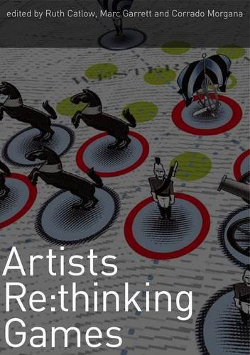
Over the last decade artists have taken the engines and culture of digital games as their tools and materials. In doing so their work has connected with hacker mentalities and a culture of critical mash-up, recalling Situationist practices of the 1950s and 60s and challenging and overturning expected practice.
This publication looks at how a selection of leading artists, designers and commentators have challenged the norms and expectations of both game and art worlds with both criticality and popular appeal. It explores themes adopted by the artist that thinks and rethinks games and includes essays, interviews and artists’ projects from Jeremy Bailey, Ruth Catlow, Heather Corcoran, Daphne Dragona, Mary Flanagan, Mathias Fuchs, Alex Galloway, Marc Garrett, Corrado Morgana, Anne-Marie Schleiner, David Surman, Tale of Tales, Bill Viola, and Emma Westecott.
In collaboration with FACT – http://www.fact.co.uk
http://www.furtherfield.org
http://www.http.uk.net/
Publisher: Liverpool University Press (31 Mar 2010)
Language English
ISBN-10: 1846312477
ISBN-13: 978-1846312472
http://www.amazon.co.uk/gp/offer-listing/1846312477
Form+Code In Design, Art and Architecture
Casey Reas, Chandler McWilliams, LUST
2010, Princeton Architectural Press
ISBN 9781568989372
Form+Code is an art computing programming primer. Rather than teaching any particular programming language it explains the technical and conceptual history of programming and its use in art. Starting with an introduction to the basic concepts of coding, instructions, form, and different ways of representing them (in sections titled “What Is Code?” and “Form And Computers”), it moves on to chapters covering “Repeat”, “Transform”, “Paramaterize”, “Visualize” and “Simulate”.
The basic concepts of programming are explained clearly with plenty of examples of code, hardware, and output. They are also related to broader art history, with examples drawn from conceptual artists such as Yoko Ono and Sol leWitt. And it’s good to see Jasia Reichardt’s pioneering work in bringing art and code together is recognised not just in the form of the Cybernetic Serendipity show at the ICA in London but her books and articles on art computing as well.
There is a little code, enough to give a flavour of what it looks like but not enough to intimidate. Listings in or examples of output from BASIC, LOGO, BEFLIX, Hypertalk and other important historical programming languages are presented. PostScript is given its due, with listings, examples of output and a discussion of its incredible impact on the graphic design industry.
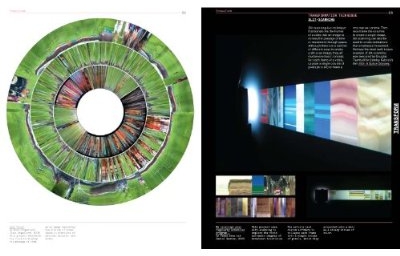
Form+Code is about hardware as well as software. The Difference Engine, ENIAC, oscillioscpes, the PDP-1, arcade games machines that used vector graphics, and the Atari 2600 are all included in a historical narrative of computing and art. The book also describes and shows examples of output from printing hardware from pen plotters through laser printers to CNC and stereo lithography machines, providing a historical and conceptual grounding for thinking about the most advanced output devices currently available.
“Repeat” is explained starting with the Jacquard Loom, and the art of Bridget Riley and Andy Warhol before moving on to variations on a simple BASIC program with illustrations of its output. Packing this amount of historical, computer science and artistic information into each chapter would be overwhelming were it not for the book’s clear writing, structure and design.
“Transform” touches on Holbein’s “Ambassadors” and Victor Vasarely’s Op Art as well as the basic mathematics of folding a piece of paper. “Parameterize” has Dada, Duchamp, the Beats and Calder’s mobiles. It mentions grids without mentioning Rosalind Krauss (the book as a whole is pretty much Theory free), and explains how you use variables to produce variants on the same form.
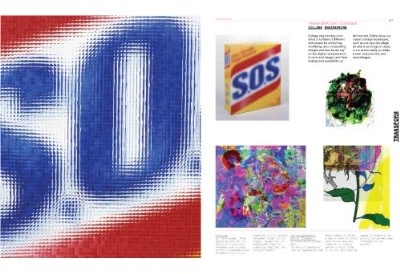
“Visualise” and “Simulate” are almost devoid of (non-computer) art historical examples and cultural context. Harold Cohen’s AARON is illustrated, and Douglas Hofstadter, Richard Dawkins and Stephen Wolfram’s ideas are mentioned. More people should know about the wokr of Hofstadter’s FARG, and the concepts, work and writing presented are still a treasure trove of information and inspiration. But these chapters lack the art historical context of their predecessors.
The contemporary visual art computing presented is mostly in the generative art / data visualisation mold. It’s highly structured, would mostly be impossible to produce without computers, and is haunted by the possibility of being merely decorative. The only academically recognisable critical art included is one of JODI’s less threatening browser pieces. But the example of worldmapper.org in the chapter on visualisation shows how the aesthetic tools of data visualisation can be used politically. And the formal structures and creative strageties of much of the art has a quality of realism in the age of networks that is a challenge to Theory rather than a falure to illustrate it.
The success of books intended to provide a comprehensive foundation in an area of the study of art, such as “Art In Theory” or “Basic Design”, have both helped to enrich the study of art and had the unintended consequence of closing off other possible narratives. Form+Code stands to be as successful in its own area as those books were in theirs, with the same benefits and dangers. Form+Code’s ommission of virtual reality, livecoding, and other movements within art computing are understandable given its focus, but hopefully won’t lead to their neglect by students.
Could you code up any of the software art that you see in the book after reading it? No. The only code listings are historical fragments. But after reading the book you will undestand the concepts that you need both to figure out what more you need to learn in order to program such art and to understand why doing so is aesthetically and art historically worthwhile. And some source code from the book, in various programming languages, is available online.
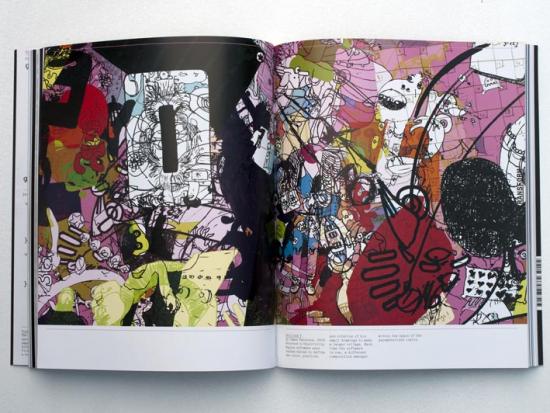
Form+Code’s major achievement is that it presents technical, art historical and technical historical information in such a way that it complements each other and builds a bigger picture that demonstrates the wider relevance and further potential of art computing programming. Having read it, you’ll know more and you’ll both want to and be able to learn how to do more. It’s clearly laid out, packed full of illustrations, occasional code fragments, plenty of references to sources for further investigation, and even has a good index. It really is a foundation course in a book, providing a sound basis for further learning or research.
If you teach art computing, and if you are teaching art, graphic design, textiles, fashion or architecture then you are teaching art computing to a greater or lesser degree, then Form+Code is a perfect primer for the conceptual, historical, and cultural side of computing and art computing. Outside of education, if you are involved in art, computing, or are a non-programmer computer-using artist Form+Code provides a good grounding in the concepts used in programming for art computing.
Form+Code serves as a complete introduction to the conventional history, concepts and practice of visual art computing. It presents that information in the context of the broader history of art and design. And it provides enou